- Skip to main content
- Skip to primary sidebar


Follow Me On

First Timer's Jeju Itinerary (3 Days, With or Without Car)
Updated: Oct 7, 2023 by Max · This post may contain affiliate links · 42 Comments
I’ve just completed my fourth trip to Jeju Island, so I think it's about time I update my itinerary— a lot can & has changed in two years! Originally I wrote this Jeju itinerary to fit all seasons, but I've since added tips for visiting in winter, and for traveling by car or by bus.
I believe that even if you only have a long weekend to explore Jeju, maybe from Seoul or Busan , there's no reason it can't still be fantastic. Both now and during the three years I was teaching English abroad in Korea, Jeju has been by far my favorite weekend getaway.
It's the perfect addition to a Korea itinerary , especially considering how inexpensive the flights are. But n o matter how many chances you have to visit, if you carefully decide on what to do, what to eat, and where to stay in Jeju, then the memories will last a lifetime.
Click here to read about to where to stay in Jeju!
Since this is a truly massive Jeju travel guide, please click around using the table of contents.
- 🛫 Visiting South Korea (Update)
- ⛄ Visiting Jeju Island In Winter
- 🚗 Arrival & Getting Around in Jeju
- 🎒 Where to Stay on Jeju
- 🤔 What to Do in Jeju
- 🍲 What to Eat in Jeju
- 📝 Sample Jeju Itinerary: 3 Days
- 💡 Travel Tips For Jeju Island
- 🔍 Practical Travel Info
- 📋 Jeju Island Travel FAQ
- 🎢 Jeju Attractions Map

🛫 Visiting South Korea (Update)
Those of you looking to visit South Korea are probably as confused by all the changes as I was before I visited again post-covid. But as of March 20th, 2024, masks are still required in medical settings like hospitals but are NO LONGER REQUIRED in all other indoor public places, including public transport.
Here are what document you need to visit Korea as a tourist:
- K-ETA ( Korean Electronic Travel Authorization , applied for at least 72 hours before departure) OR Visa to visit Korea (countries which previously had a visa exemption now need to apply for a K-ETA). From April 1, 2023 to December 31, 2024, passport holders from 22 countries will also temporarily NOT need a K-ETA or visa to visit Korea (includes: Australia, Austria, Belgium, Canada, Denmark, Finland, France, Germany, Hong Kong, Italy, Japan, Macao, Netherlands, New Zealand, Norway, Poland, Singapore, Spain, Sweden, Taiwan, UK, US (including Guam)). If you're a valid ABTC card holder (APEC card), you are not required to apply for a K-ETA [excluding Americans & Canadians].
- Q-Code (can also be filled out upon arrival) : visitors need to fill out information for the Korean quarantine system, known as Q-Code . Note that all travelers are now allowed in regardless of vaccination status, but you do need to have filled out your Q-Code before going through immigration.
If for some reason you need to take a covid test in a South Korea airport, the cost of a covid test in Incheon Airport is currently ₩80,000 ($60USD), with some options within Seoul as inexpensive as ₩65,000 ($50USD). There's no testing requirement to leave South Korea.
Buy a PDF Version of This Post!

⛄ Visiting Jeju Island In Winter
Does it snow on Jeju? How cold does Jeju get in the winter? When is low season on Jeju? So many people have asked me about traveling to Jeju in winter that I decided to add a section on just for that. To answer the overall query: it's totally possible to visit Jeju Island during winter, and Jeju is seriously one of the most underrated places to visit in Korea during winter.
To answer the above questions: yes it snows, it can get as cold as -7C/20F, and winter is low season on Jeju. But no worries, there are plenty of things to do on Jeju , even when the temps hit single digits. Just remember:
- Pack layers, including thin heat tech layers you can remove every time you go inside places. Wintertime on Jeju runs from November to March, though the end of March will see cherry blossoms and can have some very warm days (though still some cold nights).
- Jeju weather is fickle, just like on the Korean peninsula, so in the winter it's possible to have snow anytime, though it is rare outside of December and January. Jeju in December is also really pretty, especially if it's just snowed on Hallasan. Be extra careful when driving.
- On that note, winter activities on Jeju include picking hallabong (Jeju oranges) and gyul (Jeju tangerines), without much other interference. Most things don't close on Jeju in the winter, even Hallasan; you can still hike everywhere, though I wouldn't recommend a beach day.
- Popular things to do on Jeju in winter include: Love Land, the Aquarium, wandering Camellia Hill, and visiting all of Jeju's many museums!
- If you're on Jeju from mid-December to mid-January, definitely check out the Jeju Winter Festival, if only for the street food.
So if you're deciding between Jeju or Busan in winter , I'd suggest heading to Jeju. It's quieter and the flights are more affordable, and so is the food & accommodation. Plus, unlike Busan the snow stays untouched and pristine for quite awhile on Jeju!

🚗 Arrival & Getting Around in Jeju
Transportation in Jeju can be a bit of a mess. Since it's an island, actually getting to Jeju is a relatively simple matter of taking a flight. Note that if you are flying out early from Gimpo Airport, the airport closes each night from 12am-4:30am. Though some people have a fear of flying, and may choose to get to Jeju by ferry .
Either way, once you arrive you will find yourself on the north side of the island, nearly inside Jeju City. It's certainly possible to get around Jeju by public bus or taxi, but not recommended, as the first costs lots of time, and the other costs lots of money.
But for those who hate to drive as much as I do, I've also shared tips below on how to get around Jeju by bus. As for the infamous tour packages that most Koreans seem to favor, the jury is still out on that one.
I've experienced some amazing tours in South Korea, but it certainly limits what you see and how much time you spend there. The best option by far is to rent a car, or bring your own over on the ferry from the mainland.
I've gotten around Jeju by tour bus, public bus lines, and driving a rental car. There's no metro or train system on the island, though there are ferries. So if you choose not to or simply can't rent a car on Jeju, you're left with the bus.

Traveling Jeju By Bus
As I've said, this is not my favorite option, but it's doable. If you travel Jeju by bus, you'll want to stay along the coast so you're no more than two buses from where you want to go. I recommend staying in Seogwipo, so that you can follow the itinerary below.
Your favorite bus line on Jeju will be the 201, which takes you in a ring around the island. The scene along the coast is particularly gorgeous from April to June. For your initial arrival, Jeju airport limousine bus 800 and 800-1 will take you from the airport to Seogwipo the most directly, with buses every 15 minutes between 6am-10pm daily.
Most of the bus routes stop running just before 10pm. If you arrive after 10pm, I'd recommend staying in Jeju City for the first night; you can take the 3000's lines to a few different places, but those also stop at 12am. Taxis will always be waiting to take you somewhere, but the lines are always long at night.
Introducing the T-Money card, a transportation card like no other. Mine was attached to my credit card while I lived in Korea, but you can also get one at any of the convenience stores in Korea. You can use your T-Money card to get all around the island, even in most taxis (but always bring cash just in case).
Most fares will be ₩1250 (~$1USD) each way, though the cost of taxis depends completely upon distance. Be sure to download the Naver Maps app before arrival so that you can get bus route info immediately.
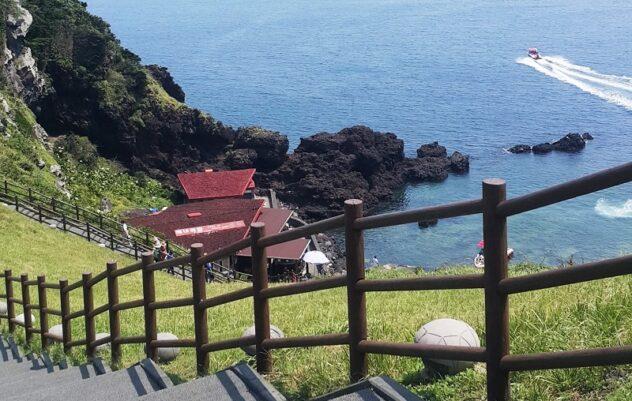
Driving in Jeju
Driving in Jeju is quite safe, with lots of open roads and several paths across the island in addition to the loop around it. A self-drive in Jeju is also the best way to see the beauty of the island's countryside vistas, stay flexible with plans in case of weather interruptions, and stay in cheaper hotels if budget is an issue.
The only requirements to rent a car in Jeju is a license in your home country and an international license (which is applied & paid for separately, almost always before you arrive to South Korea).
Koreans drive on the right hand side of the road, just as they do in the US and most of the rest of the world. Driving in Jeju City isn't very challenging, though going into more rural parts can be challenging since the roads narrow quite a bit.
Your Korean GPS will give you numerous speed warnings every time you're approaching speed cameras (so you have no excuse for getting a ticket!), so don't freak out when it chirps and beeps at you a lot.For a car rental, Jeju Island is one of the easiest spots I've ever rented in.
We just followed the signs in the airport, took the shuttle to Lotte Rental Cars, pulled a number for help in English, and we were in our car within 15 minutes. That was on a public holiday, too! Rental Car places are called " ren-ta-ca ," so try saying that if nobody seems to be able to help you in English.
Having a car on Jeju got us to about twice as many sites across the island, not to mentioned allows you to rent a scooter on Udo Island (if that's your kind of thing).
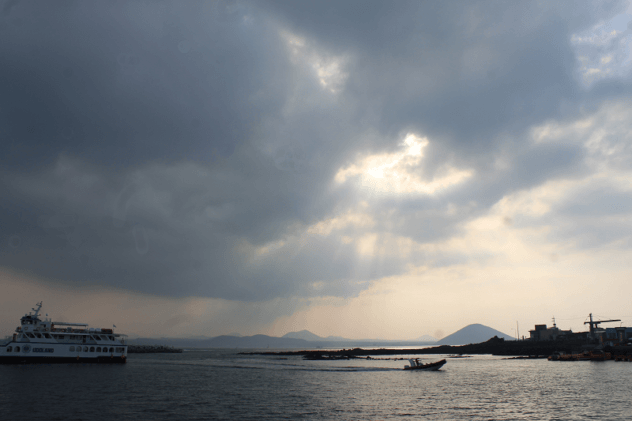
🎒 Where to Stay on Jeju
Choosing where to stay on Jeju Island may not seem like as big a decision as it actually is. Jeju is by no means small, but it is of a manageable enough size that you could spend one night in each part of the island and still see everything you're interested in.
Yet most people wouldn't choose to change accommodation every night if they don't have to. So in this post I narrowed it down to the four best regions in which to base yourself, and a different spot for every budget and comfort level.
If you're unsure of where to stay at all, or just have a day or two, then I highly recommend you stick to the transportation hub of Jeju City. If you're spending at least 3 days on Jeju, consider splitting up your accommodation and staying in two different parts of the island.
If you follow my sample Jeju itinerary below, it would be best to stay near Udo Island on the first night, and then in Seogwipo for the last 2 nights. I know that all the place names can be confusing, so I made a map of Jeju attractions that goes along with the 3 day Jeju itinerary below. Click here to scroll to it now.
Click here to see reviews of Jeju accomodation on Agoda.
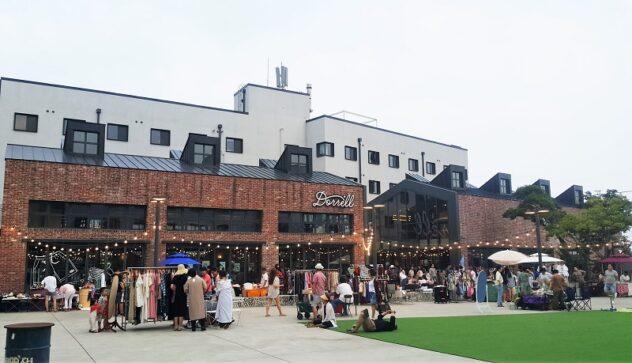
🤔 What to Do in Jeju
Jeju has innumerable sites that involve the sea and nature, including 3 UNESCO World Heritage Sites. But the island has its fair share of quirk and Korean tradition (naked hot tubs, anyone?). This list could seriously go on for hours if I listed out everything that locals do for fun.
So to stick to the more accessible stuff for 3 days in Jeju, I'll share just the weird, the natural, and the educational, divided by region. Don't forget to carry around a few extra thousand-won notes to pay for parking!
Surprisingly, I found the points of interest in Jeju to be more accessible than those in Seoul or Busan. Most everything was available in Korean, English and Chinese, and many more people were able to speak English than I expected.
So don't shy away from something that sounds interesting, just because it looks rural. Looks can be deceiving, and Jeju Island is the land of things-built-only-as-tourist-attractions.
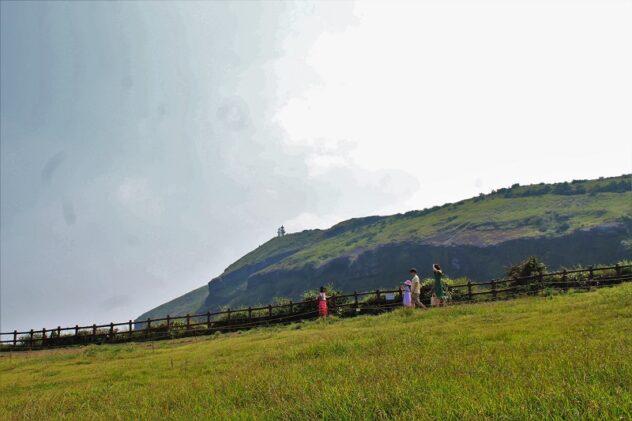
Love Land (erotic museum) /// ₩9000 entrance /// 9am-midnight daily
Love Land is a very blasé name for this unusual park full of penises and other erotic sculptures. It was actually opened in 2004 by a group of art students from Seoul's Hongik University (of 'Hongdae' fame). Please note that you must be at least 19 to enter the park .
Hallasan Hiking /// free /// roughly sunrise to sunset
It's tough to designate a specific starting point to hike Hallasan, considering that it's at the center of the island. Hallasan is actually an active volcano, though it ' spews no lava or smoke at the moment, and it's the reason why Jeju island exists at all. T 's safe to hike, and t he views from the top are unforgettable .
Note that it is not safe to Hike Hallasan in the rain and that you should bring extra layers no matter the weather when you start.
Orange Picking Experience /// ₩3000-₩6000 /// usually 8am-6pm
With peak orange season from November to February, orange picking is a winter activity on Jeju that most everyone participates in, local or tourist. You pay a flat fee per person to pick and eat as many oranges as you want & bring home a kilogram.
Manjanggul (lava cave) /// ₩3000 entrance /// 9am-6pm daily (closed first Wednesday of every month)
As one of Jeju's 3 UNESCO World Heritage sites, the 1,000 meters of cave open to the public gets quite packed on weekends. The slippery floors can become extra hazardous, so bring grippy shoes and plan to spend about an hour exploring the cave and surrounding property.
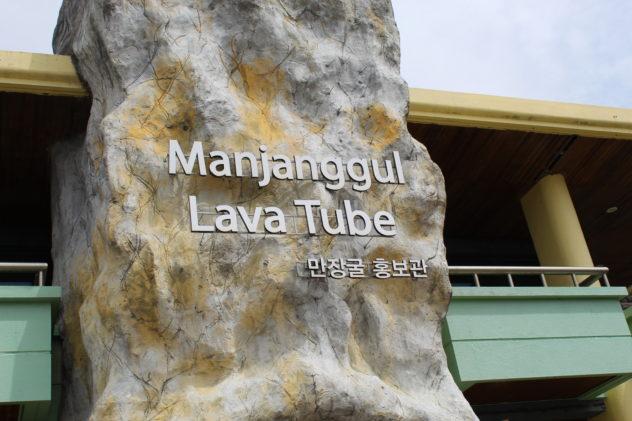
Jeongbang Waterfall /// ₩2000 entrance /// 8am-6pm
Jeongbang's claim to fame is as the only waterfall in Asia to fall directly into the ocean, which is honestly really cool sight. There's also a tiny beach in front of it, just before the vast ocean extending way beyond. The walk down is worth it in nice weather, but can be a bit treacherous in rain or snow.
Olle Trails (Oedolgae Rock) /// free /// roughly sunrise to sunset
A rock may not sound like a very impressive attraction, but this stunning viewpoint is the perfect spot from which to admire the ocean & the many small islands off the coast of this side of Jeju-do. Many people come here each day just to trek the well-trod trails and stop at a lookout every once in awhile to soak it all in.
Jusangjeolli Lava Cliffs /// ₩2000 entrance /// roughly sunrise to sunset
Often compared to the Giant's Causeway in Northern Island, the Jusangjeolli cliff faces are another act of nature bestowed upon Jeju by the volcano that formed its body. Easily less than 5 minutes from the parking lot, the cliffs are deep grey rectangular and square formations which jut picturesquely out into the ocean.

Jeju Folk Village (Jeju Minsokchon) /// ₩11000 /// 8:30am-5pm or 6pm (spring & summer)
Jeju Island is the land of the unexpected, and on my last trip I ended up in this tiny mountainous village for lunch, in an area I later learned was called Minsokchon . The traditional Jeju Folk Village appears as if it had sprung out of the mountains, populated with short, flat-rooved structures which recall traditional living on the island.
Aqua Planet Jeju /// ₩37200-₩40900 /// 10am-7pm
If you're visiting Jeju with kids, this is a must-see. This massive aquarium has not only penguins and sea lions, but whale sharks. They offer daily demonstrations and educational programs about the animals (in Korean), while all of the aquatic animals found around Jeju are in their large main building (with English signage).
Seopjikoji (scenic view point) /// free /// roughly sunrise to sunset
Just across from Seongsan is Seopjikoji, an area famous for being the filming location for several dramas and a gorgeous area, to boot. The draw here is the defined walking trail along the cliffs and a beach side restaurant, though the most gorgeous scenes are when the canola flowers bloom in the spring .

Submarine Ride to & from Udo /// ₩36000-₩55000 /// departing 8:55am-4:30pm
This is not a cheap activity, but it is one that you'd be hard-pressed to find anywhere else. Jeju is famous not only for its women divers, but also for its scuba diving. Children of all ages are able to experience the beauty of the ocean, without the need to swim in it.
Explore Udo /// ₩10.500 (same-day round trip ferry) /// 7:30/8am-⅚:30pm (varies by season)
Despite the fact that Jeju has become famous for their black pork, Udo Island is actually named for a cow, which the island is said to be shaped like. Like the rest of Jeju, Udo is know for its great views and it's beaches, but unlike the rest of Jeju, Udo has a special dessert: peanut ice cream.
Seongsan Ilchulbong (sunrise peak) /// ₩2000 /// Summer 7:10am-7pm & Winter 7:30am-6pm
The immensity of the green and the brightly colored flowers that greet you here in the spring could very well distract you from ever climbing to the top. This fairy tale mountain was formed long ago by a volcanic eruption, just like the rest of Jeju , and is great for a quick hike, and horseback riding and boating for a bit extra.
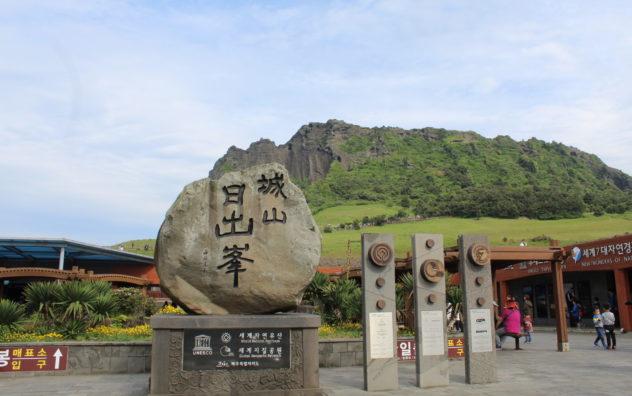
Western Jeju-do
The Chocolate Museum /// ₩6000 /// 10am-6pm
Built to resemble a castle, this massive museum is actually the second-largest chocolate museum in the world, behind the one in Cologne, Germany. Its exterior is covered in a volcanic landscape inspired by the island, while the inside smells as if it were coated in chocolate.
There are exhibits on chocolate history and chocolate making, as well as a cafe and a sales area where you can buy boxes of the sweet stuff. It's a chocolate lover's paradise, but I'll also admit that I've seen better . Note that the Jeju chocolate museum closes an hour early in winter and an hour late in summer.
Sanbangsan Carbonate Springs /// ₩12000 base entrance /// 6am-midnight (indoor hot springs)
This will be one of the strangest experiences of your life if you've never been to a Korean sauna. Everybody here is naked, albeit separated by gender. The hot springs, glorified swimming pools in many ways, are available in a variety of temperatures and with various healing properties.
O'Sulloc Tea Fields & Museum /// free /// 9am-6pm
Being a tiny museum near a massive tea field, I wouldn't expect much in the way of tea education. But if you came for the green tea products, then this is your spot. The small museum is attached to a massive cafe serving up a variety of teas from their farm, plus coffee and desserts , with an Innis Free cosmetics store a hundred meters away .
The best part for most people will be the tea plantation itself, however, which is situated across the street from the museum and simply laden with photo-ops. There are honestly so many things to do in Jeju , but it's all so different that it's unlikely that everything will appeal to you.
So just pick your favorites in each area, and then move on to the next one.

🍲 What to Eat in Jeju
Confession time: despite being a food blogger, I don't center my schedule around meals. I might center the occasional day around dessert for dinner, but for the most part, I carry my chocolate & some almonds in my bag and like to see where the wind takes me.
It's how I travel anywhere, so it's not really fair of me to recommend you any specific restaurants around which to plan your day. However, I freely offer food recommendations, and the must-try foods on Jeju are...
- Sannakji ("live" octopus)
- Abalone (Sea Snails)
- Green Tea Anything
- Hallabong (those big oranges grown throughout the island)
- Peanut Latte
- Jeju Chocolate
Bonus: many local friends told me that Jeju is known for their Indian food, so if you're feeling some international fare, consider going out for Indian food in Jeju (see travel tips below).

📝 Sample Jeju Itinerary: 3 Days
3 days is enough to see the major sites of Jeju, so on the map I've outlined where to go for each day. This assumes that you can arrive at the first spot around 9am, and will be tired enough for dinner and relaxation around 7pm.
If this sounds like you, this may be your perfect Jeju itinerary. 3 days may not be enough for some, but never fear— not everything will appeal to you, and this is easy enough to remove stuff from or add to. You can read more about each site above.
At the bottom of the page is a map of the island, with all of these points of interest marked off. Proceed at your leisure.
Jeju Itinerary Day 1
9am // Manjanggul : If you're traveling by bus, skip to the next stop, as you won't have time for this part. Start out the day at the lava caves, a kilometer of dark, firey history, and a look into how the island was formed. You can only explore the first 1000 meters of the more than 13,000 formed.
B ut the multi-lingual signage will explain how rivers of lava burst from the earth and tunnel upwards to form the basis of modern-day Jeju Island. It's chilly down there, so bring a jacket. This can be done either first or last, depending on your starting point, but remember that they close at 6pm.
10am // Udo : The first ferry to this island is not particularly early, but they can get packed on weekends. If you're visiting on a Saturday or Sunday, be prepared to wait a bit for the next ferry, and don't forget to buy round trip tickets.
It's only a 15-minute ride, so once you're on the island, head straight from the ferry terminal to Udo Seobin Baeksa , a gorgeous beach just a 10-minute walk from the port.
Once you're there, grab some peanut ice cream and walk along the beach. Other things to do on Udo are: rent bikes to ride around the island, watch locals dive in the ocean, go horseback riding, grab a coffee on the pier, and hike Udobong. I highly recommend having black pork burgers for lunch.
4pm // Seopjikoji or Seongsan Ilchulbong at sunset : Once you've returned from your half day on Udo, head just a few kilometers down the road to the beautiful look out point of Seopjikoji.
If you don't go now, I'm afraid you'll be too tired to go at the end of the day, so just muster up the will power to see one more beautiful site, if only from just a wee bit closer up. Alternatively, even closer by is Seongsan Ilchulbong.
Walking around Seongsan Ilchulbong, I swear you'll think you're walking into a scene straight from the highlands of Northern Ireland. Seongsan Ilchulbong is one of Jeju's UNESCO World Heritage sites, and you'll immediately understand why.
Two hours is just enough to walk around and take pictures, observe the famous women divers of Jeju, maybe take a boat ride, and hike to the top of the small mountain. Going later in the day also allows you to look around without the mid-day sun glaring in your eyes, and with many fewer people.
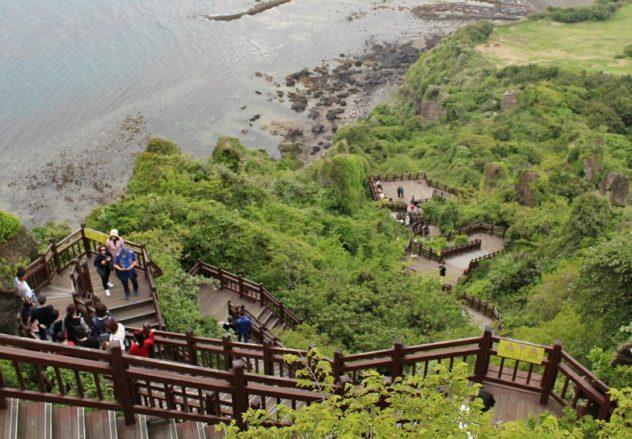
Jeju Itinerary Day 2
9am // Jeongbang Waterfall : Literally a one minute walk to the falls (& the ocean), and another few minutes for the close-up view, this is a perfect first stop for day 2. If your legs are sore from the day before there's no need to go down for a closer look, and there's a coffee shop right in the parking lot, should you need it.
10am // Oedolgae Rock : Just like with the waterfall, this can be a more or less involved part of your trip. If it's raining or you're tired, then just walk over to where the view point is and admire the gorgeous natural scenery. Trekking is available here, however, and is quite possible. It can get rather crowded here on nice weekend afternoons, so head over before lunch.
11am // Jusangjeolli Lava Cliffs : If you're traveling by bus, skip to having lunch, as you won't have time for this part. Unlike the lava caves you (may have) visited yesterday, these cliffs are a spectacular representation of what happens after the lava shoots out of the earth.
Looking just like the legos you played with as a kid, these lava tubes are a wonderful photo-op for any kind of traveler.
11:30am // Lunch Time : Most people's favorite time of day. Head into downtown Seogwipo and look around for a barbeque restaurant that served black pork, and ask for samgyeopsal .
This is pork belly, and they'll bring it out in long strips that look like thick-cut bacon, and you can thank me later. Don't worry, all the side dishes they bring out are included in the price of the meat. Note that the more side dishes, the more respect they're showing you.
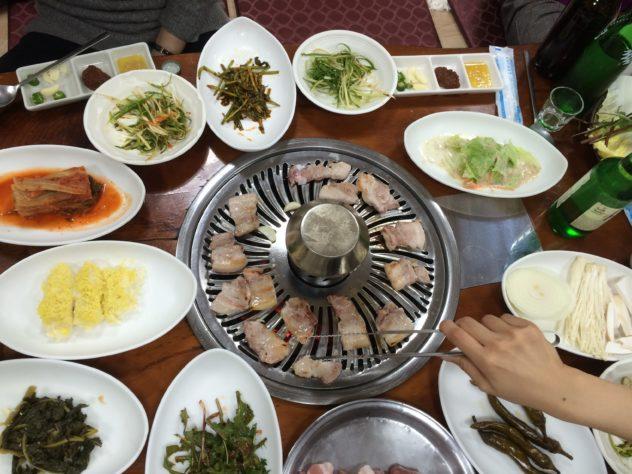
1pm // Chocolate Museum : If you're traveling by bus , you should choose 2 of the 3 activities left today. After a nice hearty meal, it's time for some dessert! Once you get over the immense grounds of this castle-like factory, head inside and learn all about how chocolate is made , and some history about chocolate (plus free samples).
Kids and adults are all huge fans of the delightful aroma and variety of samples on offer, as well as the reasonably-priced gifts in the shop, though it's definitely more of an introductory-level chocolate experience.
3pm // Green Tea Fields : Once you manage to drag yourself away from the chocolate factory, make the short drive over to the green tea fields. O'Sulloc's tea plantation is famous throughout Korea for its quality tea (despite the name, the plantation produces a number of different teas from this one variety).
But if you're still full from the pigging out and the chocolate, then work off the calories by strolling around the endless fields of green. Peak season in from April to June.
6pm // Love Land : If by some miracle you're still able to take in more sites, I highly recommend Love Land. It is Korea's only Adult Theme Park, though I think of it as more of an erotic photo zone. However, it's also open until midnight.
So if you're traveling with kids, I'd recommend grabbing dinner first and then leaving them in the hotel for a movie while you get your adulting on in the erotic theme park you never knew you would see.
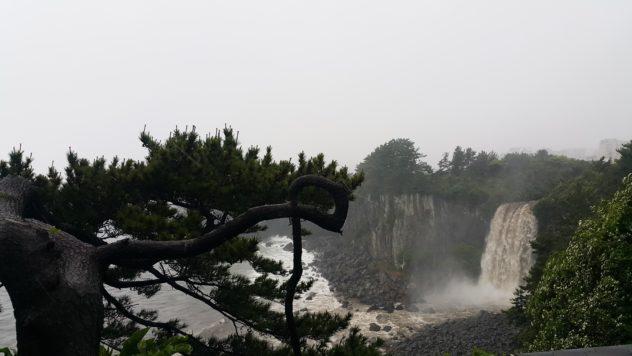
Jeju Itinerary Day 3
9am // Hike Hallasan : I hope you're not still sore from walking around the day before yesterday, because today is hiking day! Sort of. Mount Halla actually has 5 trails, and each is vastly different from the others. One of them only takes half an hour each way, though you don't see much.
The route that starts at Eorimok Trail and returns down Yeongsil Trail is rightfully the most popular, however. This trip take about 5 hours total, so be sure to bring water bottles and snacks. If you're using public transport, bus 740 heads to Eorimok and stops by Yeongsil, as well.
2pm // Late Lunch : After all that exertion, it's only right to grab some nice warm soup to re-hydrate. Stop in at any of the many local restaurants at the bottom of the trail head, or head towards the hot springs and eat closer to there (though there aren't any restaurants right around the springs).
3pm // Sanbangsan Carbonate Springs : This was honestly one of the weirdest and one of my favorite parts of Jeju. There are saunas and jjimjilbangs everywhere in Korea, but outdoor hot springs or pools are much harder to find.
Especially good for relaxing your muscles after a hike and challenging your definition of too many naked people, the Sanbangsan Carbonate Springs are heavenly. You can pay the extra ₩3000 for access to the outdoor pools and hang out with your significant other.
Alternately, you can just stay in the cocoon of warmth inside, scrubbing off all the dead skin once you've had enough. General relaxation is a great theme for your last night on Jeju. Now that you have an idea of what the island has to offer, you're just about ready for your trip to Jeju Island.
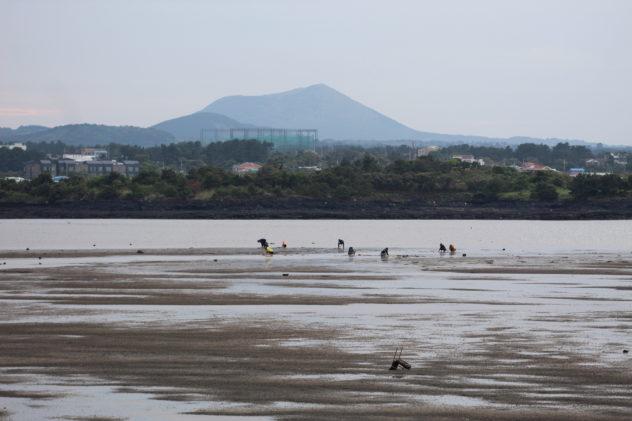
💡 Travel Tips For Jeju Island
- Get a sim card with calling capabilities . I literally lived in Korea for three years using only a pre-paid sim card from Olleh. That cost me ₩20000 (~$17USD) a month for 2GB of data, and another few thousand a month for calling, and it saved me many times over the years to have someone be able to call a hotel or taxi for me using my own phone.
- Speaking of calling, the Korea Travel Hotline , known to expats as the "English Help Line," should be your go-to with any issue. Simply dial 1330 and press 1 for English, and you'll be connected to someone at any hour of the day, any day of the week. They can help with ticket prices, bus schedules, attraction locations, and even translating for taxi drivers. They also speak Japanese and Chinese.
- Rent a car (remember your international driver's license!). If my helpful info on renting a car in Jeju wasn't enough convincing, keep in mind that most attractions are far from cities and far apart. Taxis can also be hard or impossible to come by after 10pm (coincidentally, also when most of the buses stop running).
- Travel the island in sections . Take a careful look at attractions' opening hours & days, because even though the island appears small at first, it can be a very long drive to backtrack to somewhere you've already been, just to see that one museum.
- It does get very cold in the winter , so pack a heavy winter coat from November-March, and a light jacket in October and April. While you could have some less cold days in the winter, it can get downright freezing in January and February.
- Just as in the rest of Korea, Google Maps isn't useful or detailed on Jeju, so do remember to download the English-language version of Naver Maps , the Korean map app.
- Try Indian food — no, seriously. Jeju has a small but sizable Indian population, and along with that, some bomb-a*s Indian food.
- Beaches close for winter , at least for swimming. Just like in the rest of Korea, from September to May you're not allowed to swim in the water around Jeju, though you can certainly still walk along the beach and take pictures. This is for safety reasons, as that water is frigid .
- Jeju has a decent salsa dance scene, but don't come here for the nightlife . Since it's mostly a family holiday and honeymoon destination, there aren't many clubs and there are few bars in Jeju City and Seogwipo. You'll have more luck finding a noraebang (Korean Karaoke bar) to sing it up in after dark (and karaoke is definitely wirth adding to you Jeju Island itinerary !) .
- Speaking of early nights, try to start your day early . Lots of attractions open around 8am or 9am, and close around 5pm or 6pm; the last ferry from Udo Islandcomes back before 7pm, so after sunset there's not much to do but sleep and set your alarm for the sunrise.
🔍 Practical Travel Info
Language: Korean people speak Korean, and most of those who work in tourism will speak a little English. Often someone will also speak some Japanese and Mandarin, while outside of tourist areas you'll have the best luck finding English-speaking young people.
There's also a strong regional accent on Jeju, so even if you speak Korean you may have trouble understanding older people.
Population: ~600,000 people.
Currency: the Korean won (KRW), written as either ₩ or 원 (in Korean). 1000 won is equal to about $0.85USD or ₱42.
Korea Visa: While there are still 112 countries whose citizens don’t need to apply for visas before visiting Korea for 30 to 90 days, as of September 2021, ALL visitors from those approved countries still need to have an approved K-ETA before arriving in Korea. K-ETA stands for Korea-Electronic Travel Authorization.
You can check if yours is one of those visa-exempt, countries and how long your visa lasts for, here . Common countries: USA (up to 90 days), Canada (up to 6 months), South Africa (up to 30 days), Malaysia (up to 90 days), Singapore (up to 90 days). But remember, even if you don’t need to apply for a visa, from now on you do still need to apply for a K-ETA , which is good for two years form the date of approval.
Voltage: 220v/60Hz, with two round holes for the plug (type F).
Best Time to Visit Jeju
There's really no bad time to visit Jeju, since the weather on the island is so much milder compared to the mainland. But summer is definitely peak season, with mid-July to the end of August seeing the most visitors (when kids are off school). The best month to visit Jeju Island, and Korea in general, is in May.
Spring and Fall are my favorite times because the prices are a bit cheaper, the weather is still mild, and there are colors popping everywhere. Since most people come to Jeju for just 3 or 4 days at a time, flights are much cheaper to arrive Sunday through Wednesday & depart Wednesday, Thursday or Saturday .

Safety Level: 10/10
Because this is Jeju Island , there's really nowhere for criminals to hide. That said, just like the rest of Korea, Jeju is just generally a very safe place to explore. The entire country outlaws guns, except for the military, and the crime rate is extremely low. There aren't any dangerous parts of Jeju, either, unless you count those really tall cliffs people like to hike up to.
Sample Jeju Budget: 3 Days
This Jeju travel budget assumes you're spending 3 nights on the island, and are traveling alone using the guide above. These prices will lower a bit per person as you share the cost of a rental car. If you travel by bus & taxi combined, you'd travel slower, but spend more like $10-20 a day per person. Note that the current exchange rate is roughly 1200KRW per 1USD.
- Lodging : $70USD
- Transport : $60USD (flights are so varied in cost that those are not included in this budget, and neither is the cost of a rental car )
- Activities : $50USD
- Food : $70USD
Total : $250USD

Basic Korean Lesson
So you're all ready for your trip, but you don't know any Korean! So let's consider the language barrier. I don't discuss it much on this site, but for a native English speaker, Korean is one of the harder languages to learn. Lucky for you, I've already broken down this barrier several times over.
So to help you prepare for your trip, I've compiled a shortlist to help you order food and just be generally polite. Many Koreans speak enough English to understand your order in a restaurant, but it's always polite to throw in a little Korean.
If you get beyond ordering food in a restaurant, the language barrier only gets more obvious. I'd also highly recommend downloading a picture-capable translation app before you go, like Google Translate.
Hello // An-nyeong-ha-se-yo . (안녕하세요.)
I don’t speak any Korean. // Han-guk-aw jal-moat-hae-yo. (한국어 잘못해요.)
Do you speak English? // Yeong-aw jal-hae-yo? (영어 잘해요?)
Thank you // Gam-saahm-ni-da . (감사합니다.)
How much is it? // Eol-ma-yeh-yo? (얼마예요?)
One of these, please. // Ee-gaw ha-na ju-say-yo. (이거 하나 주세요.)
It's to-go/takeout. // Po-jahng ee-eh-yo or Tay-kow-shi-yay-oh. (포장 이예요.)
Lesson complete! Now let's pack.
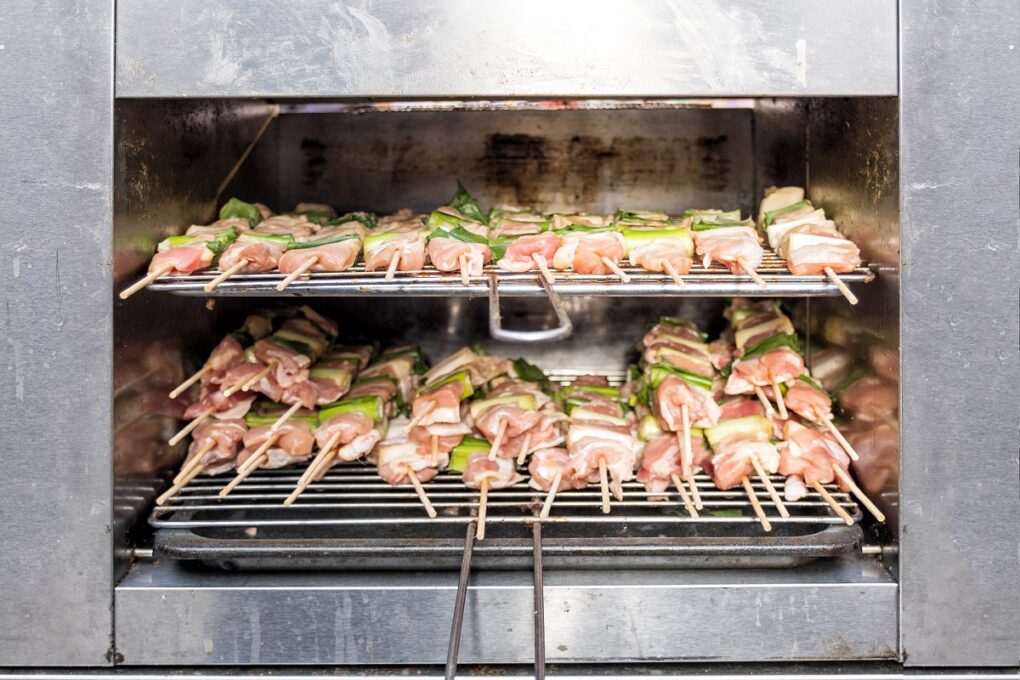
📋 Jeju Island Travel FAQ
When deciding how many days to spend in Jeju Island, you could spend as little as 2 days in Jeju and see most of the top sights, but most visitors find 3-4 days to be ideal.
The best months to visit Jeju Island are April, May, and September, due to the open hours of attractions and lack of crowds, but still beautiful weather and reasonable prices on hotels.
Yes! Jeju Island is absolutely worth a visit, and quite beautiful at any time of year, but particularly in the spring and fall.
When figuring out how to get to Jeju Island from Seoul, there are three options, one of which is markedly more appealing than the other two: by plane. You can also take a train and then a ferry or a bus and then a ferry, but since Seoul to Jeju and vice versa is actually the most-traveled route in the world, there's no shortage of cheap flights to Jeju from Seoul.
🎢 Jeju Attractions Map
More South Korea Travel & Life

Reader Interactions
Roxane Cordisco
February 17, 2024 at 9:35 am
Thanks for this nice article about Jeju. I am planning a 7-10 day trip to the island and I'd like to discover it by myself by scooter. Do you have any information about scooter rental agencies in Jeju? Thank you! Roxane (Belgium)
February 19, 2024 at 1:48 pm
Sorry, Roxane; I'm not very familiar with renting scooters on the island and haven't yet done so myself, but enjoy your trip & I hope you can find the info you need before heaidng out!
Danielle Ziss
February 06, 2024 at 2:11 pm
Wow - what a thorough post! Really appreciate you. Heading to Jeju in early March for 3 days. So excited!
February 06, 2024 at 2:18 pm
Thank you for the kind words!! Enjoy your trip, Danielle!
January 01, 2024 at 8:14 am
Bedankt Max voor je duidelijke en interessante reisgids voor Jeju. Wij zijn momenteel onze reis aan 't plannen voor de komende lente. Onze dochter van 19 is van sep 2023 tot mei 2024 in Seoul om Koreaans te studeren (Education First). Wij gaan met onze zoon van 22 naar Korea van 22 maart tot 9 april. Eerst gaan we naar Seoul, maar we willen zeker ook naar Jeju en Busan. Kan je ons ook helpen met tips voor Seoul en Busan en eventueel andere plaatsen die zeker de moeite zijn in onze trip? Alvast bedankt!
January 04, 2024 at 1:31 pm
Graag gedaan! Het spijt me, ik spreek geen Nederlands, dus ik gebruik Google Translate. Er zijn gidsen voor Busan hier en voor Seoul hier . Maar waarschijnlijk wil je de Korea-reisroute lezen, die lijkt op een minigids voor Zuid-Korea.
Als u de site wilt ondersteunen, kunt u ook pdf's van alle gidsen kopen om mee te nemen op uw reis (u kunt ze afdrukken of op uw telefoon bewaren).
September 10, 2023 at 5:54 am
Thank you for this post! Really helped with my planning by the different regions. I was just wondering, if it would be safe drive during Winter (late dec)?
September 10, 2023 at 8:08 pm
My pleasure, Isabelle! And yes, it would be perfectly safe as it very rarely gets even close to snowing on Jeju (maybe once a decade it flurries).
Leave a Reply Cancel reply
Your email address will not be published. Required fields are marked *
This site uses Akismet to reduce spam. Learn how your comment data is processed .
- South Korea
- When Is The Best Time...
When Is the Best Time of Year To Visit Jeju?

With four very distinct seasons, Jeju has plenty to offer visitors at any time of year. So when is the best time for your trip? Let this month-by-month guide help you decide.
Greet the new year in january at seongsan sunrise peak.
Koreans welcome the New Year by watching its first sunrise; this tradition is believed to bring luck for the coming 12 months. Jeju’s most popular place to see in the new dawn is Seongsan Ilchulbong – also known as Sunrise Peak. At the top of the mountain, Seongsan Sunrise Festival entertains crowds of people with traditional performances, fireworks, a campfire and music from famous entertainers. While the highlight of the festival is sunrise itself, celebrations continue until January 2.
If you prefer to see in the year more adventurously, take a dip in the ocean at the Seogwipo Winter Sea International Penguin Swimming Festival, held January 1 at Jungmun Saekdal Beach.
January is the coldest month of the year, with average temperatures between 2 and 8ºC (35 to 46ºF). You can expect around 12 days of rainfall, and it’s wise to bring waterproofs. However, there’s a silver lining: if you don’t mind rain and cold, this time of year is when you’re likely to get the best deals.

Celebrate love in February
February 14th is Valentine’s Day. Unlike Western countries, this is where girls give gifts (usually chocolate) to their inamoratos, an exchange which is reciprocated on White Day (March 14). That doesn’t stop Valentine-themed events and promotions from popping up all over the island. Meanwhile, the weather turns from dry and icy to warmer, as winter turns slowly into spring. You might see yellow canola flowers start to bloom at the very end of the month. Koreans celebrate Seollal (Korean New Year) in early February or late January.

See spring burst into bloom in March
Temperatures rise throughout March, up to around 12ºC (54ºF). You can expect mostly sunny weather, with perfect conditions for hiking and other outdoor activities. As Jeju moves firmly into spring, wild flowers cover the island with color. The best time to see flowers is usually mid-March to early April – making this period one of the most popular times to visit. At the very end of March or beginning of April, cherry blossom season starts and usually lasts for around 10 days. Jeju is the first place in South Korea where blossoms appear, and so Jeju Cherry Blossom Festival has a celebratory atmosphere.
Jeju Fire Festival, held on the first full moon of the lunar calendar, is an ancient celebration which showcases traditional arts and culture to ensure a good harvest in the coming months.

Enjoy canola flowers in April
By the time April arrives, spring is in full swing. Noksan Road, on the eastern side of the island, hosts the Jeju Canola Flower Festival which includes music, food and a giant flower parade. Less light-heartedly, April 3 is the anniversary of the 1948 Jeju Uprising and subsequent massacre.
This is the time of year to harvest gosari (Jeju bracken), which was traditionally sent to Korea’s royal court as a treasured delicacy. Today, you can stay seasonal by trying boiled or fried gosari . It’s said to have health benefits like boosting metabolism.

Celebrate Buddha’s Birthday in May
A major holiday tied to the lunar calendar, Buddha’s Birthday usually falls in May. It’s marked by a lantern parade and beautifully-decorated temples. This is the brightest month of the year, with an average of 6.8 hours of sunshine per day, and highs of up to 20ºC (68ºF). It goes without saying that you should wear a high-factor sunscreen! Koreans often wear additional sun protection such as visors, UV-blocking clothing and gloves. At a minimum, it’s wise to keep your shoulders covered to prevent burning.

Beaches open for swimming in June
By the end of June, summer season is in full swing. Temperatures are up to an average high of 24ºC (75ºF), and all the beaches are open for swimming. However, it’s a good idea to keep a lightweight windbreaker with you no matter how warm it feels – especially if you’re planning to hike. Jeju’s strong winds often lower temperatures along the coast and at higher altitudes.
Throughout June, the Jeju Gotjawal Firefly Festival introduces small groups of visitors to firefly light under dark forest canopy. Early June is also the best season for colourful hydrangea flowers. Later in the month, rainy season begins, with rainfall usually increasing significantly through the month.

Cool off with a surf in July
July and August are the hottest months of the year, with temperatures rising to around 29ºC. While the rain has eased off by this point, expect the weather to be warm and humid. This makes July and August a perfect time to surf (the best waves are between June to October), dive, or swim. It’s also a good time to eat fresh seafood like sea urchins, which are collected by Jeju’s haenyeo (women divers) in June and July.

Hit up the bingsu cafes in August
Expect the hot weather to continue as locals and visitors head to the island’s beaches. Other ways to cool off include cafe-hopping along the coast, or trying South Korean summer foods like bingsu (shaved ice) and naengmyeon (a cold noodle dish). Expect beaches and hiking trails to be busy: beat the crowds by heading off the beaten track to less-popular attractions.

Learn about traditional holidays in September
At the end of September or beginning of October (it’s also dependent on the lunar calendar) is Chuseok, South Korea’s biggest holiday. Many Koreans travel during this time, so prices may be a little higher and hotels will be busier. Book accommodation as early as possible if you’re travelling during Chuseok.
While Jeju’s weather stays warm longer than that of Seoul or Busan, there’s a crisp autumn feel to the air by the end of September. Some trees start to turn red and gold, and fruits like persimmons begin to ripen.

Enjoy the island’s harvest in October
By October, autumn is firmly underway. Jeju is famous for agriculture – in particular, hallabong , tangerines and other citrus fruits – and you’ll see trees dripping with golden fruit all over the island. You can buy tangerines in supermarkets, shops and markets, but (unless you want to buy in bulk) it’s almost always a better deal to buy them from roadside stalls, where you’ll pay only one or two thousand won per bag. Alternatively, make an afternoon of it and visit a pick-your-own tangerine farm.

Explore hiking trails in November
In November, Jeju’s weather becomes significantly cooler – going from average highs of 20ºC (68ºF) in October to average highs of 15ºC (59ºF) in just one month. This means that it’s a perfect time to visit some of the island’s more strenuous walking trails. From late November onwards, the upper slopes of Mount Hallasan are often covered in snow. As peak season is well and truly over, November is a good time to look for deals. (although do note that some businesses may close for the winter).

See live music in December
With an average rainfall of 47.7mm, December is the driest month of the year. Like November, it’s a good month for outdoor activities – but wear a thick jacket, as the sea breeze can easily turn from bracing into bitingly cold. It’s smart to wear lots of warm layers, as temperatures can dip as low as 4ºC.
December 25 is Christmas Day. Although it’s a fairly low-key festival in Jeju, you’ll still see Christmas lights and decorations as the day approaches. This is also a great month to explore Jeju’s nightlife and live music scene; there’s nothing quite like a room full of people furiously dancing to banish the winter chill.

Since you are here, we would like to share our vision for the future of travel - and the direction Culture Trip is moving in.
Culture Trip launched in 2011 with a simple yet passionate mission: to inspire people to go beyond their boundaries and experience what makes a place, its people and its culture special and meaningful — and this is still in our DNA today. We are proud that, for more than a decade, millions like you have trusted our award-winning recommendations by people who deeply understand what makes certain places and communities so special.
Increasingly we believe the world needs more meaningful, real-life connections between curious travellers keen to explore the world in a more responsible way. That is why we have intensively curated a collection of premium small-group trips as an invitation to meet and connect with new, like-minded people for once-in-a-lifetime experiences in three categories: Culture Trips, Rail Trips and Private Trips. Our Trips are suitable for both solo travelers, couples and friends who want to explore the world together.
Culture Trips are deeply immersive 5 to 16 days itineraries, that combine authentic local experiences, exciting activities and 4-5* accommodation to look forward to at the end of each day. Our Rail Trips are our most planet-friendly itineraries that invite you to take the scenic route, relax whilst getting under the skin of a destination. Our Private Trips are fully tailored itineraries, curated by our Travel Experts specifically for you, your friends or your family.
We know that many of you worry about the environmental impact of travel and are looking for ways of expanding horizons in ways that do minimal harm - and may even bring benefits. We are committed to go as far as possible in curating our trips with care for the planet. That is why all of our trips are flightless in destination, fully carbon offset - and we have ambitious plans to be net zero in the very near future.

See & Do
The best things to do in jeju, south korea's hawaii, culture trip spring sale, save up to $1,100 on our unique small-group trips limited spots..

- Post ID: 1001347287
- Sponsored? No
- View Payload

- Accomodation
- Attractions
- Food & Drink
- K-Entertainment Tours
- Korean Culture
- Shopping Destinations
- Transportation
- Travel Essentials
- Travel Tips
- Travel News in Korea
- Gyeonggi-do
- North Gyeongsang (Gyeongsangbuk-do)
- North Jeolla (Jeollabuk-do)
- South Chungcheong (Chungcheongnam-do)
- South Gyeongsang (Gyeongsangnam-do)
- South Jeolla (Jeollanam-do)

Best Time To Visit Jeju Island, Korea

18,375 total views, 7 views today

Unlike many other destinations, the best time to visit Jeju Island in South Korea is any time of the year! The island is gorgeous no matter the season!
It is not a big secret that if you want to witness the real beauty of any place, you must visit it during the best season for the place. But that’s not the case with Jeju Island, also renowned as ‘ Hawaii of East Asia .’ This breathtakingly beautiful island welcomes the locals and travelers throughout the year. It is so because it looks amazing and unique in every season. So, you can either visit the island during winter, spring, summer or autumn and find plenty of things to do.
Let’s begin with each season so that you can get an answer to the most important question – ‘ what is the best time to visit Jeju Island?’ So, read on ahead to find out the best time to travel to Jeju Island in Korea and how to make the most of your trip.
Table of Contents
Four Different Seasons in Jeju Island
As the vast sea surrounds Jeju island, it is quite warm and pleasant compared to other places in Korea. During winters, the average temperature is 5 degrees Celsius, and in summers, it goes up to 26 degrees Celsius. Like most of other Korean cities, there are four distinctive seasons – summer (June to August), autumn (September to November), winter (December to February), and spring (March to May).
Best Time To Visit Jeju Island
Although we mentioned above as you can visit Jeju Island any time of the year, the choice is dependent on what you like to do when you travel. The winters are best if you want to enjoy hiking, gastronomy, etc. Spring is best for witnessing the real enthralling beauty of blooming flowers and Manjanggul cave . Rainy season if you like to get caressed by the strong winds and enjoy drenchin in torrential rains. Lastly, the summers are the best time to travel to Jeju Island if you are an outdoor activities lover and enjoy activities like climbing, snorkeling, etc.
Let’s explore every season in detail and find the best time of year to visit Jeju Island.
Winter Season
The winters are here from December to February. December months receive meager rainfall, which means you can enjoy several outdoor activities during this time. Ensure you wear layers of warm clothes before stepping out because sometimes the temperature drops suddenly.
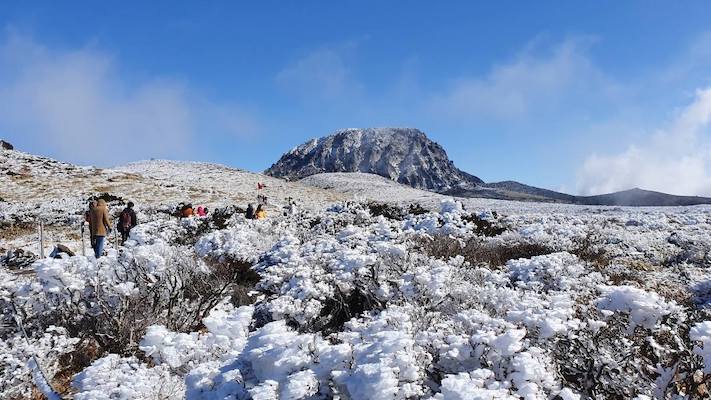
If you happen to come here on Christmas eve, you can see the elegant light decorations all around. This time is best for exploring the vibrant nightlife in Jeju and enjoy live music sessions. The snowfall in winters are quite light, along with some night frosts.
Things to do during winters in Jeju Island:
- Immerse yourself into the festive atmosphere around
- Welcome the new year in the Korean’s way
- Witness dawn at Seongsan llchulbong
- Become part of the Seogwipo Winter Sea International Penguin Swimming Festival that happens on first January
- Celebrate the taste of love in February
- See the yellow canola flowers blooming at their best
Spring Season
The spring season in Jeju Island arrives in March and stays till the end of May. This season boasts relatively warm weather and pleasant conditions. The average temperature fluctuates between 12 degrees Celsius to 22 degrees Celsius during the spring season.
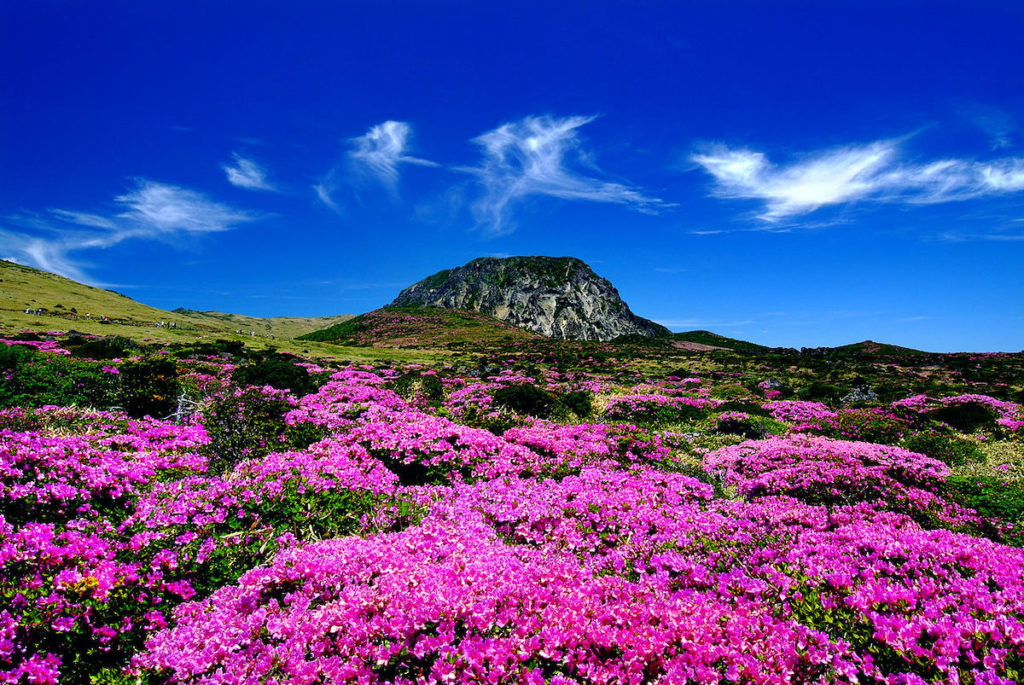
The temperature starts rising in March, and you get to enjoy the temperate sunny weather. This time is best for outdoor activities. Also, the whole island seems covered in wildflowers color making spring the best season to visit Jeju Island if you are a fan of natural beauty of mother Earth.
At the beginning of April, the cherry blossoms start appearing, and Jeju Cherry Blossom Festival is celebrated with huge pomp and show. Similarly, the Jeju Fire Festival is celebrated to ensure a great harvest. Thus, spring is at its peak of beauty here in April.
Things to do during spring in Jeju Island:
- Relax at the hot mineral water springs
- Enjoy seasonal Korean delicacy called fried gosari
- Celebrate the birthday of Buddha in May
- Watch the beautifully decorated temples and take part in the lantern parade
- See the cherry blossoms and other beautiful flowers alongside the island roads
Summer Season
Here comes the hot and humid Summer Season in its full swing at Jeju island. During this season, the temperature touches the 24 degrees Celcius mark. The beaches open up to get rid of heat by swimming or other water activities.
July and August are regarded as the hottest months here. So it is the best time for surfing on the waves, swim or dive into the freshwater in Jeju. Also, don’t forget to have tasty and fresh seafood like sea urchins, etc. So in August, hit the cafes located in the Jeju island area and beat the heat.
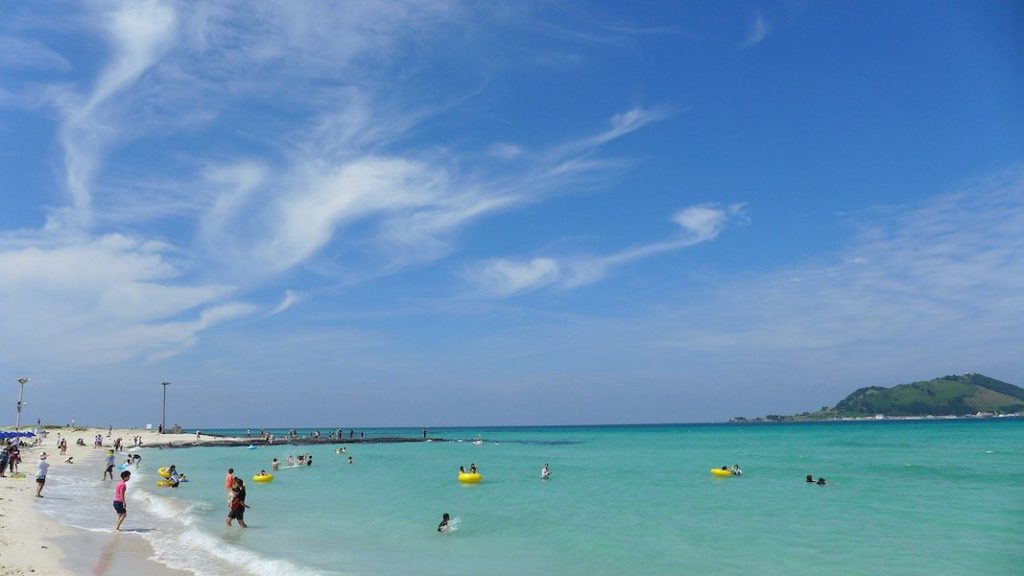
To cool off, try their famous summer food. During August, the beaches and hiking trails are heavily occupied. To have fun, you can head to other little popular attractions around. Moreover, Jeju island receives heavy rainfall in summer, so make your travel plan accordingly if this is the best time for you to visit Jeju.
Things to do during summer in Jeju Island:
- Do climbing, snorkeling, windsurfing, and other outdoor activities
- Spend time and enjoy yourself at the beach
- Eat bingsu and naengmyeon
- Get drenched in heavy rain
Autumn Season
From September to November is the autumn season at the famous Jeju island. The average temperature during this season is between 20 to 25 degrees. However, near the end of November, the weather starts turning cold, supported by little rain and dry air.
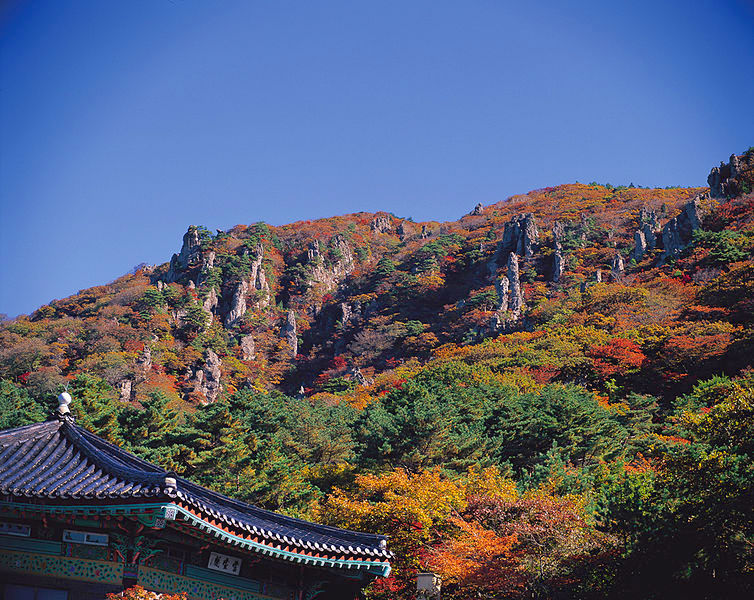
Many Koreans and foreigners travel during this time, so you will find hotels and other accommodation options at a cost higher than usual. We suggest you make a booking in advance to save your hard-earned money.
The trees start changing their color and turn to the red and golden combination. The fruits begin to ripe by October. You can purchase them in bulk or as per need at roadside stalls, supermarkets, shops, etc. Next comes November, the weather turns colder, which makes it best for hiking.
Things to do during autumn in Jeju Island:
- During the fall, enjoy the scenery around
- Enjoy South Korea’s biggest holiday, Chuseok
- Take part in different activities around like picking tangerines and other citrus fruits
- Relish the different fruits available, especially the persimmons
- Explore the walking trails covered in snow
Final Words
So, all that above is a short summary of different seasons in Jeju Island. As you read through, you will realise that some of the months are more suited to your travel making them the best time to visit the Jeju Island. This short guide will also give you an idea about possible activities during each season that you can indulge in during your trip.
Immerse yourself into the awesome atmosphere here and enjoy the fullest. If you want to know more about Jeju Island, then let us know in the comments.
Love it? Pin it!
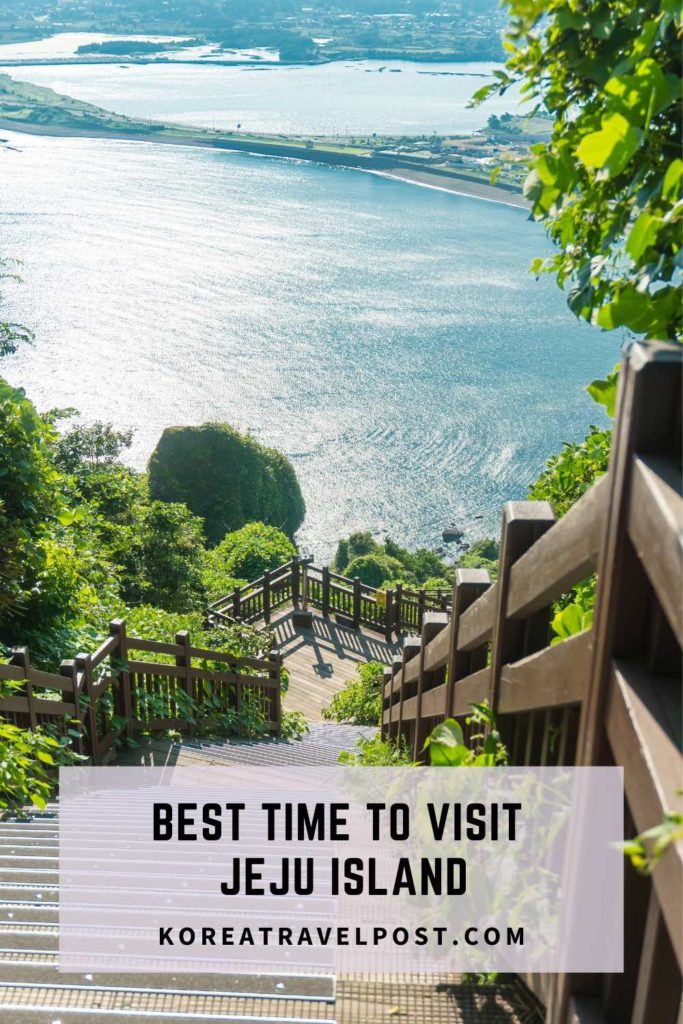
Don’t forget to check out these other South Korea travel posts:
- The Ultimate Guide to Exploring Jeju Olle Trails
- Beautiful Sights in Jeju-do Area – 100 Must-Visit Tourist Spots in Korea
- Best Cafes in Jeju to Visit in Your Winter Trip
- Must-Have Exclusives from Jeju Island – Food, Souvenirs, and Much More!
- Solo Woman Traveler’s Guide to Jeju
- Feeling Stuck at Home, Now You Can Visit Jeju Island Virtually via UNESCO Media Campaign
18,376 total views, 7 views today
KoreaTravelPost Editor
Hello there! I'm the Features Editor for KoreaTravelPost.
Related Posts

10 Frequently-Overlooked Hacks and Tips to Guide Your Convenient South Korea Travel
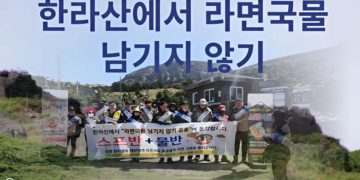
How to Cope with the Danger of Ramen Broth Pollution at Hallasan National Park + Crucial Tips!
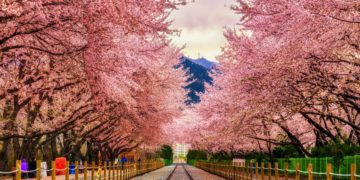
South Korea Travel Guide: Your Essential Guide For April 2024

The Essential South Korea Public Holidays Guide This Year
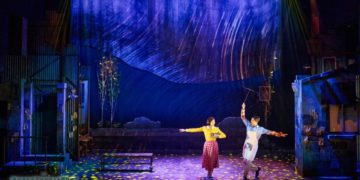
6 Essential Tips for Beginners: Embarking on Your K-Musicals Journey
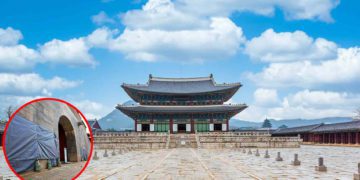
Dealing with Discomfort from Gyeongbokgung Palace Vandalism: Travel Tips

Incheon Chinatown: All You Need To Know

TESSAN Germany France Travel Power Adapter

Lonely Planet Korea 12

Korean Snack Box Variety Pack

OSULLOC Lovely Tea Gift Box Set
More from our network.

- Medical Tourism
FREE NEWSLETTER
Copyright © 2024 About Us| Terms of Use |Privacy Policy| Cookie Policy| Contact : [email protected]
Login to your account below
Fill the forms bellow to register
Retrieve your password
Please enter your username or email address to reset your password.

Best Time To Visit Jeju Island: A Guide for Every Traveler
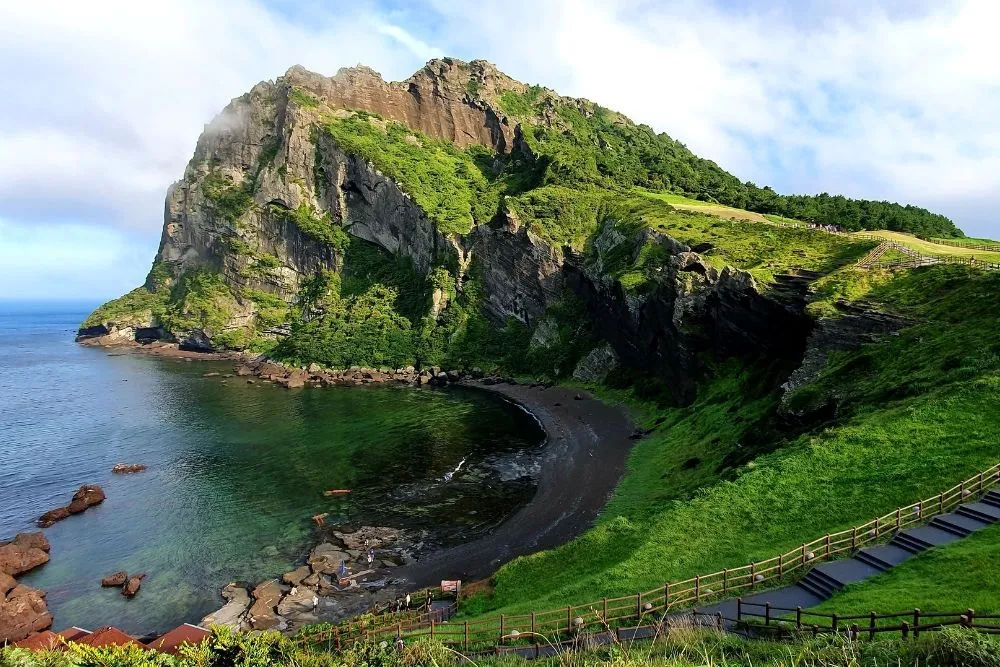
Jeju Island is a popular tourist destination. 15.2 million Tourists visited the island in 2019 (13.5 million of them were domestic visitors). This is hardly surprising given its abundance of beaches , gorgeous natural settings, rich cultural history, and delicious cuisine. There is something for everyone on Jeju Island, regardless of their hobbies. There is a description below as when is the best time to visit Jeju island.
The popularity and variety of Jeju Island’s amenities make choosing a time to come difficult. Learn about the weather, peak and off-peak seasons, suggested activities, and how these factors impact lodging and transportation to determine when the best time to visit Jeju Island is.
With this knowledge, you can plan the ideal vacation and determine the best time to visit Jeju island.
Table of Contents
Why Tourists Love to Visit Jeju Island
Off the coast of South Korea ‘s south lies the volcanic island of Jeju. It is referred to be South Korea’s Hawaii and is the biggest island in the nation.
Jeju Island offers a wide range of tourist attractions. With sights like the UNESCO World Heritage sites Jeju Lava Tubes , Seongsan Ilchulbong (a volcanic crater built thousands of years ago), and Hallasan Mountain (the highest mountain in South Korea), it is especially well-known for its natural beauty. Famous beaches on Jeju Island include Hyeopjae Beach and Hamdeok Beach .
Jeju Island, renowned among foodies for its mouthwatering cuisine—featuring shellfish and black pig—is also rich in museums, traditional villages, history, and culture, making it an enticing destination year-round.
For those considering a visit, understanding the best time to visit Jeju Island can be key to planning a memorable experience.
Domestic visitors particularly favor its accessibility, just a one-hour flight from Seoul, making it an outstanding weekend or public holiday escape, as well as an ideal holiday alternative for longer vacations.
As travel picks back up after COVID, it remains a popular destination; in 2022, over 14 million domestic travelers would have visited. For any tourist seeking a wide variety of experiences near one another, Jeju Island is a must-see location because of its abundance of natural, cultural, and gastronomic attractions.
Jeju Island Weather and Climate
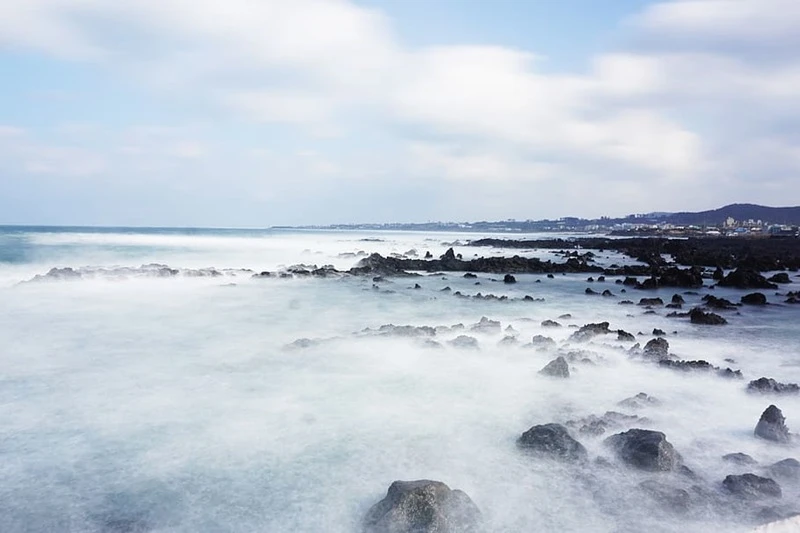
The weather is a significant consideration when determining the best time to visit Jeju Island. It experiences warm summers and moderate winters due to its subtropical environment. Situated on South Korea’s southern coast, the island enjoys a marine climate characterised by heavy precipitation and elevated humidity.
In January, the mean high temperature on Jeju Island is 5°C (41°F), whereas in August, the mean high temperature is 30°C (86°F). Jeju Island experiences its highest rainfall from June to September, with the potential for typhoons that bring with them strong winds and a lot of rain.
The ideal seasons to visit are said to be spring (March–May) and autumn (September–November), when Jeju Island has milder temperatures and less rain than in the summer.
Summer, which runs from June to August is the busiest travel season and is typically hot and muggy. The island is congested and lodging is typically more expensive during this time.
Although Jeju Island may be quite windy and chilly, the winter months of December through February are generally moderate. In the winter, snowfall is also possible, especially atop Mount Hallasan. The island could be less congested and lodging costs might be lower during certain months.
Jeju Island boasts pleasant weather throughout the year, characterized by high humidity and moderate rainfall. For those deliberating on the best time to visit Jeju Island, considering specific weather preferences becomes crucial.
Utilizing platforms like Weather Spark for more precise meteorological data, particularly in areas like Jeju City, aids in making informed decisions about the ideal time to explore this beautiful island.
Peak Tourist Season on Jeju Island
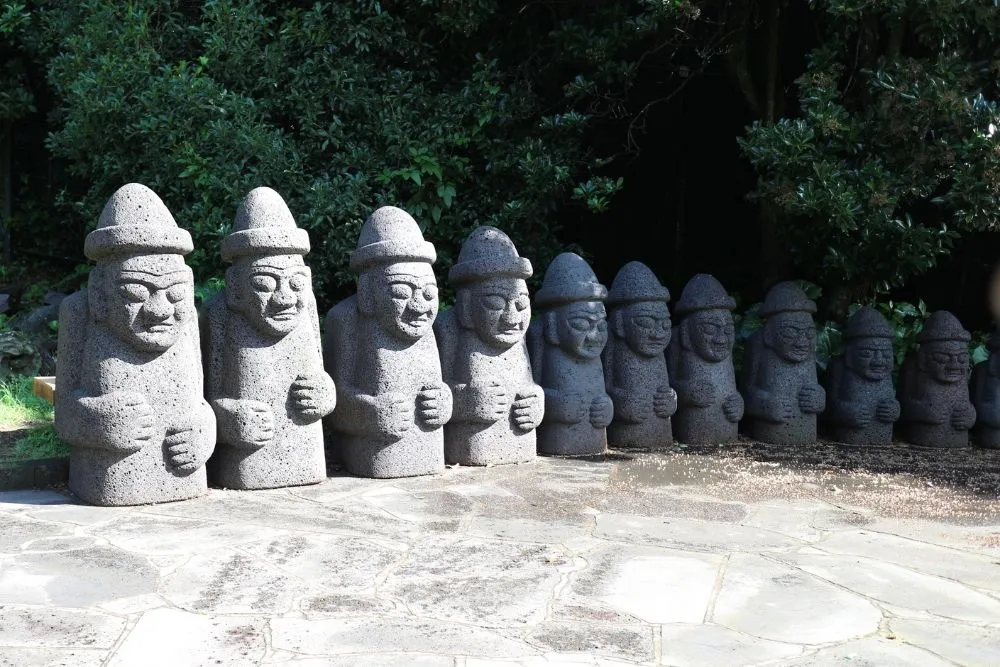
Peak seasons are usually when there are a lot of well-attended events and festivals happening, the weather is at its nicest, and domestic visitors are enjoying vacations.
The summer months from June through August mark Jeju Island’s busiest travel times, coinciding with the Korean summer vacation from mid-July to late August.
While the weather during this period is bright and mild, it’s worth considering whether this aligns with your preferences for the best time to visit Jeju Island.
These months attract a surge of visitors, particularly from within the country, drawn by the island’s stunning scenery and beaches. However, due to this influx, travel and lodging costs tend to increase, alongside other tourism-related expenses.
The blossoming season of spring flowers is another busier time of year. The island is well-known for its breathtaking springtime blooms, which include the lovely yellow canola and cherry blossoms.
This is a great time to view the island in full bloom because several flower events are happening, including the Jeju Canola Flower Festival and the Jeju Cherry Blossom Festival.
Peak season also occurs during the autumn foliage season, which is ideal for hiking the island because of the stunning tree hues.
Peak travel times on Jeju Island provide a plethora of experiences and activities, but they may also be quite congested and costly. Visit the island in the off-peak season if you want a more relaxed or reasonably priced vacation.
Shoulder and Off-Peak Tourist Season on Jeju Island
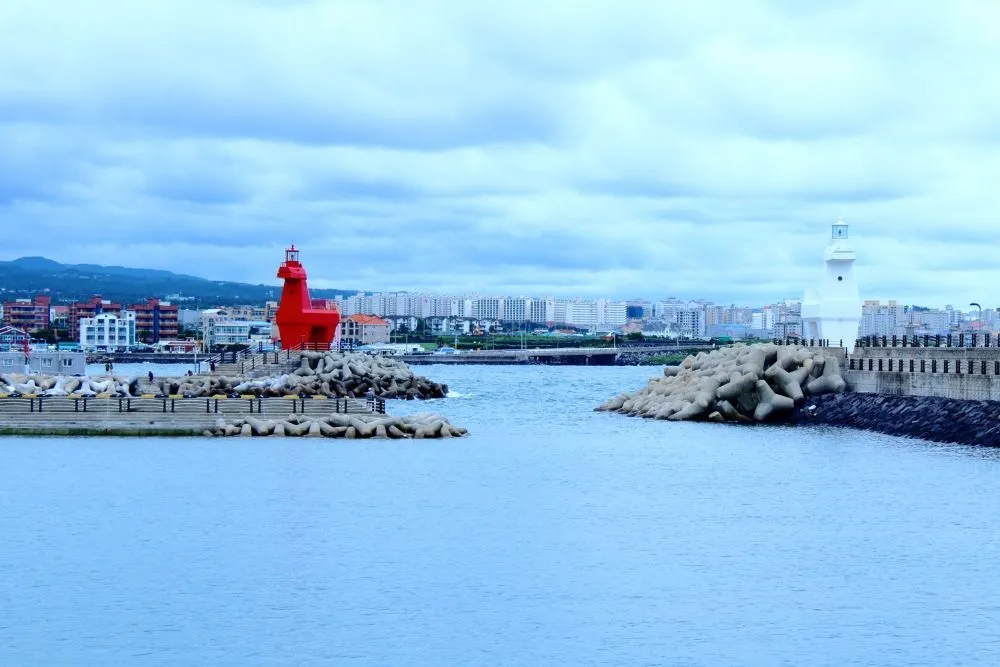
The shoulder seasons and off-peak periods on Jeju Island offer a distinct experience from the bustling peak season, making them a potential best time to visit Jeju Island for those seeking tranquility and avoiding inflated rates.
These seasons might be a perfect time to visit the island as they provide a different experience than during peak season.
The shoulder seasons are Spring (March to May) and Autumn (September to November), excluding the prime times for Spring flowers and Autumn foliage. The temperature is nicer throughout these seasons, and there won’t be as many people as during the busy season.
On Jeju Island, winter (December–February) is regarded as the off-peak season. Although it’s windier and colder than during peak season, the weather is often milder.
This can be a nice time to visit the island if you don’t mind the cold because it can be relatively tranquil and hotel costs are reduced. Jeju Island’s most sought-after fruit, tangerines, is also in season at this period. The harvesting season spans approximately from October to March.
Benefits of Traveling to Jeju in the Shoulder and Off-Peak Seasons
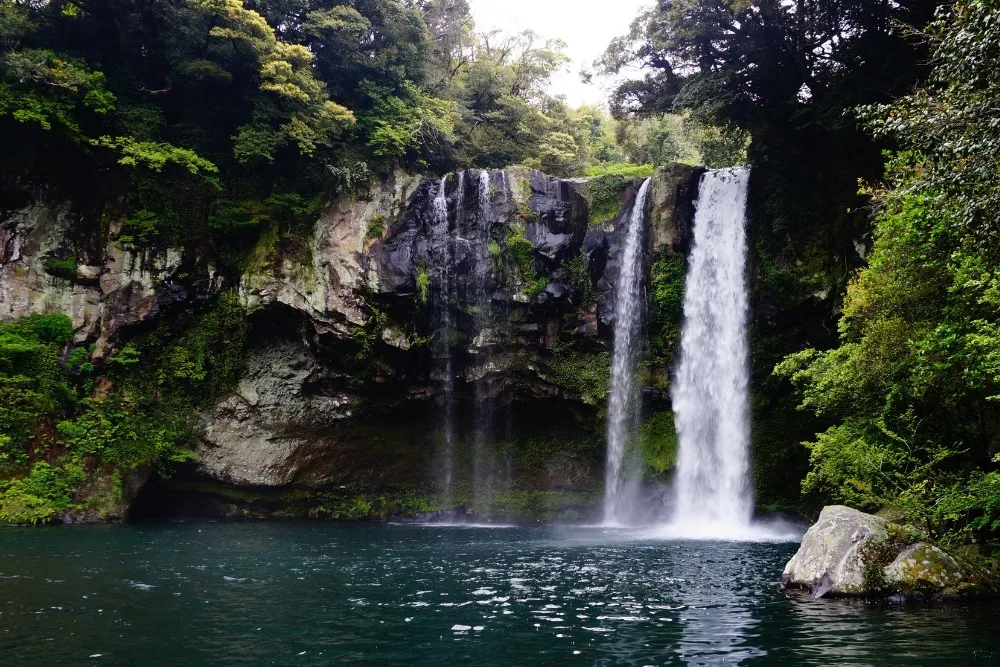
Aside from cheaper costs and the opportunity to see the island in a new light, visiting Jeju Island in the off-peak season offers several advantages such as less crowded beaches and hiking paths. These quieter periods can be considered the best time to visit Jeju Island for those seeking a more tranquil and intimate experience
Travel and lodging reservations are simpler to make during shoulder and off-peak seasons. Remember that during certain seasons, several well-liked tourist attractions or activities can close or have restricted hours. Additionally, the off-peak season is often less costly than the peak season.
These are the seasons when most activities, lodging, and transportation are less expensive, which makes sticking to a budget simpler.
Enjoying the island’s beaches and hiking trails with fewer visitors is one of the key advantages of traveling during shoulder or off-peak seasons. It might be challenging to locate a peaceful place to unwind or take in the views at the busiest times of the year due to the crowds on the hiking trails and beaches.
There are fewer tourists and more tranquillity to take in the island’s natural splendor when you visit during the off-peak season.
A chance to engage with people more and gain a deeper knowledge of their culture may also be presented by visiting at off-peak hours. The island is frequently swamped with visitors at the busiest times of the year, making it challenging to engage with the locals.
However, it is simpler to travel to nearby locations and take in the local way of life during the off-peak season.
There are advantages and disadvantages to traveling outside of the busiest tourist seasons, but if you want a more relaxed and affordable vacation, think about going to Jeju Island in the shoulder or off-peak seasons.
The Influence of Tourist Seasons on Transportation and Accommodation
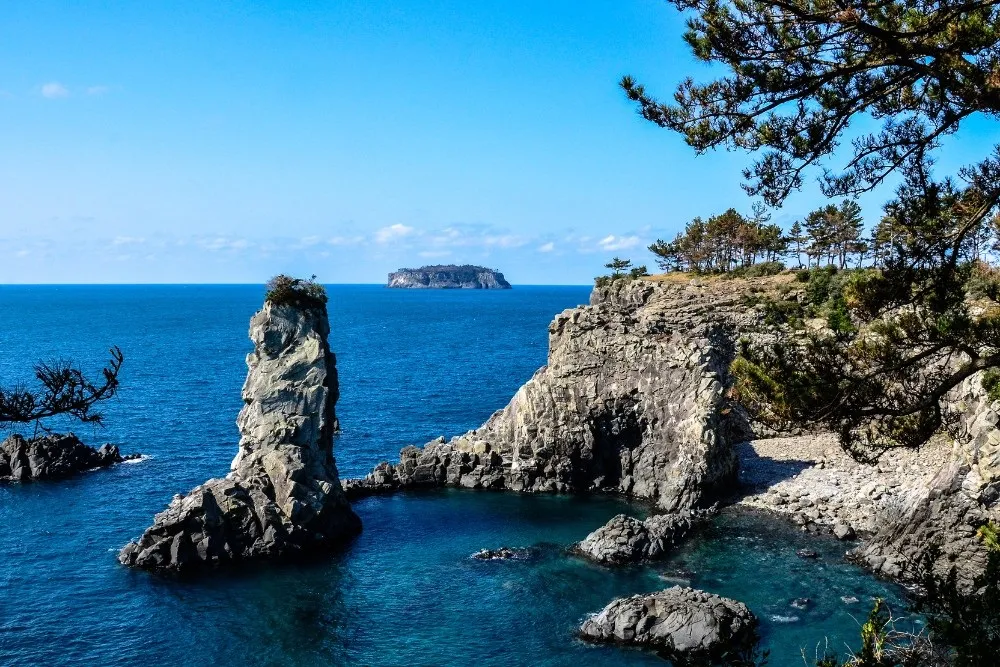
The primary mode of transportation for tourists visiting Jeju Island is via plane. With 16 million tickets available over a year, it is the busiest domestic flight route in the world. There are flights to Jeju Island from several South Korean cities. Depending on the season, ferries from the mainland can also take you to Jeju Island; the cost varies.
Due to its flexibility and ability to access isolated areas, renting a vehicle or scooter is a popular option to explore the island. However, due to strong demand, renting a vehicle or scooter at the busiest time of year might be challenging. Prices for renting cars and scooters are also often higher in peak seasons than in off-peak times.
While they are less handy than a vehicle or scooter, buses and taxis are still an option for getting about the island. In addition, Jeju Island’s major cities and surrounding areas are connected by a local intercity bus service.
On Jeju Island, lodging options vary from opulent resorts to reasonably priced guesthouses. There are many hotels and resorts, and during the busiest times of the year, they can become booked up quickly and may become more costly.
A room can be found more easily and for less money during off-peak seasons. While popular and less expensive, guesthouses and hostels may fill up quickly during high season.
On Jeju Island, there are many of alternatives for lodging and transportation, however, availability and costs could change with the season. Prices will be higher and it may be harder to locate lodging and transportation during busy times.
To guarantee you have a place to stay and a means of transportation during your vacation, plan and book reservations in advance during these popular times. Off-peak times are more cost-effective and make it simpler to get lodging and transportation.
Best Time to Visit Jeju Island by Activity
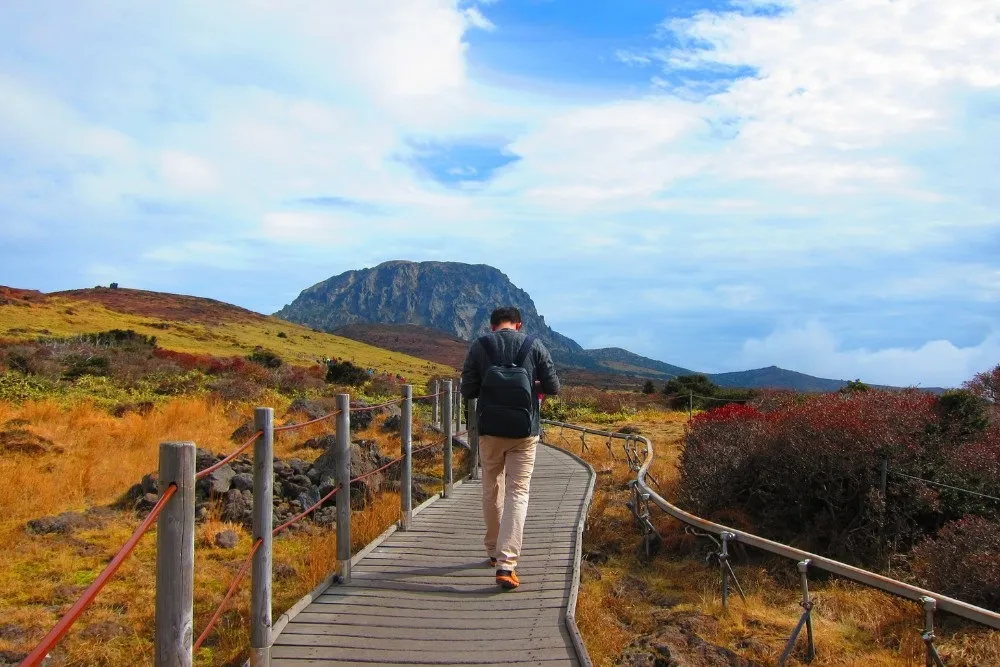
Visitors may engage in an extraordinarily broad variety of activities on Jeju Island, including as hiking, water sports, and cultural excursions. Here is a summary of some of the most well-liked things to do in Jeju Island, along with the ideal time of year to do them:
Hiking : The island of Jeju is renowned for its breathtaking natural settings, which include South Korea’s highest peak, Hallasan Mountain . The island’s cherry blossoms and autumn foliage are at their peak during the spring and autumn seasons, which are also the ideal times of year to go trekking.
Beaches : Hyeopjae Beach, Hamdeok Beach, and Seongsan Ilchulbong Beach are just a few of the stunning beaches on Jeju Island. The summer months of June through August are ideal for beach visits because of the pleasant weather.
Water sports : Swimming, snorkeling , and scuba diving are all excellent water activities to enjoy on Jeju Island. The summer months of June through August are ideal for water activities since the weather is pleasant.
Cultural experiences : Traditional villages and museums may be found on Jeju Island, which has a rich cultural legacy. Generally speaking, you may enjoy these attractions all year round.
As you can see, Jeju Island provides a variety of experiences depending on the season, thus there is never a bad time to come, depending on your preferences.
Useful Resources
AccuWeather
Weather.com
Popular travel destination Jeju Island is renowned for its exquisite cuisine, breathtaking natural scenery, lovely beaches , and rich cultural history. The article examined the ideal time to visit Jeju Island, as well as the island’s environment and weather, as well as the busiest and least busy travel seasons.
It also examined how transportation and lodging are affected by the tourism seasons. The kind of experience you hope to have will determine when is the best time to visit Jeju Island. The best time to go is in the summer, from June to August, if you want a nice, sunny holiday.
The island’s beaches and aquatic activities are at their peak during this period. But since it’s also the busiest travel time of year, things may get congested and pricey.
The best times to visit Jeju Island are during the shoulder seasons of spring (March–May) and autumn (September–November), when temperatures are cooler and ideal for trekking and taking in the stunning autumn foliage and flowers of the island.
The off-peak season is winter, which runs from December to February. Prices are lower and the island is less congested. Planning will ensure that your trip to Jeju Island is memorable and enjoyable. Take into account the weather, the travel experiences you enjoy, and your budget.
Peak seasons tend to be more expensive and crowded, while off-peak and shoulder seasons can be more affordable and offer a different, more peaceful experience. We recommend that you book transport and accommodation in advance, especially during peak periods.
The Best Jeju Island Itinerary for 2-5 Days (+ Hour Breakdown)
The first time I went to Jeju Island I spent 3 nights in the summer and tried to fit in as many attractions as I could.
I went back to Jeju Island in 2023 and ended up staying 6 nights and was able to visit more places.
Whichever amount of days you stay in Jeju Island for, planning ahead will help you make the most of your Jeju Island itinerary.
Here are sample 2-day, 3-day, and 5-day Jeju Island Itinerary schedules to see the main Jeju Island attractions with nature trips, beaches, waterfalls, and UNESCO Heritage sites.
If you’re new to South Korea, make sure to read my travel guide to South Korea .
🎥 Watch my vlogs for more Jeju Island tips:
Table of Contents
How many days do you need in Jeju Island?
For most tourists who are spending two weeks in South Korea and want to see other cities too, 3 nights in Jeju Island would suffice.
2 days in Jeju :
If you’re in a rush and can only spend 2 days + one night in Jeju Island, you can get a taste of Jeju’s main attractions like Seongsan Ilchulbong, waterfalls, and beaches.
In this case I would book a Jeju Island tour to maximize time.
3-4 days in Jeju :
You’ll have time to check out additional cultural sites, beaches, and nature sites, including a quick Hallasan Mountain hike .
5 days or more in Jeju :
You can add a Hallasan Mountain hike or a trip to Udo Island to your Jeju Island Itinerary. You can also add more of the lesser-known nature and cultural sites.
Jeju Island Travel Essentials
Book Before Your Jeju Trip: 🚕 Hire a private chartered car for a Jeju Island day tour 🏢 Book discounted hotels in Jeju on Agoda 🎫 Browse through dozens of available Jeju tours 🚌 Buy a Jeju Bus Hop On & Hop Off Day Pass here 🚙 Rent a car in Jeju Island for as cheap as $28 USD a day
Getting Around Jeju Island
I have a full guide on getting around Jeju without a car . If you’re traveling by bus like I did, it’s a must read.
If you’re only spending 1 or 2 nights in Jeju Island, taking public transit is possible and the bus rides are scenic, but if you want to save time without rushing, here are some other options:
Use the Kakao T taxi app to travel to/from from different destinations. Uber in Korea only seems to work in Jeju City.
Private Driver
You can hire a driver for a day that will take you to the destinations on your custom Jeju Island Itinerary.
Car rentals in South Korea go for as low as $28 USD a day. Check the rates here .
Join a Tour
Group and private tours provide transportation to and from main Jeju attractions. Choose from dozens of Jeju Island tours .
Jeju Island Itinerary Tips
Here are some tips to help you save time and make the most of your Jeju Island Itinerary:
- Visit popular attractions early in the morning or later in the afternoon to avoid crowds. But in general, start the day early.
- Combine nearby attractions to minimize travel time between locations.
- Check the weather forecast and plan indoor activities for rainy days.
- Use the Naver Map app to navigate the island. Google Maps is not maximized for Jeju. There is strong network signal throughout the island.
- If you’re going to hike Hallasan Mountain , save it towards one of the last days in your Jeju trip so you’re not sore for most of your trip.
- Bring good walking shoes!
Read more tips in my Jeju Island Travel Guide .
Most Popular Places to Visit in Jeju
Make sure to choose at least 1 or 2 of these to include in your Jeju Island Itinerary:
- Seongsan Ilchulbong aka Sunrise Peak
Hike Hallasan Mountain
- Daepo Jusangjeolli Cliff
Want to Mix and Match for your Jeju Island Itinerary? Here are my Jeju Island blog posts:
- 5 Amazing Waterfalls in Jeju Island You Can Visit
7 Best Beaches in Jeju to Visit (with Photos & Reviews)
- 22 Things to Do in Jeju Island by Area
Sample Jeju Island Itinerary Based on Days
Here’s a summarized sample Jeju Island Itinerary for different number of days. 2 days = 1 night, 3 days = 2 nights, etc.
These are assuming you arrive in Jeju Island in the earlier part of the day. What you choose will also depend on where you’re staying and what time your flight out is.
2-Day Jeju Itinerary
Day 1 : Seongsan Ilchulbong, Seopjikoji, Daepo Jusangjeolli Cliff, Oedolgae Rock, Jeongbang Waterfall.
Day 2 : Choice of beach, Yongyeon Pond, Dodu Rainbow Coastal Road.
3-Day Jeju Itinerary
Day 1 : Daepo Jusangjeolli Cliff, Oedolgae Rock, Jeongbang Waterfall, Saeyeongyo Bridge, Cheonjeyeon Waterfall, beaches.
Day 2 : Seongsan Ilchulbong, Seopjikoji, Hamdeok Beach, Woljeongri Beach.
Day 3 : Handam Coastal Walk, Aewol Cafe Street, Hyeopjae Beach.
4-Day Jeju Itinerary
Day 3 : Hike Hallasan Mountain or visit Udo Island.
Day 4 : Handam Coastal Walk, Aewol Cafe Street, Hyeopjae Beach.
5-Day Jeju Itinerary
Day 3 : Handam Coastal Walk, Aewol Cafe Street, Hyeopjae Beach, Osulloc Tea Museum, Sinchang Windmill Coastal Road.
Day 4 : Hike Hallasan Mountain or visit Udo Island.
Day 5 : Seaside cafe or Yongyeon Pond & Bridge and Dodu Rainbow Coastal Road.
Full Jeju Island Itinerary
Day 1 of jeju island itinerary: seogwipo city (south), morning (2-4 hours).
1. Jeongbang Waterfall
Entrance : 2,000 won ($1.50 USD)
Jeongbang Waterfall is the most popular waterfall in Jeju Island, sitting at 23m (75 feet) high. It’s one of the few waterfalls in the world to flow directly into the sea.
It can get crowded, so morning is the perfect time to visit.
2. Saeseom Island and Saeyeongyo Bridge
Nearby is Saeyeongyo Bridge , the longest pedestrian bridge on Jeju Island. It’s impressively shaped like a sail and connects to Saeseom Island.
Though you won’t spend too much time on the island itself, the views from the bridge are beautiful and worth visiting.
3. Oedolgae Rock
Entrance : free
Oedolgae Rock means “Lonely Rock.” This lone rock formed 150,000 years ago from a volcanic eruption. There’s several viewing points of the rock formation and of the sea.
Noon (2-4 hours)
1. Eat lunch nearby or head more to the western part of south Jeju to Jungman Tourist Complex , where there are several cafes and restaurants.
2. Cheonjeyeon Waterfall
Entrance : 2,500 won ($1.88 USD)
Cheonjeyeon Waterfall is the second-most popular waterfall in Jeju Island, which has three distinct tiers, each providing unique viewpoints. Its name, “Cheonjeyeon,” translates to “Pond of God.” The tallest waterfall tier is 22 meters (72 feet) high.
3. Daepo Jusangjeolli Cliff
Daepo Jusangjeolli Cliff is one of my favorite places to visit in Jeju Island. It was shaped by lava cooling against the coastal rocks when a volcano erupted underwater.
There’s viewing points and bridges throughout the area.
Evening (2-3 hours)
1. Jungmun Saekdal Beach
Catch the sunset or go for an evening stroll at Jungmun Saekdal Beach , a popular beach for surfing. There are cliffs along the beach for walking trails and beach viewpoints, as well as restaurants and bars.
Day 2 of Jeju Island Itinerary:
Morning (2-4 hours): east jeju island.
1. Seongsan Ilchulbong aka Sunrise Peak
Entrance : Free to hike on the left side, 5,000 won or $4 USD to hike on the right side.
Hiking Seongsan Ilchulbong aka Sunrise Peak is in the top 5 things to do in Jeju Island, and a main attraction in the East Coast.
It’s a UNESCO Heritage Site and was formed by a hydrovolcanic eruption.
The hike is beginner-friendly and takes about an hour in total . However, prepare for a lot of stairs. You can bring water with you and there are rest benches and viewpoints on the way up.
Optional : Close to Sunrise Peak is Seopjikoji , which a popular view point, but I didn’t have time to visit the first time.
2. Hamdeok Beach
Hamdeok Beach is located towards the north of Seongsan Ilchulbong. It’s my favorite beach in Jeju Island, and not really for the beach but for the whole surrounding area.
There’s two beach areas along with trails that lead to gorgeous viewpoints where you can see the teal waters from above.
3. Woljeongri Beach
Woljeongri Beach is also on the same coast as Hamdeok Beach and is located in a beach town area that’s surround by windmills. It’s along a beautiful coastline of cafes, restaurants, and galleries.
Noon (2-4 hours): West Coast
1. Lunch : head back to Jeju City to grab lunch or continue to the West Coast for lunch.
2. Aewol Cafe Street
Right next to Handam Coastal Walk is Aewol Cafe Street , a popular area of cafes and restaurants with seaside views.
3. Handam Coastal Walk
Within walking distance of Aewol Cafe Street is the Handam Coastal Walk, one of my favorite places to visit in Jeju Island.
It’s a paved trail along the coastline, with beautiful views of the sea, lava rock formations, and lush greenery. If you keep walking you’ll also reach Gwakji Beach.
If you are staying in Jeju City:
1. Yongyeon Pond & Bridge
Yongyeon Pond is a short 10-minute bus ride north of downtown. While there, you can explore the pond and water valley with its teal waters, as well as walk across the bridge, which is lit up at night.
2. Dodu Rainbow Coastal Road
The Dodu Rainbow Coastal Road follows northern Jeju’s coastline, featuring colored tile blocks. It’s an nice spot to catch the sunset, and there are restaurants and cafes located across the street for dinner.
If you are staying in Seogwipo City:
2. Jungmun Tourist Complex
You can also head to the Jungmun Tourist Complex for dinner nearby which has lots of resorts, cafes, and museums.
Day 3 of Jeju Island Itinerary: Back to West Coast
1. Hyeopjae Beach
Hyeopjae Beach is located in the northwestern side of Jeju Island. The beach is known for its white sand, black lava rocks, and clear waters that’s safe for swimming.
You can also sit on the black lava rocks formed by volcanic eruptions, which is a highlight of Hyeopjae Beach and a popular photo op.
2. Geumneung Beach
Right next door to Hyeopjae Beach is Geumneung Beach . The water is quite shallow but the water is pristine with beautiful viewpoints of both beaches.
Across the road from Geumneung Beach are Hallim Park, Hyeopjae Cave, and Ssangyong Cave that you can visit while there.
1. Osulloc Tea Museum
Grab lunch while at the Osulloc Tea Museum , a popular destination in Jeju Island.
The museum offers insight into the history and culture of tea in Korea, including tea-making processes and traditions. You can explore the tea fields and sample different tea varieties.
2. Sinchang Windmill Coastal Road
Located to the west of the Osulloc Tea Museum is the Sinchang Windmill Coastal Road , where you can get directly under the windmills (or from viewing paths and bridges).
It’s a 15-minute walk away from the bus stop, but you walk through local views like garlic farms. You can also take a Kakao T taxi there.
Evening (2 hours)
1. Suwolbong Peak Summit
Catch the sunset at Suwolbong Peak Summit , which is located a quick ride south of the Sinchang Windmill Coastal Road.
Walk along the coastal paths and get panoramic views of the surrounding landscape and unique rock formations.
Day 4 of Jeju Island Itinerary: Hike Hallasan Mountain
Hallasan Mountain should be saved towards the end of your Jeju Island Itinerary, so you won’t spend the other days of your trip sore and tired from hiking.
There are different hiking trails to take.
The shortest route is Eoseungsaengak Trail closer to Jeju City, and is the trail I hiked. It takes less than 30 minutes to reach the top, but with lots of stairs.
📖 Read my Guide to Hiking Eoseungsaengak Trail (+ How to Get There)
Other shorter hikes : Eorimok Trail and Yeongsil Trail, which take 2-3 hours one way. The other trails take around 4-5 hours each way.
If you don’t want to hike alone, you can also join a Hallasan group tour that includes other popular destinations.
Relax at one of the many beaches in Jeju Island and eat a restaurant with amazing water views.
Plant-based? Here are delicious vegan food in Jeju to try.
Alternative to Hallasan Mountain
Take a trip to Udo Island located off the east of Jeju Island. I have not visited Udo Island yet, but it’s definitely on my list.
Day 5 of Jeju Island Itinerary
On your last day before you head back to the airport:
- Shop for souvenirs
- Eat at a seaside cafe or restaurant
- Take a coastal walk
- Visit a nearby beach
More Things to Do in Jeju Island
Here are other sites in Jeju Island if you’d like to switch out or add activities to your Jeju Island Itinerary. I have not been to these places yet:
North and Central Jeju:
- Jeolmul Natural Recreation Forest
- Halla Arboretum
- Jeju Love Land
- Jeju Museum Of Art
- Jeju Light Garden
South Jeju / Seogwipo City:
- Kayak on Soesokkak
- Seogwipo Forest of Healing
- Namwon Keuneong Promenade
- Other waterfalls in Jeju Island
- Hello Kitty Island
East Coast:
- Dakmeoru Coast
- Jeju Folk Village
- Manjanggul Lava Cave
- Suwolbong Peak Summit
- Jeju Swiss Village
West Coast:
- Arte Museum Jeju
- Osulloc Tea Garden
- Hyeopjae Cave
More Jeju Island Posts
Essential Tips to Getting Around Jeju Without a Car
5 Amazing Waterfalls in Jeju Island You Can Visit (2024)
Guide to Hiking Eoseungsaengak Trail (+ How to Get There)
7 Essential Seoul Travel Tips for First-Timers (+ everything I wished I knew)
8 Best Vegan Restaurants in Jeju Island
Roseanne Ducut is a solo female traveler and Filipina from the Bay Area, California. She writes practical and culture-rich travel guides and encourages solo female travelers to take #yolo trips. A veghead for over 15 years, Roseanne also writes vegan guides to help others plan their trips.
When is the best time to visit Jeju island South Korea?
Dubbed as Hawaii of East Asia, Jeju island is a must-stop on your trip to South Korea .
When is the best time to visit Jeju island and enjoy the scenery?
This article includes the climate in Jeju, the best months to visit Jeju island, and things to do on Jeju island in different seasons.
Climate and weather in Jeju island
Located in the southern part of Korea and surrounded by the sea, Jeju Island has warmer and more pleasant weather than other parts of Korea.
The average temperature of the winter months (December to February) is 5°C and the summer months (June to August) is 26°C.
There are four distinct seasons: Spring, Summer, Autumn, and Winter.
- Spring: from March to May
- Summer: from June to August
- Fall: from September to November
- Winter: from December to February
Rainy season in Jeju island
From the second half of June to early October, Jeju island can be affected by typhoons that bring strong winds and torrential rains.
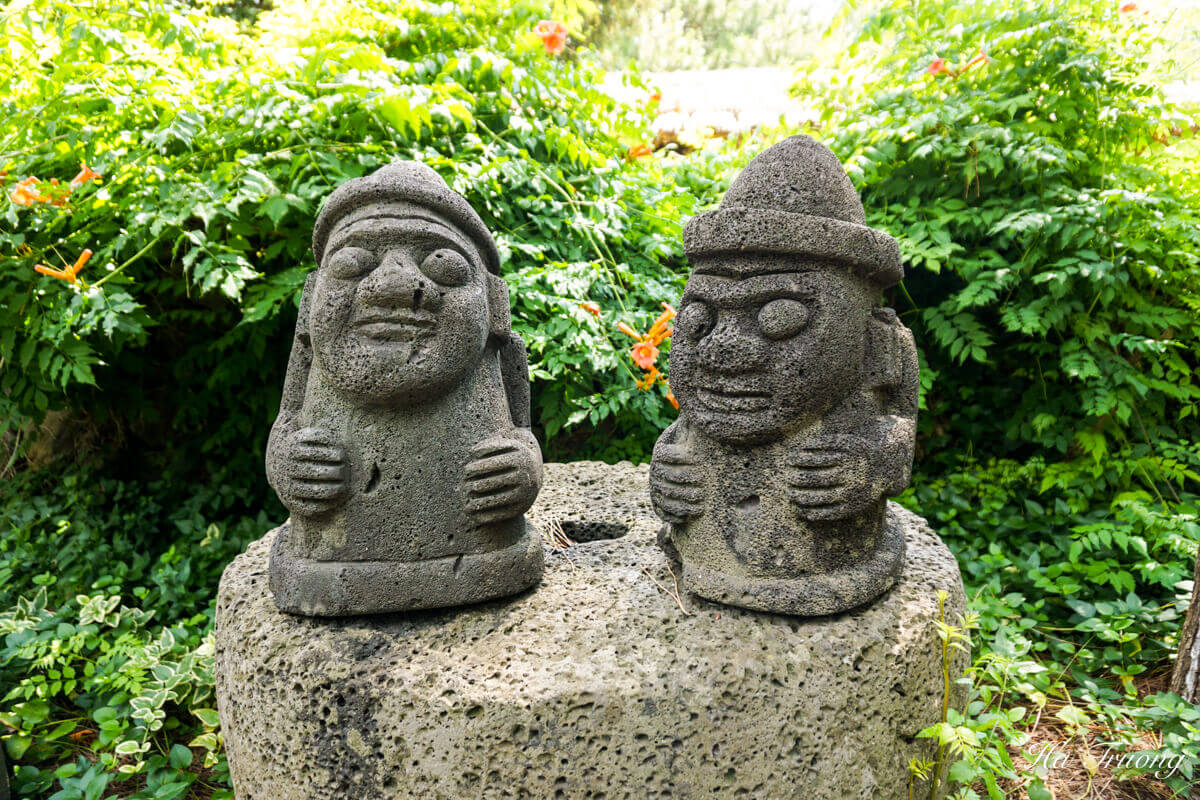
Best time to visit Jeju island
The best time to visit Jeju island is from April to June and September to October.
April to June is the end of spring and early summer. The weather is warm but still dry with little rainfall.
Traveling to Jeju at this time, you will have the opportunity to stroll around and see the beautiful cherry blossoms or attend the vibrant spring festival.
From September to October, you can enjoy the beautiful scenery of the autumn, with the leaves simultaneously turning into very unique yellow or red.
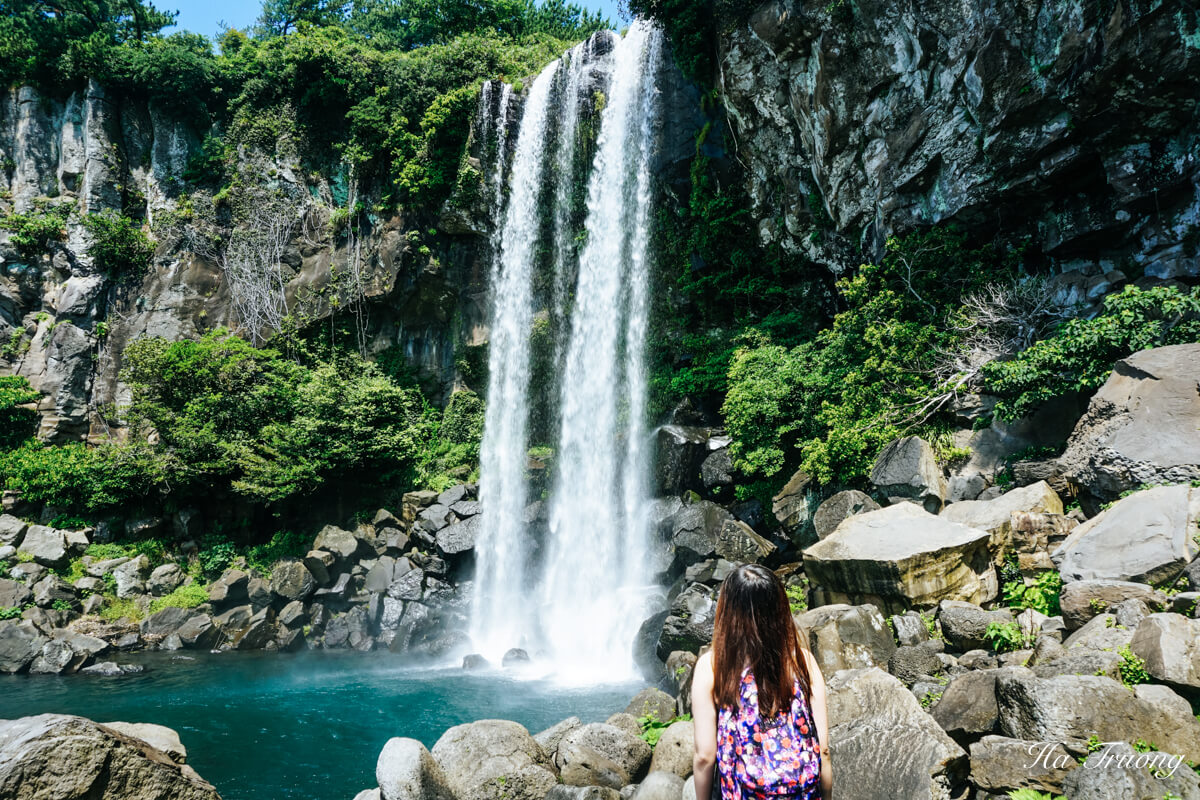
Things to do on Jeju island in different seasons
1. spring in jeju.
Spring on Jeju Island usually takes place from March to May with relatively warm and pleasant weather.
- March: The highest average temperature of the day is 12 – 13ºC, and the lowest is about 6ºC
- April: The highest average temperature of the day is 17 – 18ºC, and the lowest is 10ºC
- May: The highest average temperature of the day is 21 – 22ºC, and the lowest is 14 – 15ºC
Things to do in Jeju in spring
a) See flowers in Jeju Island
By the time of spring, Jeju is filled with beautiful blooming flowers. Cherry blossoms can easily be found along either side of the roads on the island. You can also spot azaleas and canola as well.
b) Join the hot spring
After a long day exploring Jeju island, nothing is more wonderful than soaking in hot mineral water and relaxing.
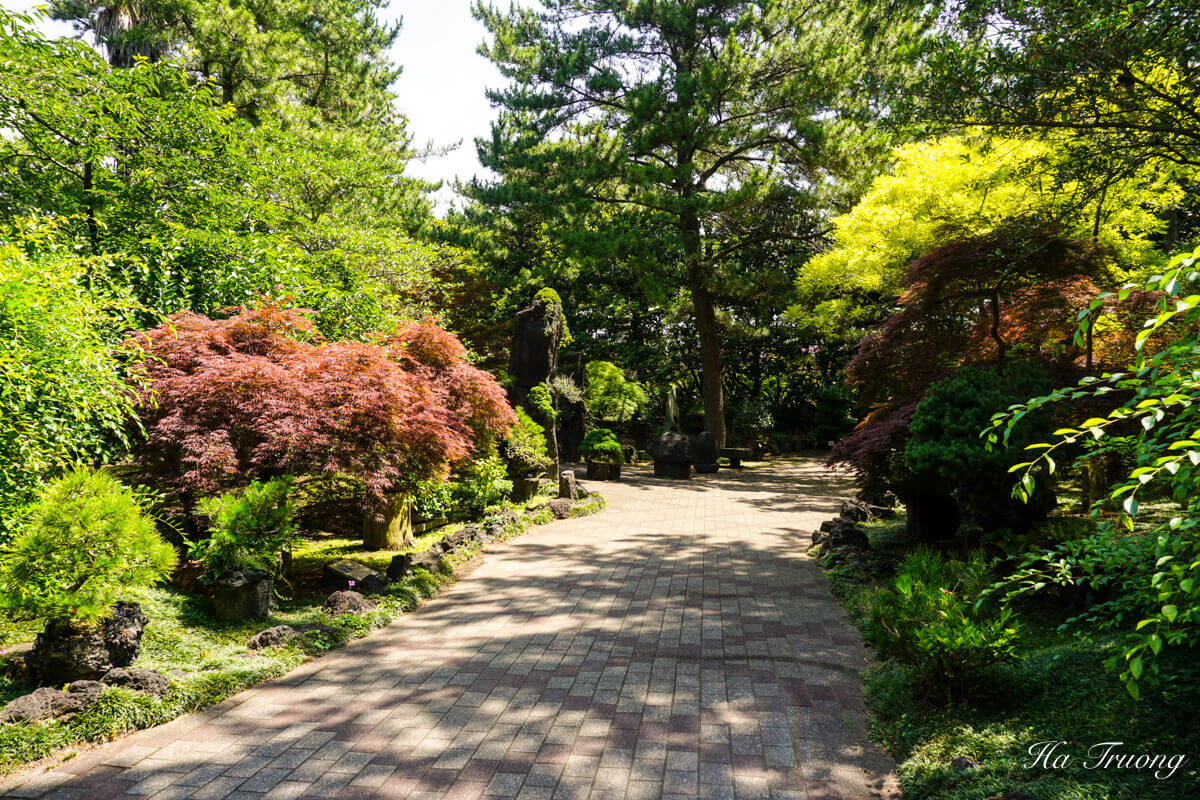
2. Summer in Jeju
The summer on Jeju Island is from June to August every year. It’s usually hot and humid, with the average temperature on the island being about 25 – 30 degrees Celsius.
In July and August, heavy rains appear more often, and it can affect your travel plan.
Things to do in Jeju in summer
For those who love outdoor activities, you can join some of them, such as climbing, windsurfing, snorkeling, at the beginning of June.
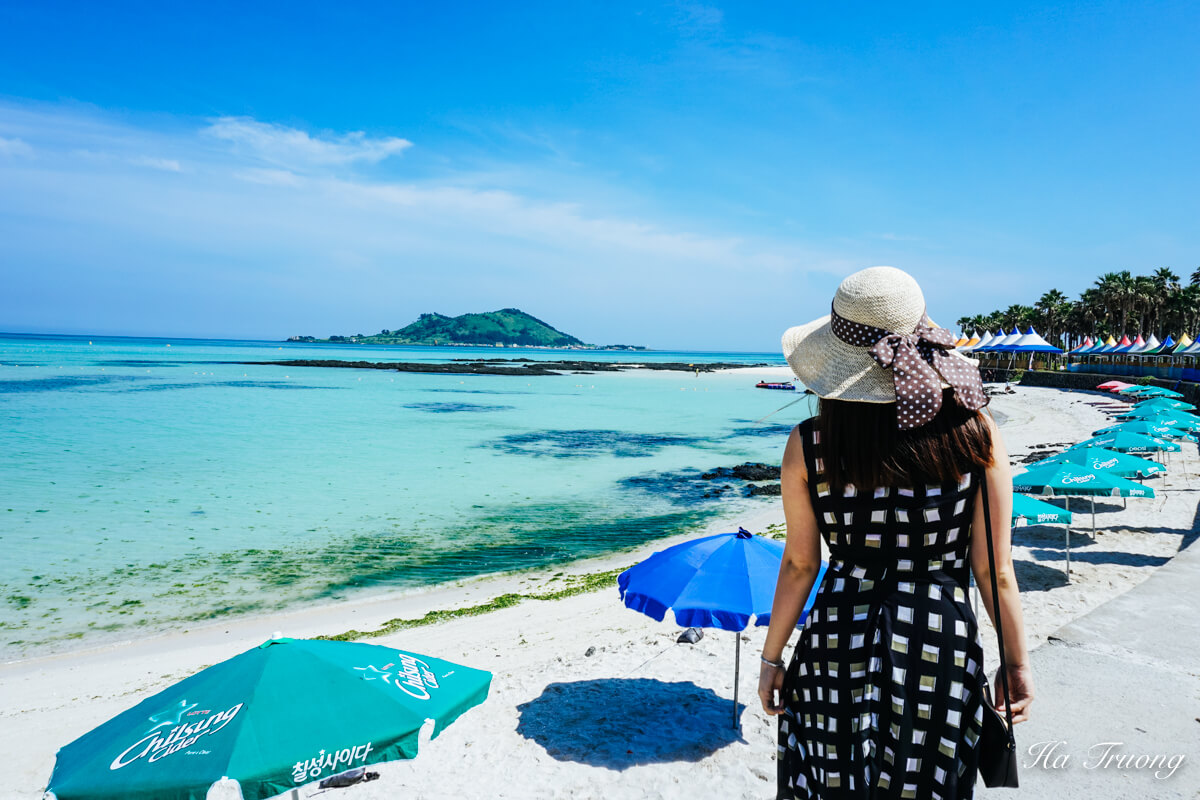
3. Autumn in Jeju
Autumn on Jeju Island usually starts from September to November each year and has a cool atmosphere.
The average temperature is about 20 – 25 degrees Celsius. At the end of November, the weather gets colder, but the air is still dry and has little rain.
Things to do in Jeju in autumn
When traveling to Jeju in the fall, you can enjoy the poetic scenery and participate in different activities such as picking tangerines.
There are many tangerine farms open to visitors. When visiting the farm, you can enjoy the sweet tangerines and harvest their fruits.
- Baengnokdam Farm (백록담 체험농장)
- Odeung Gamgyul Farm (오등 감귤농장)
- Gyulhyanggi Agricultural Association (귤향기)
Seogwipo City
- Hallabong Farm
- Jejuhyang Nongsusan (제주향 농수산)
4. Winter on Jeju island
Winter on Jeju Island starts from December to February next year. Compared to Seoul, the weather of Jeju Island is much warmer in the winter.
The average temperature ranges from 7 to 9 degrees Celsius. Snowfalls are typically light, as well as night frosts.
Things to do in Jeju in winter
Coming to Jeju in winter, you can watch the snow and immerse yourself in the bustling winter festival atmosphere. The whole neighborhood is decorated with flowers and vibrant music.
Ha is an avid traveler and writer with a background in marketing & hospitality. She's lived in a few countries and traveled to more than 30. When she's not traveling or writing, Ha loves trying new recipes.
Similar Posts
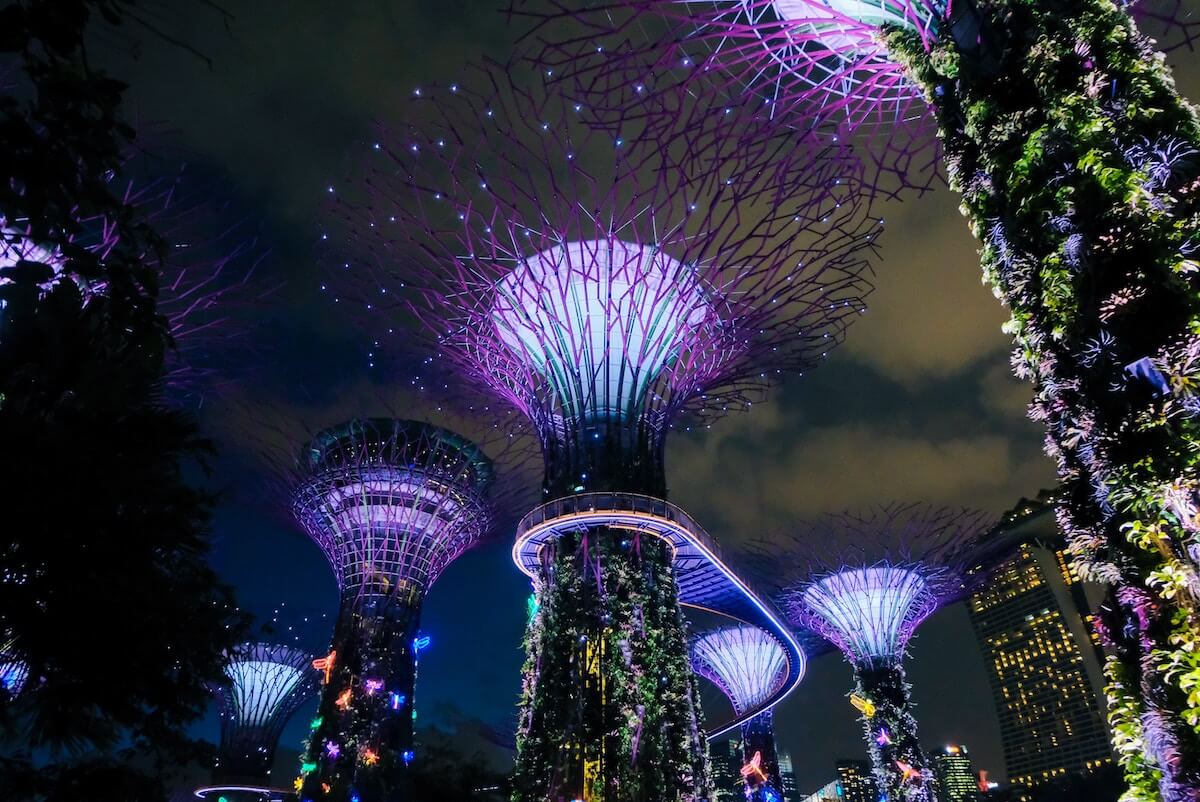
25 Amazing Things To Do In Singapore That You’ll Love
Singapore is a melting pot of cultures, a futuristic haven, and a traveler’s paradise. From savoring delectable street food to…
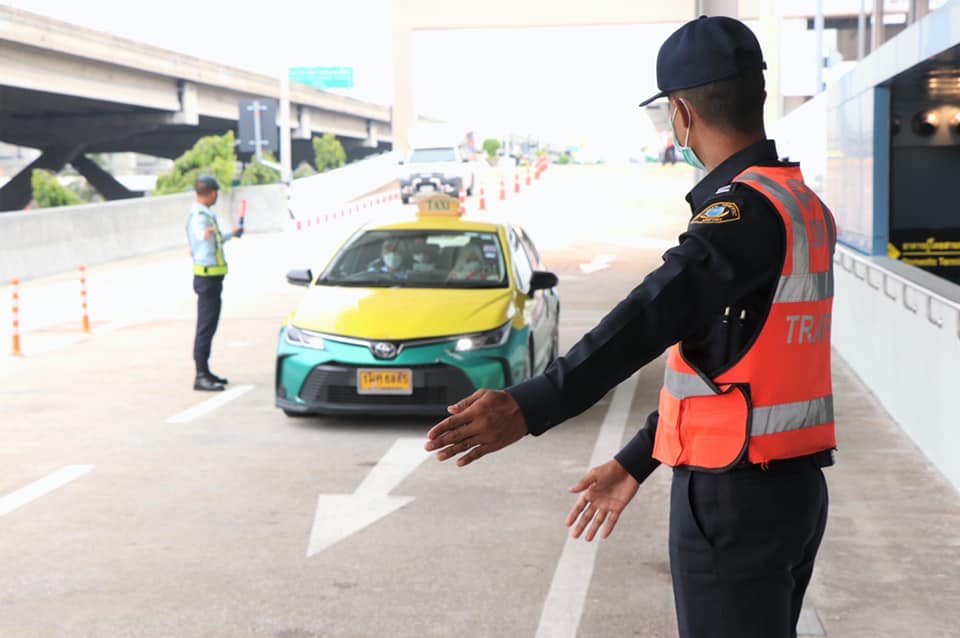
Don Mueang Airport To Bangkok Thailand: Transport Guide
How to travel from Don Mueang Airport to Bangkok, Thailand? Don Mueang Airport mainly serves domestic and low-cost airlines such…
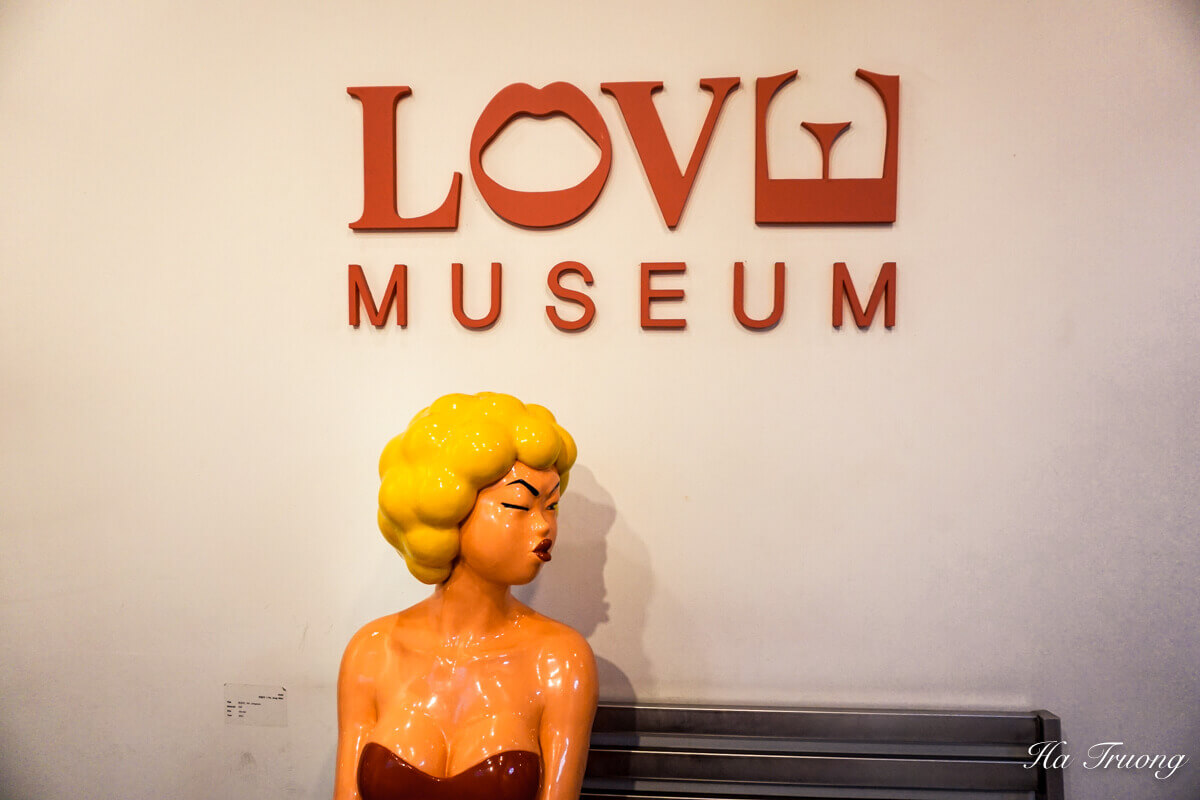
Feeling a bit ‘naughty’? Try Love Museum Seoul!
Are you looking for a unique thing to do in Seoul, South Korea? Head to Love Museum in Hongdae! Right…
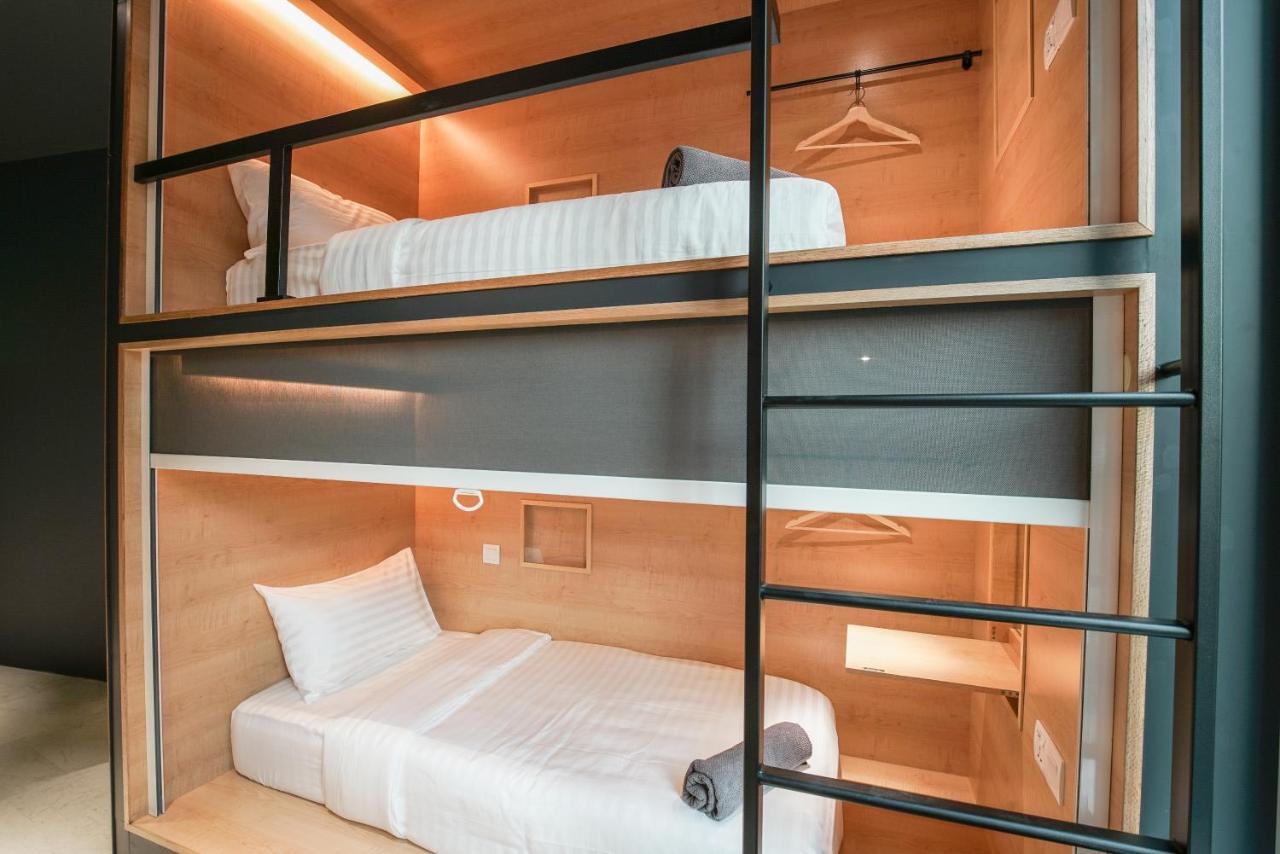
7 Best Hostels In Kuala Lumpur For Budget Travelers
Kuala Lumpur offers a blend of culture, history, and modernity that’s popular among budget travelers from around the world. In…
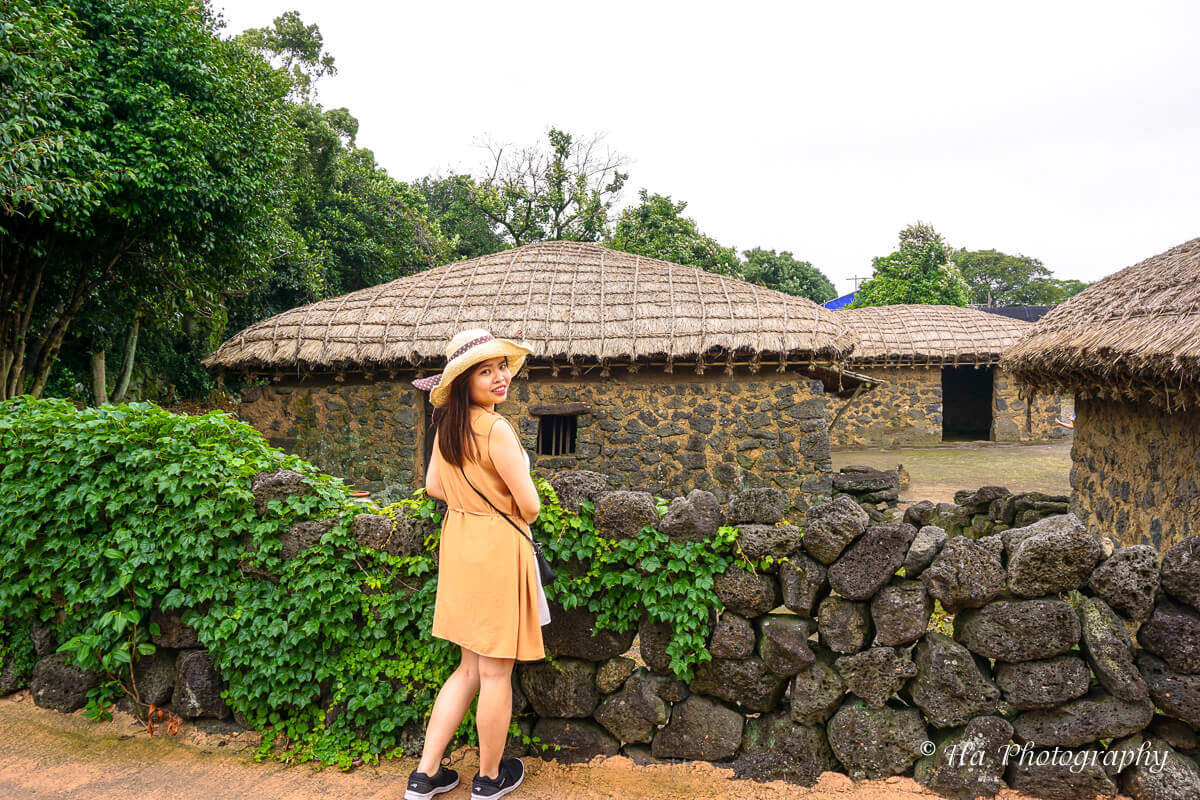
Explore Seongeup Folk Village Jeju Island, South Korea
Seongeup Folk Village is one of my favorite places on Jeju Island, South Korea. This ancient village is a fascinating…

A Detailed Guide To Sukhothai Historical Park, Thailand
Known as the capital of the first Kingdom of Siam, Sukhothai is one of Southeast Asia’s most important historical sites….
Leave a Reply Cancel reply
Your email address will not be published. Required fields are marked *
Best Time To Visit Jeju
What is the best time to visit jeju.
The best time to visit Jeju Island is during spring and autumn, from April to June and September to November. These seasons offer mild temperatures, ranging from 10°C to 20°C (50°F to 68°F), perfect for outdoor adventures like hiking and beach activities. In spring, the island blooms with colourful cherry blossoms, while autumn brings stunning foliage. Despite slightly higher accommodation prices compared to winter, these months see fewer crowds, making for a more relaxed experience. The least favourable time to visit Jeju is during winter, from December to February. The weather can be chilly and windy, with temperatures between 0°C and 10°C (32°F to 50°F), limiting outdoor activities. However, visitors can enjoy the Jeju Light Festival during this time, along with lower accommodation prices and fewer tourists. Yet, the downside is the limited availability of outdoor attractions.
Weather in Jeju

Upcoming Jeju Weather
More about best time to travel to jeju, jeju in spring (april - june), jeju in autumn (september - november), jeju in winter (december - february), related posts.

Best Time to Visit South Korea
Nearby Places

Jeju Photos


Browse Package Collections
Nearby destinations for packages, similar places.

Get the best offers on Travel Packages
Compare package quotes from top travel agents
Compare upto 3 quotes for free
- India (+91)
*Final prices will be shared by our partner agents based on your requirements.
Log in to your account
Welcome to holidify.
Forget Password?
Share this page

OneThreeOneFour is a destination wedding photography company
Ultimate Guide On The Best Time To Visit Korea’s Jeju Island
A trip to Korea is not complete without visiting its neighbouring Jeju Island. Jeju provides a stark contrast to Seoul’s cityscapes with its lush natural paradise.
Its expansive grass fields are speckled with different coloured blooms at different times of the year and they are going to be the loveliest backdrop ever!
Camellia Flower Season (January)
While the rest of the world is a piece of white or haunted by gloomy skies during winter, Jeju Island stands out with its bright pink camellias. It’s going to feel like stepping into Alice In Wonderland when you enter the garden lined with tall Camellia shrubs. This hardy flower that can withstand the winter cold, emerges more beautiful than ever.
Blooming period: Early December to end January
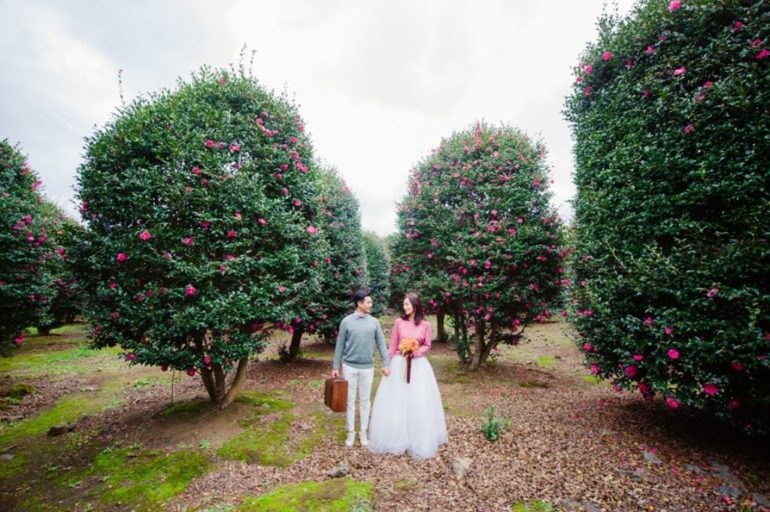
Tangerine Picking (January)
Tangerines are a popular fruit in Jeju and they can get really expensive during off-peak season. However, you get to eat to your heart’s content and even bring some home during their harvesting season in Winter! It’s an extremely fun experience to bring back from your Jeju trip!
These bright orange tangerines are not just great for eating, but also make an adorable backdrop for a photoshoot.
Harvesting period: January to March

Cherry Blossoms (March)
Spring is the most beautiful time of the year for most places and Jeju is no exception. The popular cherry blossoms that attracts thousands of tourists every year, can also be found here. In fact, Jeju Island may be a better place for viewing these lovely flowers away from the tourist crowd in Seoul!
Blooming period: Mid – End March
SEE ALSO: When To Catch The Cherry Blossoms In Korea
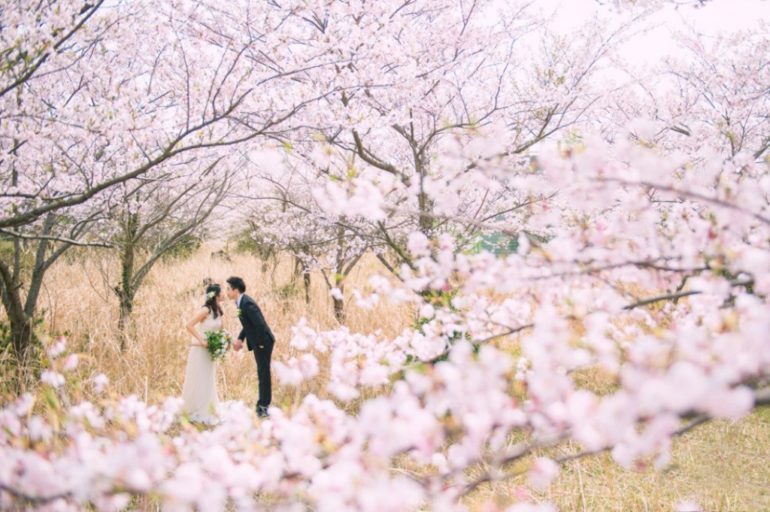
Canola Flowers (March)
Another highlight at Jeju Island during Spring is the splendour of overwhelming Canola flowers. These bright yellow flowers are an icon of Jeju and you can find a whole field of them at the foot of Mount Hallasan. You’ll be completely blown away by the view!
Blooming season: Early March to early April
SEE ALSO: 8 Hidden Photoshoot Locations In Jeju That Google Doesn’t Show You

Hydrangeas (June)
Hydrangeas are many girls’ favourite flower as its delicate pastel colours are completely swoon-worthy. The hydrangea blooms at Jeju’s Camellia Hill are out of this world as the garden is filled with more flowers than leaves! It is definitely a sight to behold and the most romantic place to be in June!
Blooming period: Mid June to mid July
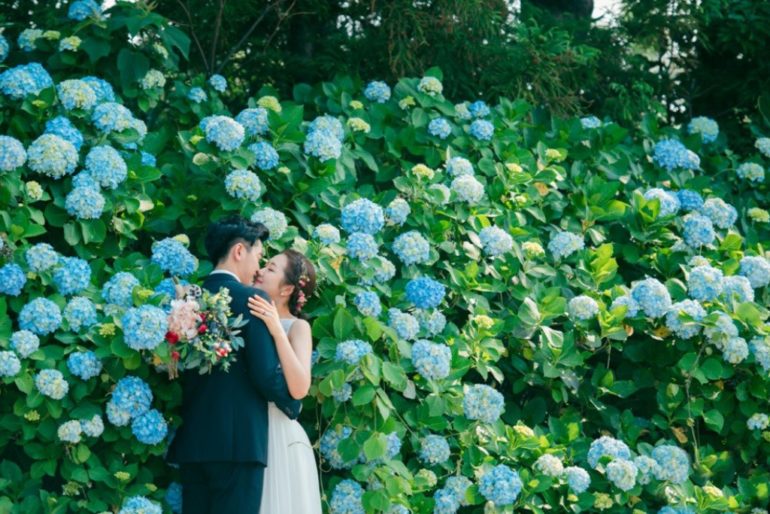
Sunflowers (August)
Sunflower fields are on the bucket lists of many people as these gorgeous yellow blooms are the perfect perk-me-ups! They are definitely one of the most photogenic flowers that exist and you’ll love the ones at Jeju.
Blooming period: Early July to mid August
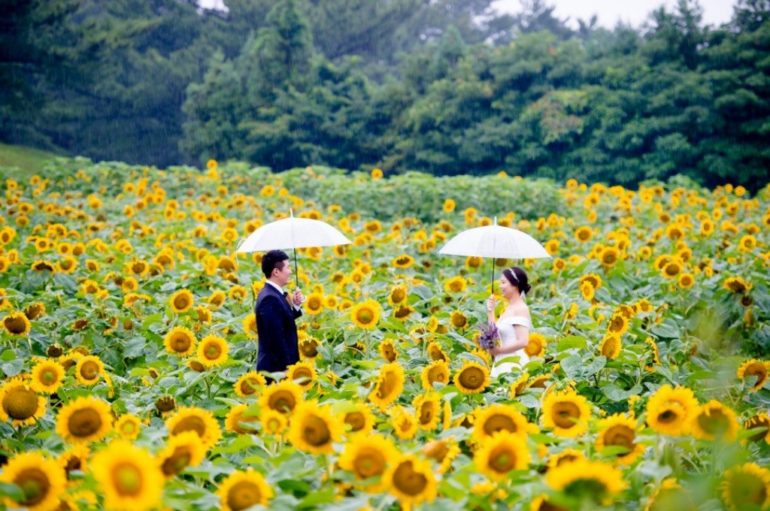
Buckwheat Flowers (September)
The famous flower in Korean Drama “Goblin” that stole all our hearts with its beautiful symbolisation for “lover”. You can find a whole sea of love here at Jeju as millions of these fluffy white blooms engulf you. Guys, you definitely have to bring your lover here if you are planning a proposal in Jeju Island!
Blooming period: September
SEE ALSO: Destination Surprise Proposal Photoshoot Packages

Cosmos Flowers (October)
Jeju Island really does not disappoint with its wide array of flowers. In the month of October, you’ll be welcomed by a galaxy of pink cosmos flowers that stretches off into the horizon. This is truly every girl’s little slice of paradise!
Blooming period: October
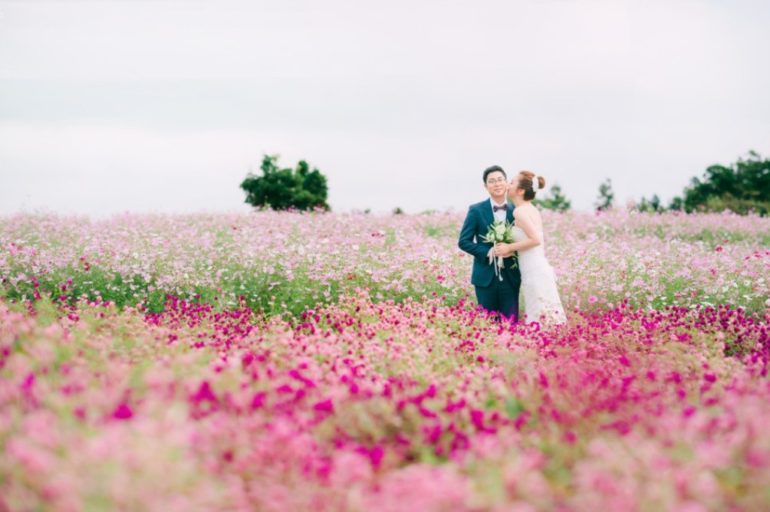
Silver Eulalia Grass (October)
Yet another great reason to visit Jeju Island in October! Besides the lovely pink cosmos, you’ll also find these fluffy Silver grass all around the trekking routes. These silver grass can grow as tall as an average human so it’s going to be an amazing experience being in the midst of these Autumn beauties!
Blooming period: October
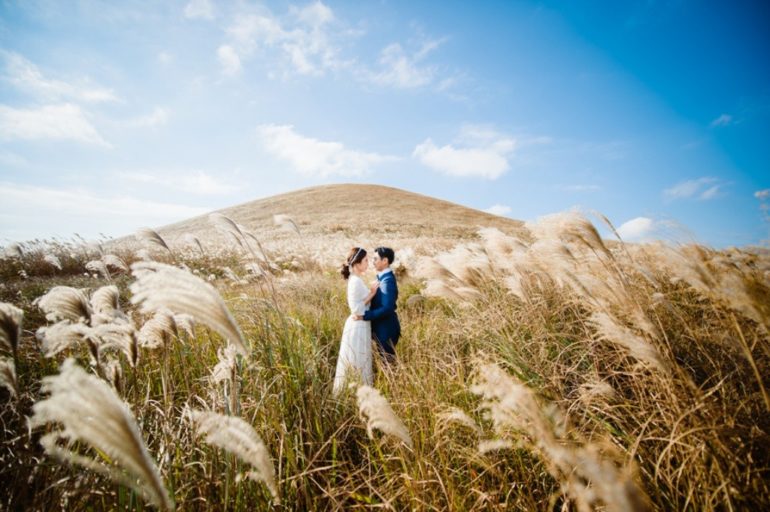
Book A Photoshoot With OneThreeOneFour
Complete your Jeju trip with a photoshoot at these stunning landscapes! Whether you want to have a casual date snap or a pre-wedding photoshoot, OneThreeOneFour is here to satisfy all your photography needs with our team of professional photographers!
Head to our website to find out more about our Jeju Island Photoshoot Packages !
10 Places To Shoot In Prague For Fairytale-Like Wedding Photos
#shesaidyes on top of the world in new zealand.
Your wedding adventure STARTS HERE
Join us for a hassle-free wedding photoshoot in your dream destination

- Skip to primary navigation
- Skip to main content
- Skip to primary sidebar
- Skip to footer
TravelAwaits
Our mission is to serve the 50+ traveler who's ready to cross a few items off their bucket list.
How To Visit South Korea’s Stunning Jeju Island

- Destinations
- South Korea
Jeju Island lies to the south of mainland South Korea. It sits between several seas — the Yellow Sea, the East China Sea, and the Sea of Japan (also known as the East Sea). Getting there is very easy if you’re in South Korea.
If you’ve read my other article on amazing things to do on Jeju Island , this article will cover more of the practical details of planning a trip there.

How To Get There From Mainland South Korea
You can travel there by plane or ferry. Jeju is a 1-hour flight from both Seoul and Busan. There are several airlines that fly there, including Korean Air. High winds in Jeju often ground or cancel flights. Make sure you have flexibility in your itinerary in case your flight is impacted. When I went, my flight back to Busan was canceled due to the winds. If your flight gets canceled, be persistent in going to your airline’s help desk to get booked onto another flight if you want to leave the same day.
You can also get a ferry to Jeju from certain ports, such as Incheon and Busan. However, it’s a long ride and much more expensive than flying.

Where To Stay
Though Jeju is a fairly small island, it has much to offer. Figuring out where to stay can be overwhelming. If you can stay at least a week, I’d recommend splitting your time between Jeju City in the north and Seogwipo in the south. It takes a little over an hour to drive between the two.
Jeju City is where the airport is located and hotels are about a 10-minute drive away. If you plan to take any day tours, most of them depart from the airport or are pick-up only at Jeju City hotels; another reason to stay in this area. You could also rent a car at the airport which is a great way to see more places.
In Jeju City, I stayed at the Gallery Hotel BnB . It’s a no-frills, budget hotel. I found the room quiet and perfectly located, about a 2-minute walk from the main street in Jeju City. If you prefer more luxurious accommodation, I recommend searching for other hotels nearby.

Staying in Seogwipo is a great way to see a very different part of the island than Jeju City. It’s easy to walk to most of the places if you don’t have a car and it was one of my favorite cities in all of South Korea. Most buses stop in Seogwipo, offering you another easy way to get around without a car. Seogwipo is next to the coast, so you can enjoy some of the beautiful water views while there.
I enjoyed the Hotel Rest Seogwipo . The budget price left me incredulous at the room. It was huge and came with its own washing machine! This is a great place to stay without a car as it’s a few minutes’ walk to downtown. If you have a car, however, you might prefer to stay at the Seogwipo KAL Hotel.

How To Get Around
There are plenty of buses, however, you’ll be at the mercy of their schedules. It can be difficult to decipher which stop gets you where you want to go and which bus you need. Full-day tours will take you to many of the major sites. Renting a car is the easiest way to see most of the island.
Pro Tip: If you plan to rent a car, make sure to get an international driver’s license in your home country before arrival. Without it, you won’t be permitted to rent a car.
Where To Eat
Visit Neulbom Heukdwaeji in Jeju City for black-pork barbecue. Be sure to go someplace where the pork is not overly greasy. It was great here, however, the staff tries to cook for you and hurry you. Be persistent, insist on cooking it yourself, and take your time.
Dae Hyang in Jeju City has some of the best Korean barbecue meat you’ll find. It’s hard to find red meat as opposed to pork barbecue on Jeju. If that’s what you’re craving, come here, and don’t leave out the Soju!
The Seogwipo Olle Market is a must. There are so many different options, including a food court just outside the main market. My favorite meal was the seafood pancake I found. It was hearty, delicious, and where I had my first taste of Makgeolli — a delightful South Korean alcohol.
Seogwipo also has a restaurant street near Cheonjiyeon Falls called Chilsimni Food Street, reputed as having some of the best restaurants in the area.
I lucked into what I thought was the best place in Seogwipo, Oneunjeong Gimbap — a gimbap restaurant. It looks like a complete dive, so I was dubious until, after placing my order, there was a line out the door. It was so good I tried to go back another night, only to find a 45-minute wait to get my food.

How Long To Stay
I would say forever, but if you don’t have that luxury, at least a week, ideally 2 or 3 weeks. There’s so much to see and being able to stay in different parts of the island in order to see more is well worth it.

Heather is a full-time travel coach who is passionate about helping professionals seeking more freedom and flexibility to ditch their desk and discover their destiny through full-time travel. She provides her clients with the path to the mindset, money, and mastery to make a full-time travel lifestyle possible. Since quitting, she's become an international best-selling author and is about to do her first TEDx talk! Learn more about Heather's travel adventures on her website, Heather Begins.
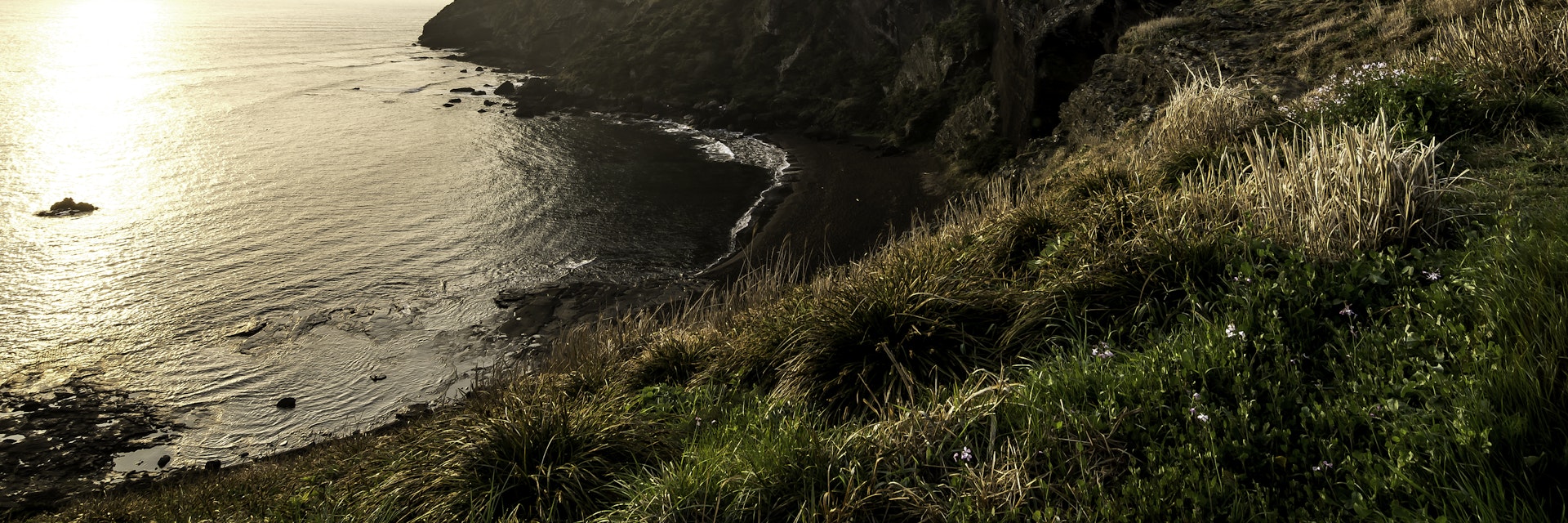
Jeju-do (제주도), Korea’s largest island, has long been the country’s favourite domestic holiday destination thanks to its beautiful beaches, lush countryside and seaside hotels designed for rest and relaxation.
Attractions
Must-see attractions.
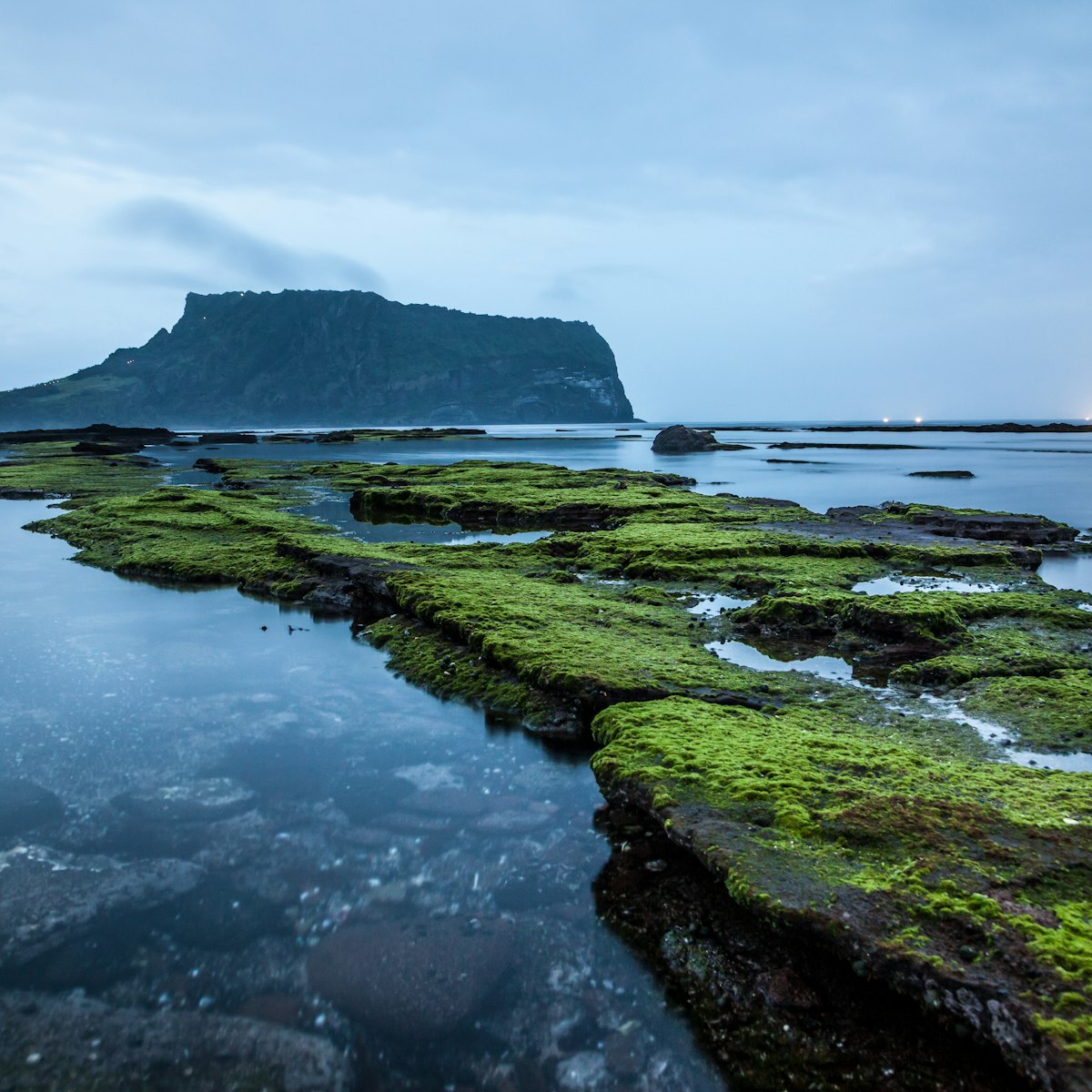
Seongsan Ilchul-bong
This majestic 182m-high, extinct tuff volcano, shaped like a giant punchbowl, is one of Jeju-do's most impressive sights and a Unesco World Heritage site…

Jeju Folk Village
The educational Jeju Folk Village gathers together traditional buildings from across the island (some reconstructions, others hundreds of years old) in an…

Arario Museum
One of the island's most interesting art projects, Arario has four galleries in renovated buildings in and around the Tapdong area hosting permanent and…

Cheonjiyeon Pokpo
This popular 22m-high waterfall is reached after a 10-minute walk through a beautifully forested, steep gorge. The waterfall can be impressive following…

Jeju April 3 Peace Park
Thoughtful and evocative, this museum chronicles the events that led up to and followed the ‘April 3 Incident’ – a series of island massacres between 1947…

Jusangjeollidae
Southern Jeju-do
Just south of the Jeju International Convention Centre is a dramatic 2km stretch of coastline known for rectangular rock columns that look as if they were…

Sanbanggul-sa
A steep, 20-minute walk up the south face of the craggy Sanbang-san is a small stone Buddha in a 5m-high cave called Sanbanggul-sa. From Sagye-ri, the…

Jeju Museum of Art
View interesting permanent and temporary exhibits of contemporary visual art at this excellent gallery next to Jeju Loveland. The beautifully designed…
Latest stories from Jeju-do
Filter by interest:
- All Interests
- Adventure Travel
- Art & Culture
- Beaches, Coasts & Islands
- Food & Drink
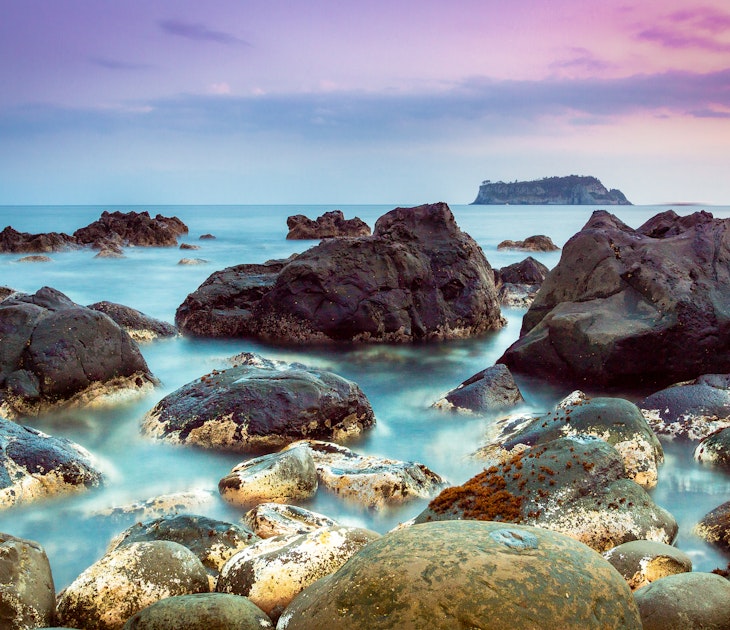
Apr 2, 2015 • 5 min read
With easy to access dormant volcanoes, hearty seaside fare and a range of hiking trails, Jeju Island has much to offer travelers.
Purchase our award-winning guidebooks
Get to the heart of Jeju-do with one of our in-depth, award-winning guidebooks, covering maps, itineraries, and expert guidance.
Jeju-do and beyond
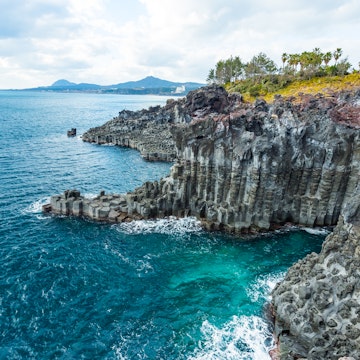
Change location
- UK / International
- Call toll-free until 6pm EDT
- 617-223-4521 617-861-6421 or
- REQUEST A QUOTE
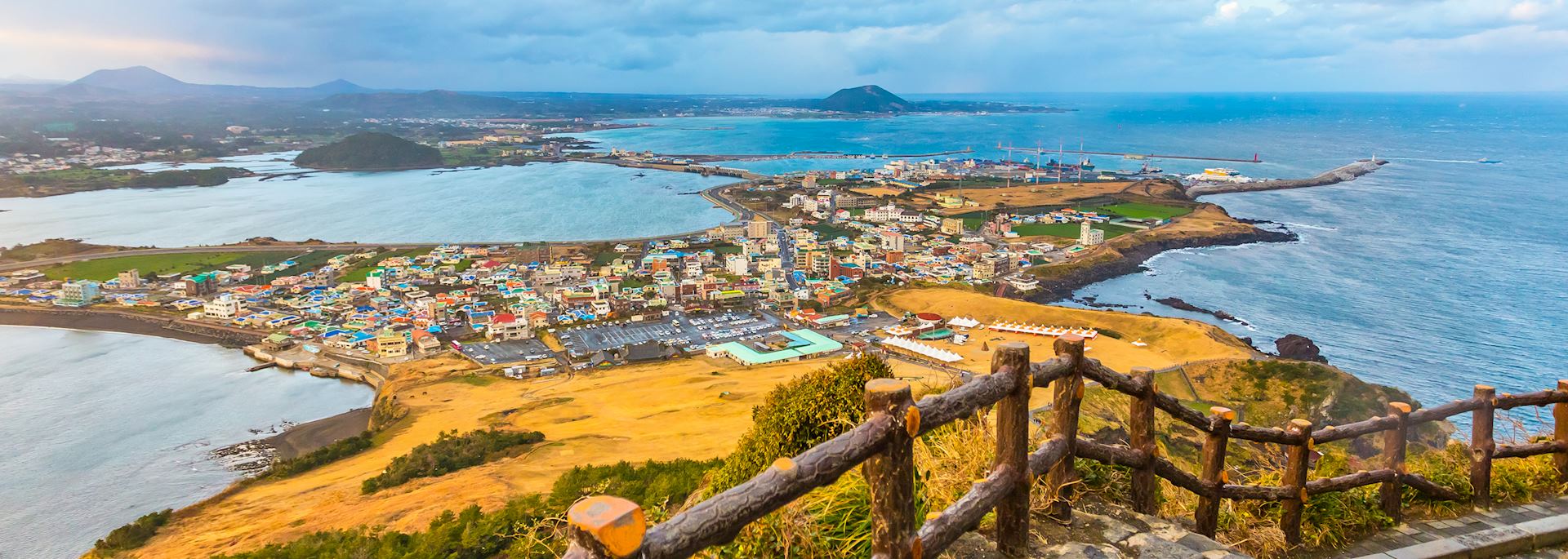
Visit Jeju island, South Korea
- Accommodation
- Things to do
Hike up South Korea’s highest peak, watch the sun rise from a volcanic crater, marvel at octogenarian free divers or simply relax on the beach on the subtropical island of Jeju. Sitting off the south coast of the Korean Peninsula, Jeju is littered with volcanic outcrops, lava tubes, waterfalls, citrus orchards, forests and beaches. Its flora and fauna and geological spectacles have led to it being protected as a Biosphere Reserve, UNESCO World Heritage Site and Global Geopark. It’s a great place to relax or hike the network of island trails at the end of your South Korea trip.

Another of the island’s most prominent features is Seongsan Ilchulbong, a 182 m (600 ft) volcanic cone that rises abruptly from the sea on the island’s east coast. It only takes about 20 minutes to climb to the forested crater rim and doing so at sunrise is a popular local tradition.
More geological anomalies can be seen at the Manjanggul lava caves where one of the world’s longest lava tubes stretches 8 km (5 miles) below the ground. You can walk along part of its length to see lava stalactites and stalagmites, cave coral and lava bridges.
Udo Island, a popular day trip from Jeju, lies just off the east coast. Its variety of beaches, volcanic landscapes and fields of flowers attract plenty of visitors. You can hike Udobong Peak for panoramic views, see the black-sand beach at Geommeolle or the white-coral beach at Hongjodangoe Haebin, before enjoying some of the fine local seafood.
Much of the region’s seafood is caught by haenyeo, Jeju’s female free divers who harvest oysters, abalone and clams and catch octopus and squid without any equipment other than knives and wetsuits. It’s a dying tradition, but one that has been ongoing for centuries and you may see the divers, many in their 70s and 80s, on the beaches at Jungmun and Seogwipo. To learn more about their lifestyle and traditions, visit the Haenyeo Museum in Gujwa-eup.
If you’d like to get out and explore the island on foot, a network of hiking tracks known as Olle Trails lead along the rugged coastline and through the interior to scenic lookouts. You can hike the entire length of the long-distance trails or just pick short sections to explore. A few to look out for include the ten-minute walk along Olle Trail 6 to Cheonjiyeon Pokpo, a waterfall that drops into an emerald pool surrounded by basalt cliffs and lush forest. Then there’s the Daepo Jusangjeolli coastline, just south of the Jeju International Convention Centre, where columns of basalt rear out of the sea on Olle Trail 8.
To get a sense of local life, it’s worth exploring Jeju city’s Dongmun street food market, a huge place selling everything from fish and seafood to local oranges, household items and souvenirs. It’s a great place to try local dishes, fresh local orange juice or sweet treats such as peanut ice cream or hotteok (cinnamon rice pastries). Nearby is Black Pork Street, a road lined with restaurants serving the island’s most renowned foodstuff, Jeju black pig. Follow the crowds to the most popular spots.
Jeju has long been a popular destination for domestic visitors, and in recent years, ease of access and liberal visa rules have attracted large numbers of Chinese tourists. Even though you can’t expect to have the most renowned views to yourself, it’s well worth a trip and not too difficult to leave the package tours behind and discover a more secluded side of the island.
The island’s hotels are clustered in three areas: Jeju city, its biggest urban hub which is on the north coast; Seogwipo city, a more secluded spot on the south coast; and the Jungmun resort area which has large, family-friendly hotels and access to some of the best beaches on the island with good snorkeling and swimming.
Best time to visit Jeju Island
Mid-March to early April is one of the best times to visit Jeju with cherry blossom, azaleas and magnolias in bloom. May and June offer pleasant weather but July and August are hot, humid and wet. Temperatures drop by September and November sees added interest with the autumnal foliage. Although cold, November to February is dry and hiking Mount Hallasan in the snow is particularly atmospheric.

Start planning your tailor-made trip to Jeju island by contacting one of our South Korea specialists
- 617-223-4521 617-861-6421
- Make an inquiry
Suggested itineraries featuring Jeju island
Our itineraries will give you suggestions for what is possible when you travel in Jeju island, and they showcase routes we know work particularly well. Treat them as inspiration, because your trip will be created uniquely by one of our specialists.
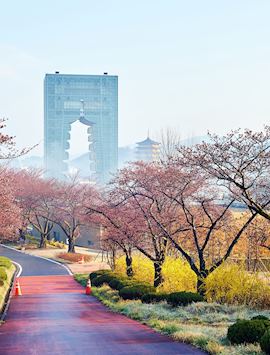
Classic South Korea tour
12 days from $6,950pp
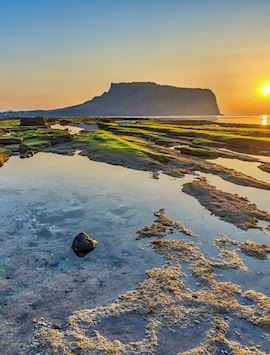
A family adventure in South Korea
10 days from $6,650pp
Map of Jeju island
Places & hotels on the map, places near jeju island.
- Busan 192 miles away
- Gyeongju 230 miles away
- Seoul 292 miles away
Photos of Jeju island
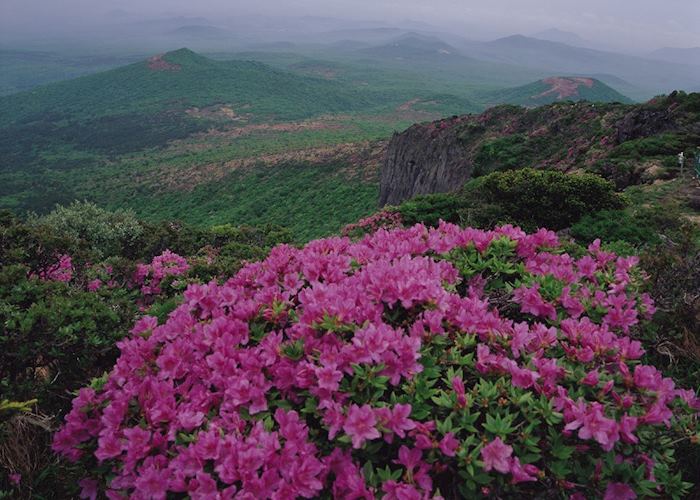
Accommodation choices for Jeju island
We’ve selected a range of accommodation options for when you visit Jeju island. Our choices usually come recommended for their character, facilities and service or location. Our specialists always aim to suggest properties that match your preferences.
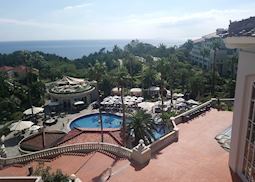
The Shilla Jeju
Ideas for experiencing jeju island.
Our specialists seek out authentic ways to get to know the places that could feature in your trip. These activities reflect some of the experiences they've most enjoyed while visiting Jeju island, and which use the best local guides.
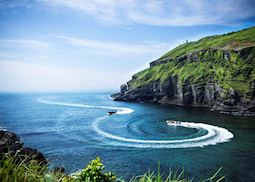
Tour of Eastern Jeju Island
Explore the volcanic cones, crater rims and lava tubes of east Jeju on a private guided tour to learn about the region’s geological history. See languid Udo Island and take in some of Jeju Island’s best views.
- Attractions & Tours
- Flight + Hotel New
- Car Rentals
- Airport Transfers
- Destinations
- Trip.com Rewards
Best Time To Visit Jeju Island: A Guide To The Perfect Trip

By Trip.com
June 12, 2023
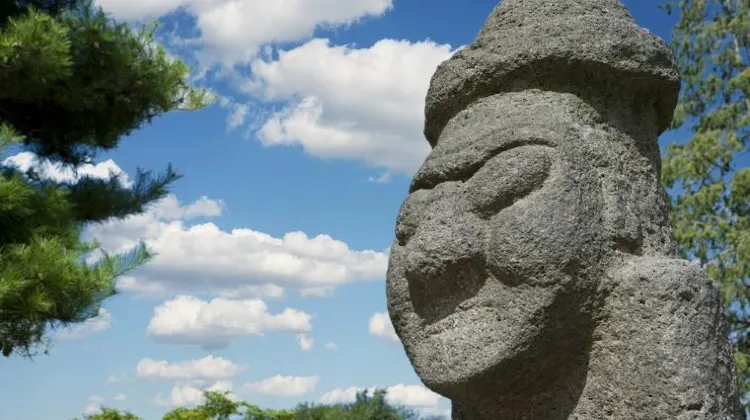
Wondering when is the best time to visit Jeju Island? You’re at the right place!
First, you've made an excellent choice! Jeju Island, located off the southern coast of South Korea, is a breathtaking destination that offers stunning natural beauty, rich culture, and unique experiences. To make the most of your visit, it's important to choose the best time to explore this enchanting island.
In this comprehensive guide, we'll walk you through the ideal seasons, weather conditions, and attractions for each time of the year, ensuring that you have an unforgettable experience on Jeju Island.
Best Time To Visit Jeju Island

There are distinct seasons at Jeju Island and each season on Jeju Island presents unique opportunities and experiences.
Whether you prefer the blooming blossoms of spring, the sun-soaked beaches of summer, the vibrant foliage of autumn, or the tranquil landscapes of winter, Jeju Island has it all.
Consider your interests, weather preferences, and desired activities when choosing the best time to visit. Plan ahead to make the most of seasonal events and festivals, and prepare accordingly for any specific weather conditions.
Remember, Jeju Island's charm is not confined to a single season. Whenever you choose to visit, you'll be greeted with the island's natural beauty, rich culture, and warm hospitality that will leave a lasting impression.
Let’s dive in!
Spring: Blossoms And Mild Weather

Spring is undoubtedly one of the best times to visit Jeju Island. From March to May, the island comes alive with vibrant cherry blossoms and colorful flower fields, creating a picturesque backdrop for your adventures.
The temperature during this time ranges from a pleasant 10°C to 20°C (50°F to 68°F), making it perfect for outdoor activities like hiking, biking, and exploring the island's natural wonders.
The Seogwipo Canola Flower Festival, held in April, is a must-visit event during the spring season. The festival showcases vast fields of golden yellow canola flowers, providing a stunning sight for nature enthusiasts and photography lovers.
Don't forget to capture the mesmerizing views of the famous Jeju Cherry Blossom Road , which transforms into a dreamlike tunnel of pink petals.
Suggested activities for Spring:
- Visit the Jeju Cherry Blossom Road, a famous spot for capturing stunning photos of the cherry blossoms in full bloom.
- Explore the stunning fields of yellow canola flowers during the Seogwipo Canola Flower Festival held in April.
- Take a leisurely stroll through Hallim Park , where you can admire a wide variety of spring flowers, including azaleas and magnolias.
Summer: Sun, Sand, And Water Sports

If you're a beach lover and enjoy basking in the sun, summer is the best time to visit Jeju Island. From June to August, the island experiences warm temperatures ranging from 20°C to 30°C (68°F to 86°F).
The clear blue skies, pristine beaches, and refreshing sea breeze create an inviting atmosphere for water activities, such as swimming, snorkeling, and scuba diving.
Hyeopjae Beach and Hamdeok Beach are popular choices for sun-seekers, offering soft white sand, crystal-clear waters, and mesmerizing coastal landscapes. These beaches also provide excellent opportunities for water sports enthusiasts, with options for jet skiing, paddleboarding, and banana boat rides.
Suggested activities for Summer
- Relax and soak up the sun at Hyeopjae Beach or Hamdeok Beach , both known for their soft white sand and crystal-clear waters.
- Explore the underwater world by going snorkeling or scuba diving at popular diving spots like Jungmun Beach or Seogwipo Maeil Olle Market Beach.
- Take a thrilling jet ski ride or try your hand at paddleboarding along the picturesque coastline.
Autumn: A Tapestry Of Colors

Autumn is a magical time to visit Jeju Island when the landscape is adorned with vibrant hues of red, orange, and gold. From September to November, the island experiences mild temperatures ranging from 15°C to 25°C (59°F to 77°F), creating comfortable weather for outdoor exploration.
Seopjikoji , a scenic coastal area, is a must-visit spot during the autumn season. The combination of rocky cliffs, emerald-blue waters, and colorful foliage creates a breathtaking panorama. Be sure to embark on a hike up Hallasan Mountain, to witness the stunning autumn foliage from above.
Suggested activities for Autumn
- Embark on a hike up Hallasan National Park , scale the highest peak in South Korea, and witness the breathtaking autumn foliage from above.
- Explore the scenic coastal area of Seopjikoji, which offers stunning views of rocky cliffs, emerald-blue waters, and colorful foliage.
- Visit the Jeju Stone Park , where you can admire unique rock formations amidst the vibrant autumn colors.
Winter: Tranquility And Sublime Landscapes

While winters on Jeju Island can be chilly, with temperatures ranging from 0°C to 10°C (32°F to 50°F), it offers a unique and serene experience for travelers seeking tranquility and untouched landscapes. The island is less crowded during this season, allowing you to enjoy its natural wonders in peace.
Visit Manjanggul Cave , a UNESCO World Heritage site, to marvel at the stunning lava tube formations. The cave's underground pathways, adorned with stalactites and stalagmites, create an otherworldly atmosphere. Additionally, don't miss out on the Seongsan Ilchulbong Peak, also known as Sunrise Peak, which offers breathtaking views of the sunrise over the dramatic volcanic crater.
Suggested activities for Winter
- Explore the mesmerizing Manjanggul Cave, a UNESCO World Heritage site, known for its stunning lava tube formations.
- Capture the dramatic sunrise over the volcanic crater at Seongsan Ilchulbong Peak, also known as Sunrise Peak.
- Visit the Jeju Glass Castle , where you can appreciate exquisite glass art installations while escaping the winter chill.
Do check out our Jeju Island travel guide for more ideas and things to do when you’re there!
FAQs: Best Time To Visit Jeju Island
What is the peak tourist season on jeju island, is jeju island crowded during the cherry blossom season, are there any monsoon seasons on jeju island, are there any indoor attractions on jeju island for winter visitors, are there any festivals or events held on jeju island throughout the year, best time to visit jeju island conclusion.
In conclusion, the best time to visit Jeju Island depends on your personal preferences and the experiences you seek.
Spring offers blooming flowers and mild weather, while summer invites you to enjoy the island's beautiful beaches and water activities. Autumn enchants visitors with its colorful foliage, and winter provides a serene and tranquil atmosphere. Consider the weather, crowd levels, and seasonal attractions when planning your trip to ensure an unforgettable experience on this captivating island.
So pack your bags, prepare for an adventure, and get ready to make memories that will last a lifetime on Jeju Island.
- 1. Best Time To Visit Jeju Island
- 2. Spring: Blossoms And Mild Weather
- 3. Summer: Sun, Sand, And Water Sports
- 4. Autumn: A Tapestry Of Colors
- 5. Winter: Tranquility And Sublime Landscapes
- 6. Best Time To Visit Jeju Island Conclusion
<h3>Find Cheap Deals & Discover Destinations</h3>
Popular Content
- public holiday 2024
- maxwell food centre
- newton food centre
- Cheap Flight
- tiong bahru market
- hawker centres
- singapore arrival card
- old airport road food centre
- Universal Studios Japan
- MRT map Singapore
- travel adapter guide
- busan to jeju
- bangkok bts map
- what happens if you lose your passport overseas
- siam premium outlet shuttle bus
Popular Flight Routes
- Flights Bristol to Pisa
- Flights Austin to San Juan
- Flights Glasgow to Bournemouth
- Flights Detroit to San Juan
- Flights Norwich to Manchester
- Flights Mumbai to Goa
- Flights Mumbai to Bengaluru
- Flights Mumbai to Dubai
- Flights Melbourne to Sydney
- Flights Toronto to Vancouver
- Flights London to Paris
- Flights Goa to Mumbai
- Flights Ahmedabad to Mumbai
- Flights Vancouver to Toronto
- Flights Hyderabad to Goa
- Flights Pune to Bengaluru
- Flights Toronto to Calgary
- Flights Mumbai to Kolkata
- Flights Bengaluru to Hyderabad
- Flights New York to Miami
Popular Hotels
- Hotels in Cetara With Gyms
- Anseong Lake Hotel Promo Code
- Hotels in Sarsai Naru
- Hotels in Drexel Heights
- Hotels in Winseldorf
- Hotels near Air Force Museum
- Hotels near National Motorcycle Museum
- Hotels near Byron Bay
- Hotels near University of Dallas
- Hotels near Field
- Burchmulla Resort
- Yeste Hotel (Guilin Railway Station, Xiangbi Mountain, Two Rivers and Four Lakes)
- TILL BRIGHT HOTEL (Wanda Plaza store of Huaihua High Speed Railway South Station)
- Sardegna Hotel - Suites & Restaurant
- Sunny Melati Canggu Private 3Brvilla
- Padma Resort Ubud
- Hotel Wood Takayama
- Bergen Boutique Hotels
- Pet Friendly Hotels in Biloxi
Popular Attractions
- n seoul tower
- gardens by the bay
- osaka castle
- phi phi islands
- legoland Malaysia
- skytropolis indoor theme park
- universal studios singapore map
- marina bay sands
- singapore discovery centre
Travel Deals & Discounts
- Trip.com Promotion Codes
- Trip.com Exclusive Flight Deals
- Trip.com Credit Card Promotions
- How to book Cheap Hotels
- How to book Cheap Flights
- Refer a Friend & Earn!
- Weekly Travel Deals
- Customer Support
- Service Guarantee
- More Service Info
- Website Feedback
- About Trip.com
- Terms & Conditions
- Privacy Policy
- About Trip.com Group
Other Services
- Investor Relations
- List My Hotel
- Become a Supplier
- Best Time to Visit Jeju
- How To Reach Jeju
- Events & Festivals in Jeju
- Restaurants in Jeju
- Things To Do in Jeju
- Jeju Itineraries
- Jeju Hotels
Weather and Seasons in Jeju
- South Korea
Best Time To Visit Jeju
Jeju Has a climate that can be described either as humid subtropical or humid temperate. There is no dry season; it rains throughout the year. The wettest months are May - September. Summers are very warm, and winters are relatively cooler. The best time to visit Jeju is Mid-March to early April as the weather will be mild.
The seasons of Jeju are:
- Spring: April - May: Temperatures are pleasant in the daytime and relatively low at night. Average low temperatures in April are 10.2 degrees Celsius. Average high temperatures in May are 21.6 degrees Celsius.
- Summer: June to September: This is the wettest season. Temperatures rise steadily until August, reaching a peak of 30 degrees Celsius on average. September is cooler. Between July and September temperatures at night are as warm as day.
- Autumn: October: Temperature and precipitation both begin t drop sharply, hovering between 15 and 21 degrees Celsius.
- Winter: November to March: Temperatures drop steadily until January; the average daily mean is 5.3 degrees Celsius. It begins to get warmer in February.
- All things considered, the best time to visit, is when it is not raining.
- 20℉ 0℉
Highest temperature in Jeju is recorded as 96.8℉ in July.
Lowest temperature in Jeju is recorded as 30.2℉ in February.
Most humid month in Jeju is June.
Least humid month in Jeju is March.

- Everyday : 09:00 AM to 04:00 PM
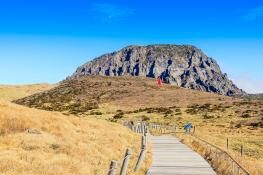
- Everyday : 12:00 PM to 01:00 PM
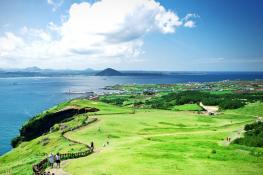
- Everyday : 08:00 AM to 02:00 PM
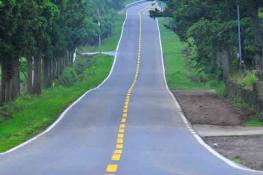
- Everyday : 08:00 AM to 04:00 PM

What’s The Best Time To Visit Jeju Island?
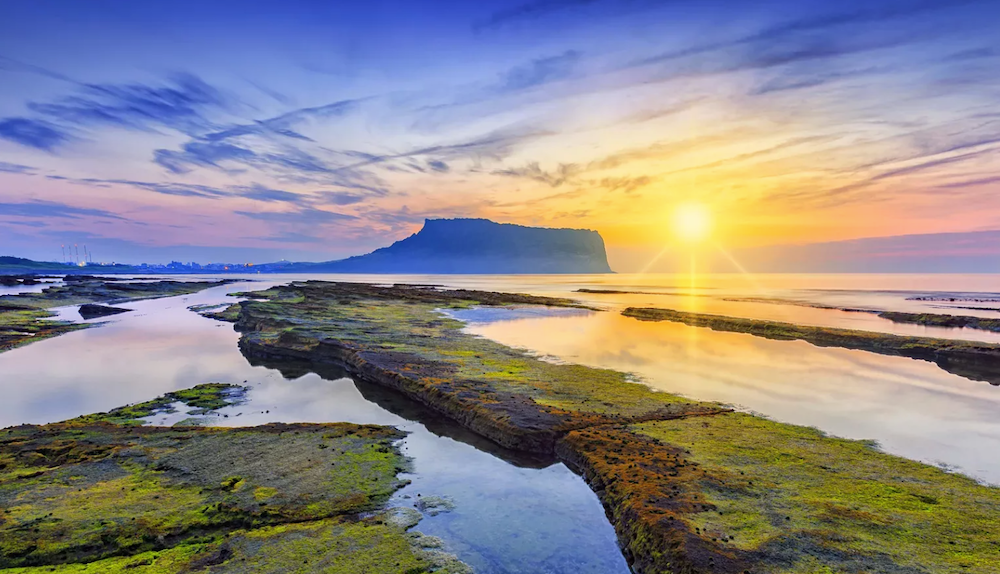
Want to discover when is the best time to visit Jeju Island in South Korea?
Nestled off the southern coast of South Korea, Jeju Island emerges as a gem in the vast expanse of the Pacific Ocean.
Known for its volcanic landscape, lush greenery, and pristine beaches, Jeju Island offers a sanctuary for nature lovers and adventure seekers alike.
This island, the largest in South Korea, is not just a natural wonder but also a place steeped in rich cultural heritage, making it a unique blend of beauty, tradition, and modernity.
Its significance goes beyond just geographical; Jeju Island is a testament to the harmonious coexistence of people and nature, attracting millions of visitors from around the globe each year.
Jeju Island’s popularity as a travel destination is not unfounded.
From the majestic Hallasan Mountain, a dormant volcano at its heart, to the serene beauty of its sandy beaches and the mystical allure of its lava tubes, the island promises an array of experiences.
Add to this the temperate climate, which provides a welcoming atmosphere year-round, and it’s clear why Jeju holds a special place in the hearts of travelers.
However, like any travel destination, the experience of visiting Jeju Island can vary greatly depending on the time of year.
Factors such as weather, tourist crowds, and local events play a significant role in shaping your visit.
Therefore, understanding the best time to visit Jeju Island is crucial for planning a trip that aligns with your travel preferences, whether you’re seeking adventure, relaxation, or cultural immersion.
In this article, we aim to guide you through the intricacies of Jeju Island’s seasonal offerings, helping you pinpoint the best time to visit Jeju Island.
By considering the island’s climate, seasonal activities, and cultural events, we’ll provide you with all the information needed to make an informed decision on when to embark on your Jeju adventure.
Join us as we explore the allure of Jeju through the seasons, ensuring your trip is nothing short of spectacular.
Overview of Jeju Island’s Climate
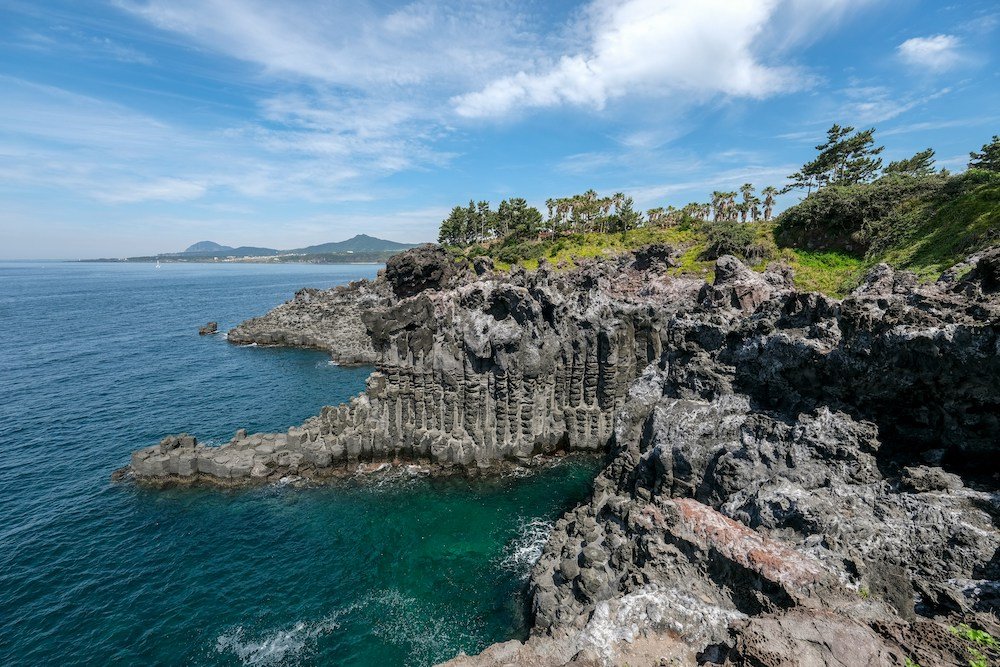
Jeju Island, with its unique geographical location and topography, boasts a mild subtropical climate that sets it apart from the rest of South Korea.
The island experiences four distinct seasons, each bringing its own set of characteristics and beauty.
This climate plays a pivotal role in shaping the island’s natural environment and, by extension, the activities and experiences available to visitors.
Subtropical Climate and Seasonal Changes
The subtropical climate of Jeju Island ensures relatively warm temperatures year-round, making it an attractive destination for those seeking escape from colder climates.
Winters are mild and short, while summers are warm but not excessively hot, thanks to the moderating effects of the surrounding ocean.
Spring and autumn are particularly pleasant, offering an ideal balance of sunny days and cool breezes.
- Spring (March to May) is a time of renewal, with cherry blossoms and a plethora of other flowers blooming across the island, painting the landscape in vibrant colors.
- Summer (June to August) brings warmer temperatures and an increase in rainfall, marking the monsoon season. Despite the occasional showers, the beauty of Jeju’s beaches and waterfalls can be fully appreciated during this lush, green season.
- Autumn (September to November) is characterized by cooler temperatures and less rainfall, making it a perfect time for outdoor activities and exploring the island’s natural wonders without the summer crowds.
- Winter (December to February) is mild compared to mainland Korea, with occasional snowfall that adds a magical touch to the island’s volcanic landscapes and Hallasan Mountain.
Impact on Tourism and Activities
The climate of Jeju Island significantly influences the types of activities available and the overall tourist experience.
For instance, the mild winters allow for year-round hiking, including ascents of Hallasan Mountain, South Korea’s highest peak.
Meanwhile, the vibrant spring season is ideal for flower festivals and outdoor explorations, attracting nature enthusiasts and photographers.
Summer, despite being the wettest season, is a popular time for beachgoers and water sports aficionados. T
he warm ocean waters and lush landscapes provide a perfect backdrop for adventure and relaxation.
However, visitors during this season should be prepared for sporadic rain showers and plan accordingly.
Autumn’s cooler weather and reduced rainfall make it an excellent time for long hikes, cultural festivals, and enjoying the island’s outdoor attractions without the intensity of the summer heat or the crowds.
This season is often recommended as the best time to visit Jeju Island for those looking to experience its natural beauty in a more serene setting.
Understanding Jeju Island’s climate and how it varies throughout the year is crucial for planning your visit.
Whether you’re drawn to the island for its outdoor adventures, cultural experiences, or simply to bask in its natural beauty, knowing the best time to visit Jeju Island based on your personal preferences and the activities you wish to enjoy will ensure a more fulfilling and enjoyable trip.
Seasonal Breakdown
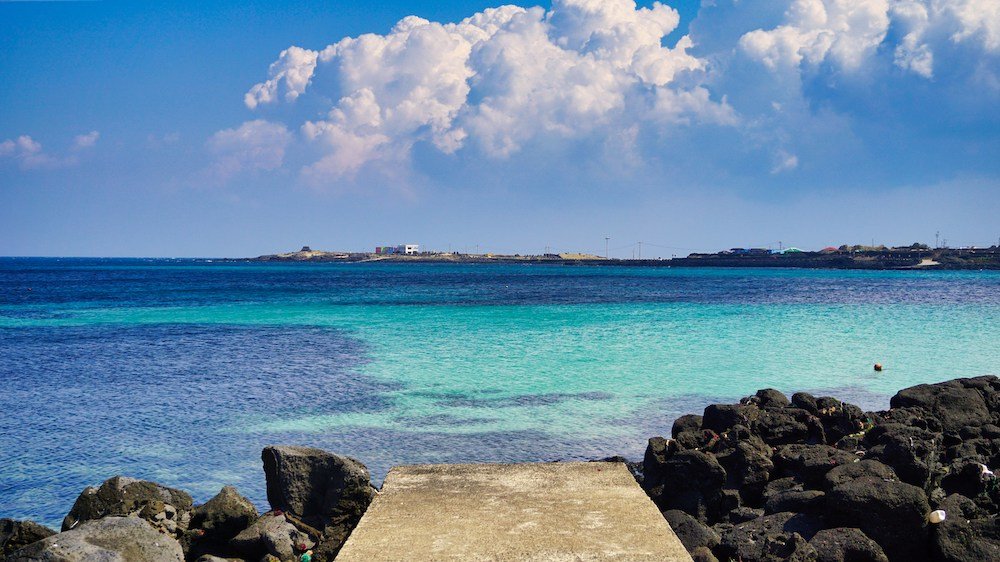
Jeju Island’s distinct seasons each offer unique experiences, catering to a wide range of interests and preferences.
Here’s what you can expect in terms of weather, activities, and tourist dynamics throughout the year.
Spring (March to May)
Weather Conditions: Spring on Jeju Island is a spectacle of mild temperatures and blooming nature. The island comes alive with cherry blossoms and a myriad of other spring flowers, creating a picturesque landscape that’s hard to resist.
Recommended Activities: This season is perfect for attending vibrant flower festivals, such as the Jeju Cherry Blossom Festival. Outdoor enthusiasts will enjoy hiking trails, including the scenic paths of Hallasan Mountain, and the weather is also ideal for exploring Jeju’s numerous theme parks, like Eco Land or the Jeju Loveland.
Crowds and Prices: Spring attracts a moderate number of tourists, especially during the cherry blossom peak. Prices for accommodations can be higher during festival periods, but overall, this season offers a good balance between pleasant weather and manageable tourist numbers.
Summer (June to August)
Weather Conditions: Summer brings warm temperatures and high humidity, alongside the monsoon season known as Jangma. Despite the rain, the island’s lush landscapes and vibrant greenery are at their peak.
Recommended Activities: The warm ocean waters make this the best time for beach visits, water sports, and exploring the island’s famous waterfalls, such as Cheonjiyeon and Jeongbang. The Jeju Fire Festival, held in early summer, is another attraction not to be missed.
Crowds and Prices: Summer marks the peak tourist season on Jeju Island, with domestic and international visitors flocking to its shores. Consequently, prices for flights and accommodations are at their highest, and popular sites can be crowded.
Autumn (September to November)
Weather Conditions: Autumn ushers in cooler temperatures and a dramatic display of foliage across the island’s landscapes, making it an ideal time for nature lovers.
Recommended Activities: The season is perfect for hiking, especially along the Jeju Olle Trail, which offers breathtaking views of the autumn colors. Cultural festivals abound, providing a glimpse into the island’s rich heritage.
Crowds and Prices: Tourist numbers dwindle, leading to more favorable pricing for accommodations and services. The weather is conducive to outdoor activities without the discomfort of summer’s heat or the crowds, making autumn an excellent choice for those seeking a more tranquil Jeju experience.
Winter (December to February)
Weather Conditions: Winter on Jeju Island is relatively mild, with occasional snowfall that adds a unique charm, especially to the volcanic landscapes and Hallasan Mountain.
Recommended Activities: It’s a great time for winter sports in the mountainous regions, relaxing in hot springs, and enjoying indoor attractions without the rush of peak seasons. The Seogwipo Citrus Festival showcases Jeju’s famed tangerines and offers a taste of local culture.
Crowds and Prices: This season sees the fewest tourists, resulting in lower prices for flights and accommodations. It’s an ideal time for budget travelers or those wishing to avoid crowds, with the added bonus of experiencing Jeju’s winter beauty.
Best Time for Specific Interests
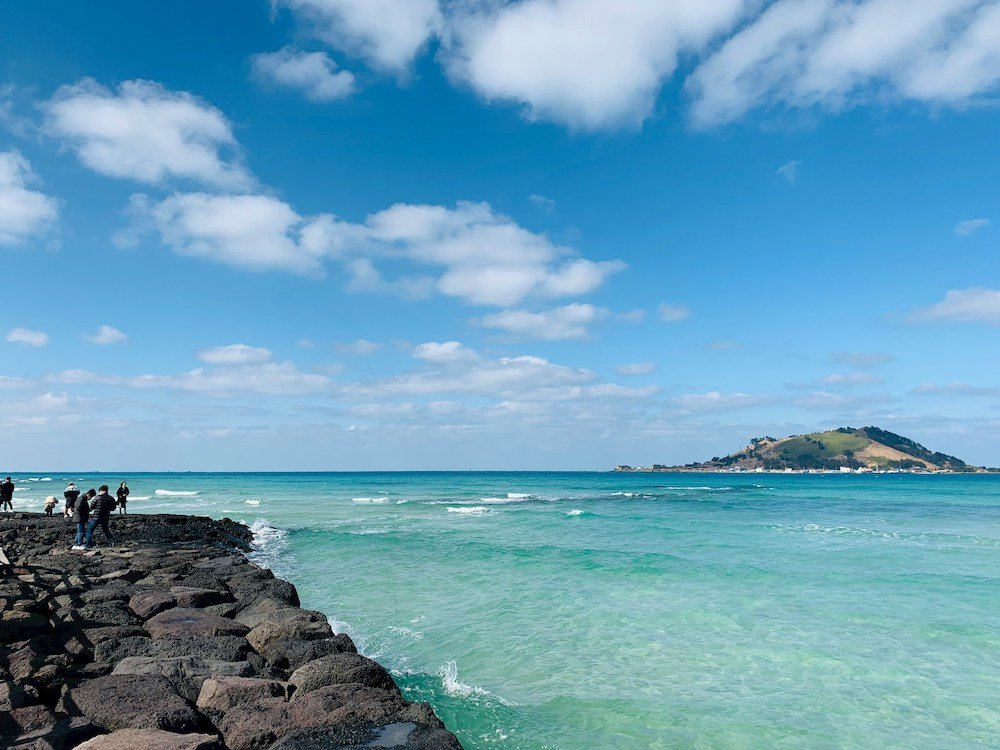
Jeju Island offers a diverse range of activities and experiences, catering to various interests.
Whether you’re an outdoor enthusiast, a culture buff, or someone looking to unwind, the timing of your visit can significantly enhance your experience. Here’s when to visit based on your interests:
Outdoor Activities and Adventure
For those drawn to the great outdoors and seeking adventure, spring (March to May) and autumn (September to November) are the best times to visit.
The mild weather during these seasons is ideal for hiking, enabling you to fully appreciate Jeju Island’s natural beauty without the extreme heat or cold.
Spring brings the added bonus of blooming flowers, while autumn offers the spectacle of vibrant foliage.
Water sports enthusiasts will find summer (June to August) to their liking, as the warmer sea temperatures are perfect for swimming, diving, and other water-based activities.
Cultural Experiences
If immersing yourself in local culture and attending festivals is your priority, spring and autumn are again the seasons to target.
These periods are rich with cultural events, from the Jeju Fire Festival in early spring to the Jeju Chuseok Festival in autumn.
Museums and indoor exhibitions can be enjoyed year-round, but visiting during these seasons combines the comfort of mild weather with the opportunity to engage in outdoor cultural activities and festivals.
Relaxation and Leisure
For those looking to relax and enjoy Jeju’s resorts or prefer a quieter, more leisurely experience, late autumn (late October to November) and winter (December to February) are ideal.
These times offer the dual advantages of fewer tourists and lower prices, making it easier to enjoy Jeju’s scenic beauty in peace.
Winter, in particular, provides a unique opportunity to enjoy the island’s hot springs, offering relaxation amidst cooler temperatures and the serene winter landscape.
Special Considerations
- Summer is perfect for beach lovers but be prepared for higher tourist numbers and prices.
- Winter offers the unique charm of Jeju’s snowscapes, especially around Hallasan Mountain, and is the best time for those seeking solitude and the beauty of a quieter Jeju.
Best Things to Do in Jeju Island
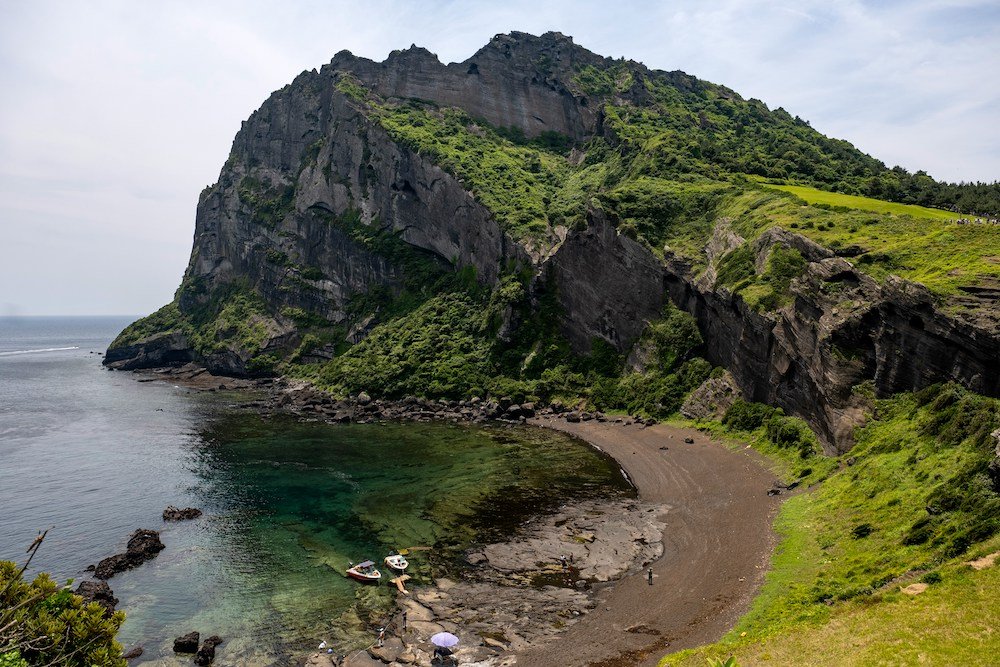
Jeju Island, a treasure trove of natural beauty and cultural richness, offers a plethora of activities and attractions for every type of traveler.
Whether you’re an adventure seeker, a culture enthusiast, or simply in need of a peaceful retreat, Jeju has something special for you.
Here’s a curated list of must-see and must-do experiences to ensure you make the most of your visit to this unique destination.
Explore Natural Wonders
- Hallasan Mountain : Dominating the island’s landscape, Hallasan is South Korea’s highest peak and a haven for hikers. The mountain offers various trails that cater to all levels of fitness, each leading to the summit for panoramic views of the island and beyond.
- Jeongbang Waterfall : This stunning waterfall is unique as it is one of the few in the world that falls directly into the ocean. The sound of the water, the sea spray, and the scenic backdrop make for an unforgettable experience.
- Manjanggul Cave : Venture into the subterranean world of Manjanggul Cave, one of the longest lava tubes on the planet. The cave is a natural marvel, showcasing the geological beauty that lies beneath Jeju’s surface.
Experience Jeju’s Beaches
- Hyeopjae Beach : Known for its soft white sand and crystal-clear blue waters, Hyeopjae Beach is perfect for swimming, sunbathing, and picnics. The beach is also a great spot to watch the sunset over the ocean.
- Udo Island : Just a short ferry ride from Jeju, Udo Island offers stunning beaches, vibrant marine life, and unique landscapes. It’s an ideal destination for a day trip, with plenty to explore and enjoy.
Discover Cultural Sites
- Seongsan Ilchulbong (Sunrise Peak) : This UNESCO World Heritage site is famous for its dramatic crater and is best visited at sunrise for a breathtaking view of the sun rising over the sea.
- Jeju Folk Village : Step back in time at Jeju Folk Village, where you can explore traditional houses, learn about Jeju’s unique culture, and experience the island’s way of life in the past.
Adventure and Leisure Activities
- Jeju Olle Trail : Spanning the island, the Jeju Olle Trail is a network of paths that take you through coastal areas, villages, and fields, offering a unique way to experience Jeju’s diverse landscapes.
- Theme Parks and Museums : For family fun, visit attractions like Loveland, Teddy Bear Museum, or Eco Land Theme Park, each offering a unique experience that blends entertainment with education.
- Diving and Water Sports : The waters around Jeju are teeming with marine life, making it a prime location for scuba diving, snorkeling, and various water sports.
Culinary Experiences
- Local Cuisine : Jeju’s culinary scene is as diverse as its landscape. Don’t miss out on trying local specialties such as black pork BBQ, fresh seafood, and Jeju tangerines, each bursting with flavor.
- Traditional Markets : For an authentic taste of Jeju, visit markets like Dongmun Market. Here, you can sample local delicacies, shop for souvenirs, and immerse yourself in the bustling atmosphere.
Wellness and Relaxation
- Spa and Wellness : Indulge in a rejuvenating experience at a traditional Korean spa (jjimjilbang) or one of the many wellness resorts on the island, offering treatments that blend modern techniques with traditional healing practices.
- Beachside Relaxation : With its numerous pristine beaches, Jeju is the perfect place to unwind. Spend your days lounging by the sea, soaking up the sun, and enjoying the tranquil beauty of the island.
Tips for Visiting Jeju Island
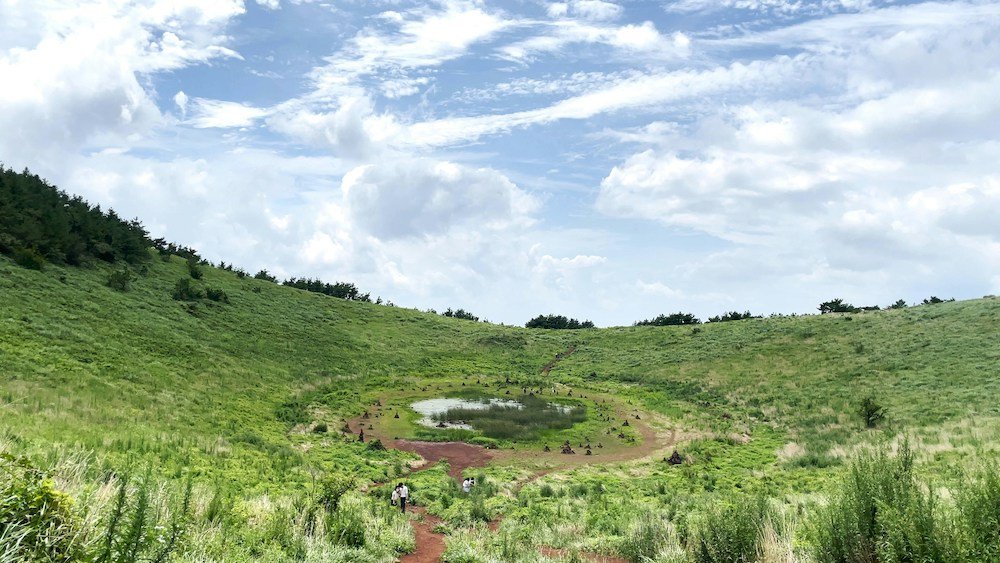
A trip to Jeju Island is a journey into a world of natural beauty, rich culture, and unforgettable experiences.
To make the most of your visit, consider these practical tips on accommodation, transportation, and respecting local customs and etiquette.
Accommodation
Booking Strategies: Plan and book your accommodation in advance, especially if you’re visiting during peak seasons (summer and spring).
Jeju offers a range of options from luxury resorts to budget guesthouses and Airbnb rentals.
For the best rates and choices, consider booking several months ahead of your trip.
Recommended Areas:
- Jeju City: Ideal for first-time visitors, offering easy access to the airport, local attractions, and shopping.
- Seogwipo: Perfect for those seeking a more scenic and tranquil setting, closer to natural attractions on the southern side of the island.
- Jungmun: A great choice for luxury travelers, known for its resorts, beaches, and proximity to the Jeju International Convention Center.
Transportation
Getting to Jeju: Jeju International Airport serves as the main gateway to the island, with frequent flights from major cities in South Korea and select international destinations.
Ferries are another option, though less common, available from mainland ports like Busan and Incheon.
Getting Around Jeju:
- Rental Cars: Renting a car is the most convenient way to explore Jeju, offering flexibility to visit off-the-beaten-path locations. International visitors will need an International Driving Permit (IDP).
- Public Transportation: Jeju’s bus system connects major attractions, cities, and towns, making it a viable option for those without a car. English route information is available, but planning ahead is recommended.
- Taxis and Ride-Sharing: Taxis are readily available and relatively affordable. Ride-sharing apps also operate on the island, providing an alternative for short distances.
Local Customs and Etiquette
Respecting Nature: Jeju’s natural landscapes are precious. Always stay on marked trails when hiking, avoid littering, and respect wildlife habitats.
Cultural Respect: When visiting cultural sites and temples, dress modestly and follow any posted guidelines. It’s also polite to remove your shoes before entering traditional homes or certain indoor spaces.
Interacting with Locals: Jeju’s residents are known for their hospitality. A friendly greeting in Korean (“Annyeonghaseyo”) goes a long way. Be mindful of local customs, and always ask permission before taking photos of people.
Environmental Practices: Participate in eco-friendly practices by reducing waste, using public transport or eco-friendly vehicles, and supporting local businesses that prioritize sustainability.
By following these tips, you’ll not only ensure a smoother trip but also contribute positively to the preservation of Jeju Island’s unique environment and culture.
Enjoy your journey to this incredible South Korean island, where every visitor has the opportunity to create lasting memories.
Jeju Island, with its stunning natural landscapes, rich cultural heritage, and diverse activities, offers a unique destination for travelers from around the world.
Throughout this guide, we’ve explored the best times to visit Jeju Island, catering to a wide range of interests and preferences.
Whether you’re drawn to the outdoor adventures awaiting on the trails of Hallasan Mountain, the cultural festivities that bring the island’s traditions to life, or the serene beauty of Jeju’s beaches and natural wonders, timing your visit can significantly enhance your experience.
Spring (March to May) emerges as a vibrant time for flower enthusiasts and hikers.
Summer (June to August), with its warm weather and lush landscapes, is perfect for beach lovers and water sports aficionados.
Autumn (September to November) offers a picturesque backdrop for outdoor activities and cultural exploration without the crowds.
Meanwhile, winter (December to February) provides a quieter, more reflective time to enjoy Jeju’s scenic beauty and unique winter activities.
As you plan your trip to Jeju Island, remember the importance of booking accommodations and transportation in advance, especially during peak seasons.
Embrace the local culture and customs with respect, and take steps to protect the beautiful environment that makes Jeju so special.
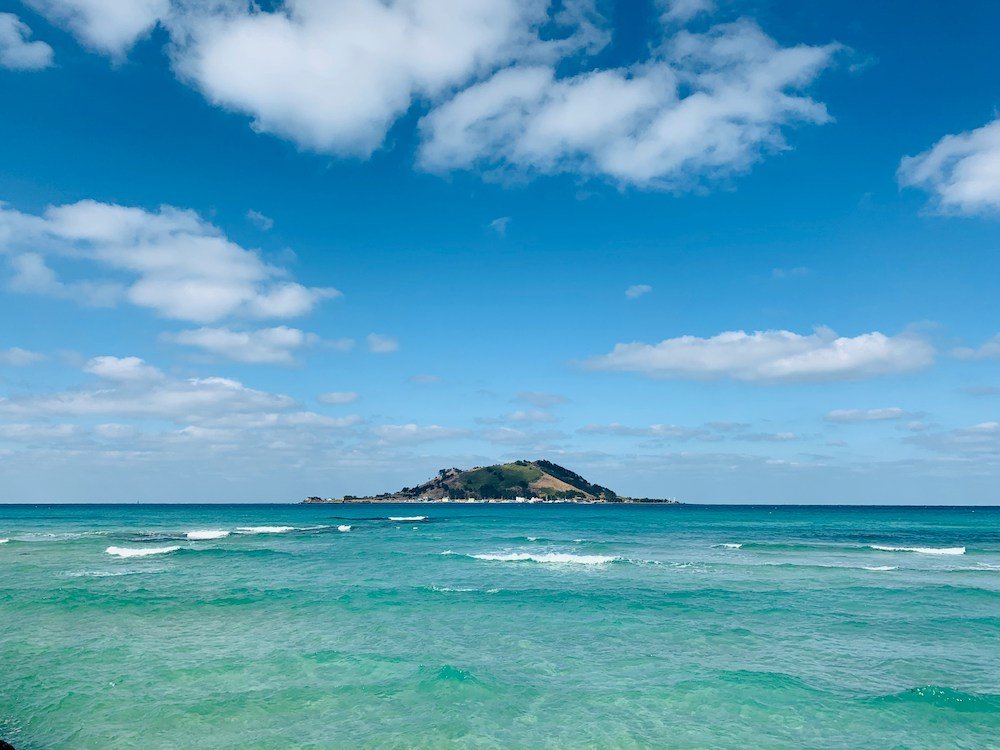
FAQ’s About Jeju Island:
Why is jeju island so famous.
Jeju Island is renowned for its stunning natural landscapes, unique volcanic features, and beautiful beaches.
It’s South Korea’s largest island and offers a diverse range of attractions, including the UNESCO World Heritage Site Jeju Volcanic Island and Lava Tubes.
These include Hallasan Mountain, the highest peak in South Korea, and the impressive Manjanggul Lava Tube.
The island’s cultural significance, pleasant climate, and the hospitality of its people also contribute to its fame, making it a popular destination for both domestic and international tourists.
Why is Jeju Island one of the 7 Wonders?
Jeju Island was named one of the New7Wonders of Nature in 2011, a testament to its exceptional natural beauty and geological significance.
This recognition is due to its distinctive volcanic landscape, including the majestic Hallasan Mountain, extensive lava tube systems like Manjanggul Cave, and the visually striking tuff cone of Seongsan Ilchulbong (Sunrise Peak).
These natural phenomena, formed by volcanic activity, create a unique ecosystem and offer scientific value, contributing to Jeju’s status as a wonder of nature.
Is it worth going to Jeju Island?
Yes, visiting Jeju Island is worth it for many reasons. The island offers a unique blend of natural beauty, cultural experiences, and recreational activities.
Visitors can explore volcanic craters, lush green tea fields, sandy beaches, and waterfalls.
The island also boasts a rich cultural heritage, with traditional villages, museums, and local cuisine that provide insights into Jeju’s history and way of life.
For those interested in outdoor activities, there’s hiking, diving, and exploring the extensive network of walking trails.
Overall, Jeju Island presents a comprehensive travel experience that caters to a wide range of interests.
How do I get from Seoul to Jeju?
The most common and efficient way to get from Seoul to Jeju is by air.
Multiple airlines operate frequent flights between Seoul’s Gimpo Airport (GMP) and Jeju International Airport (CJU), with the journey taking about an hour.
This is the preferred method for most travelers due to the speed and convenience.
Alternatively, for those who prefer sea travel, you can take a ferry from various mainland ports to Jeju, but this option requires more time and planning.
How long is the ferry ride from Seoul to Jeju Island?
There is no direct ferry service from Seoul to Jeju Island.
Travelers looking to take a ferry to Jeju typically need to travel to coastal cities such as Incheon, Mokpo, or Busan, where they can catch a ferry to the island.
Depending on the departure port and ferry type, the journey can range from approximately 3 hours (from Busan using a fast ferry) to 12 hours or more (from Incheon or Mokpo using a conventional ferry).
How long is it by ferry from Korea to Jeju?
The ferry duration from mainland Korea to Jeju varies depending on the departure city:
- From Mokpo, the journey takes about 4.5 to 5 hours by conventional ferry.
- From Busan, fast ferries can make the trip in about 3 hours, while conventional ferries take longer.
- From Incheon, the journey is the longest, typically taking around 12 to 13 hours by conventional ferry.
How many days in Jeju is enough?
Most travelers find that 3 to 5 days in Jeju allow for a satisfying exploration of the island’s main attractions, including natural wonders, beaches, and cultural sites.
However, if you’re interested in a more relaxed pace or want to delve deeper into Jeju’s offerings, extending your stay to a week or more can provide a more comprehensive experience, allowing time for leisurely exploration and unexpected discoveries.
Is Jeju Island English friendly?
Jeju Island is relatively English-friendly, especially in tourist areas, major hotels, and attractions.
English signage is common at tourist sites, and maps and information brochures are often available in English.
However, in smaller restaurants and remote areas, English may be less commonly spoken, and menus might not be available in English.
Learning a few basic Korean phrases can enhance your experience, but overall, travelers should find navigating Jeju Island in English manageable.
Do people in Jeju speak English?
While Korean is the primary language spoken in Jeju, a reasonable number of people, particularly those working in the tourism industry, can speak English to some extent.
This includes staff at major hotels, attractions, and some restaurants.
However, the level of English proficiency can vary, and in rural areas or less touristy spots, English speakers may be less common.
It’s always helpful to know some basic Korean phrases for everyday interactions.
Is Busan or Jeju Better?
Choosing between Busan and Jeju depends on your travel preferences.
Busan, Korea’s second-largest city, offers a vibrant urban experience with its bustling ports, beaches, markets, and cultural festivals.
It’s a city that combines modernity with traditional Korean culture, renowned for its seafood, dynamic nightlife, and the famous Haeundae Beach.
Jeju Island, on the other hand, provides a more nature-centric getaway. It’s ideal for travelers seeking outdoor adventures, natural beauty, and a slower pace of life.
Jeju is famous for its volcanic landscapes, tranquil beaches, and unique cultural heritage sites.
It offers a diverse range of activities, from hiking on Hallasan Mountain to exploring lava tubes and waterfalls.
If you’re looking for an urban adventure with the convenience of city life and access to cultural experiences, Busan might be the better choice.
However, if you prefer a more relaxed atmosphere with a focus on natural wonders and outdoor activities, Jeju Island would be more suitable.
Both destinations have their unique charms and attractions, making them worth visiting based on what you want to experience.
Is Jeju Island like Hawaii?
Jeju Island is often compared to Hawaii due to its volcanic origins, lush landscapes, beautiful beaches, and mild climate.
Both islands are renowned for their natural beauty, offering a range of outdoor activities like hiking, swimming, and exploring unique geological formations.
However, while there are similarities in their natural environments, Jeju and Hawaii have distinct cultural backgrounds, cuisines, and traditions, giving each island its unique charm and appeal.
Jeju Island embodies a unique blend of Korean culture and its own local customs, providing a different experience from the more Western-influenced Hawaiian Islands .
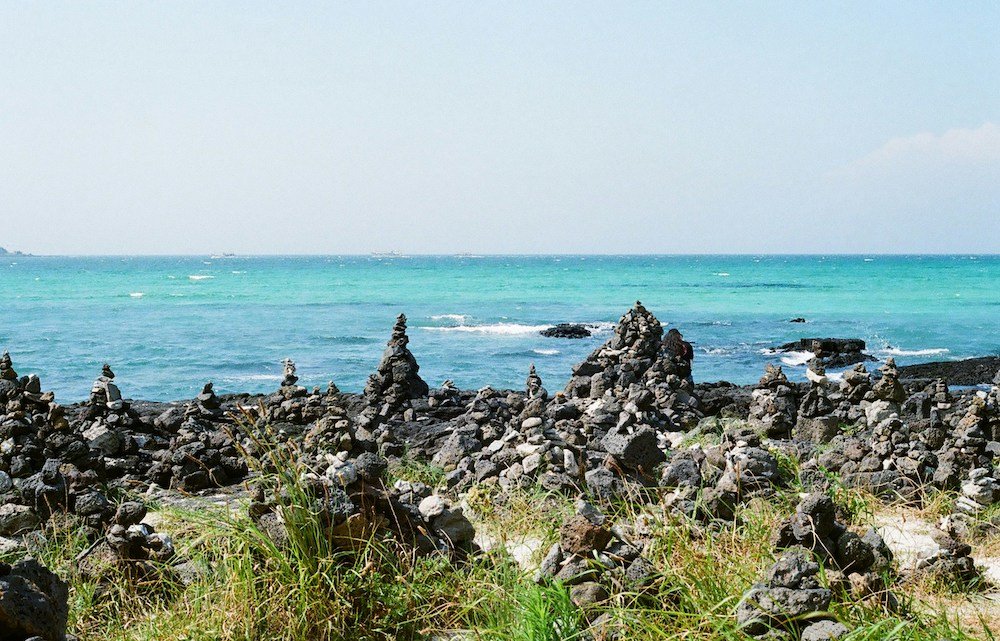
(Island Expert)
Christian is a dynamic serial entrepreneur and a licensed real estate agent with a relentless passion for unlocking the potential of island real estate.Christian's expertise extends beyond entrepreneurship and property transactions.He possesses a profound expertise in crafting captivating content and persuasive copywriting tailored exclusively to the enchanting realm of island real estate.
We're a licensed real estate marketplace, enabling island owners to rent and sell their private islands to a global audience seeking to buy, book a holiday, or hire a unique event venue.
Contact Us:
- [email protected]
- Island Buyers Guide
- List an Island for Sale
- Book an Island Holiday
- Plan an Island Event
- Privacy Policy
- Terms & Conditions
Destinations
- Central America
- South America
- South Pacific
- United States
Subscribe to Our Newsletter
To stay informed and be the first to know about our latest updates and exclusive offers, be sure to subscribe to our newsletter.
© 2024. All rights reserved. Isle Keys Pty Ltd.
Thanks for your enquiry.
Check your email shortly for the ebook download link.
Download Island Buyers Guide Ebook
Please fill in your details below and we will send you this ebook via email
Email Address
Phone Number
The Best Time to Visit Jeju Island, South Korea for Weather, Safety, & Tourism
The best times to visit Jeju Island for ideal weather are
April 9th to July 1st
based on average temperature and humidity from NOAA (the National Oceanic and Atmospheric Administration). Read below for more weather and travel details.
Jeju Island Travel Guide
Temperature.
- Perceived Temperature
- Rain and snow
- Humidity and wind
- The busiest and least popular months
- Overall travel experience by time of year
Other Jeju Island Travel Info
Weather in jeju island.
Average temperatures in Jeju Island vary drastically. Considering humidity, temperatures feel nice most of the year, excluding some cold weeks in the winter, with a chance of rain or snow throughout most of the year. The area is less temperate than some — in the 34th percentile for pleasant weather — compared to tourist destinations worldwide. Weeks with ideal weather are listed above . If you’re looking for the very warmest time to visit Jeju Island, the hottest months are August, July, and then September. See average monthly temperatures below. The warmest time of year is generally early August where highs are regularly around 87.9°F (31.1°C) with temperatures rarely dropping below 77.9°F (25.5°C) at night.
Jeju Island Temperatures (Fahrenheit)
Jeju island temperatures (celsius), “feels-like” temperatures.
The way we experience weather isn’t all about temperature. Higher temperatures affect us much more at higher humidity, and colder temperatures feel piercing with high winds. Our perceived temperatures factor in humidity and wind chill to better represent how hot or cold the day feels to a person.
Jeju Island Perceived Temperature (F)
Jeju island perceived temperature (c), average jeju island temperatures by month.
Daily highs (averaged for the month) usually give the best indication of the weather. A significantly lower mean and low generally just means it gets colder at night.
Show Fahrenheit
Show celsius, precipitation (rain or snow).
If dry weather is what you’re after, the months with the lowest chance of significant precipitation in Jeju Island are October, January, and then May. Note that we define “significant precipitation” as .1 inches or more in this section. The lowest chance of rain or snow occurs around mid October. For example, on the week of October 15th there are no days of precipitation on average. By contrast, it’s most likely to rain or snow in late June with an average of 3 days of significant precipitation the week of June 25th.
Chance of Precipitation
The graph below shows the % chance of rainy and snowy days in Jeju Island.
Snow on the Ground
The graph below shows the average snow on the ground in Jeju Island (in).
Average Rain and Snow by Month
Show inches, show centimeters, humidity and wind.
Jeju Island has some very humid months, with other comfortably humid months. The least humid month is March (51.1% relative humidity), and the most humid month is June (72.9%).
Wind in Jeju Island is usually calm . The windiest month is December, followed by January and March. December’s average wind speed of around 8.5 knots (9.8 MPH or 15.8 KPH) is considered “a gentle breeze.” Maximum sustained winds (the highest speed for the day lasting more than a few moments) are at their highest in late December where average top sustained speeds reach 12.8 knots, which is considered a moderate breeze.
Relative Humidity (%)
The graph below shows the average % humidity by month in Jeju Island.
The graph below shows wind speed (max and average) in knots.
Average Wind Speeds
Show wind speeds.
All wind speeds are in knots. 1 knot = 1.15 MPH or 1.85 KPH.
Show Relative Humidity by Month
Is it safe to travel to jeju island.
Our best data indicates this area is generally safe. As of Dec 04, 2023 there are no travel advisories or warnings for South Korea; exercise normal security precautions. Check this page for any recent changes or regions to avoid: Travel Advice and Advisories . This advisory was last updated on Oct 30, 2023.
The Busiest and Least Crowded Months
The busiest month for tourism in Jeju Island, South Korea is January, followed by May and April. Prices for hotels and flights will be most expensive during these months, though you can save if you purchase well in advance. Tourists are unlikely to visit Jeju Island in December. Those willing to visit at these times will likely find it the least expensive month.
Estimated Tourism by Month
Most popular months to visit, overall jeju island travel experience by season, spring (march through may).
Humidity and temperatures combine to make this season feel moderate. Highs range from 73.5°F (23.1°C) and 51.5°F (10.8°C) with warmer temperatures in the later months. Rain is somewhat common with 6 to 7 days of significant precipitation per month. Spring is the busiest for tourism, which makes it a good time for those looking for things to do.
Summer (June through August)
The middle-year months have very comfortable weather with high temperatures that are comfortable. These months see the most precipitation with 7 to 9 days of precipitation per month. June – August is fairly slow season for tourism in Jeju Island, so lodging and other accommodations may cost slightly less.
Fall (September through November)
Fall daily highs range from 80.1°F (26.7°C) and 57.2°F (14°C), which will feel very nice given the humidity and wind. It rains or snows a significant amount: 4 to 7 days per month. Tourism is the slowest during these months due to the weather, so hotels may be affordably priced.
Winter (December through February)
Weather is too cold this time of year in Jeju Island to be enjoyable for warm weather travelers. The average high during this season is between 53.3°F (11.8°C) and 45.7°F (7.6°C). On average, it rains or snows a fair amount: 5 to 7 times per month. These times of year are the second busiest with tourists.
Best Times to Travel › South Korea › Jeju Island, South Korea
Similar Destinations
- Jeju City, South Korea
- Jeju, South Korea
- Aewol, South Korea
- Jocheon, South Korea
- Seogwipo City, South Korea
- Jungmun, South Korea
- Seogwipo, South Korea
- Hallim, South Korea
- Pyoseon, South Korea
- Andeok, South Korea
Popular Destinations
- Cha-am, Thailand
- New York, NY, US
- Madrid, Spain

Best time to visit Jeju , South Korea
Our verdict
The best time to visit Jeju is May
In the height of summer, temperatures in Jeju can reach a maximum of 29℃ (85℉). In the winter, temperatures can get down to 1℃ (34℉) around January.
The days are longest in Jeju in May, so if you want to see the sights during the day when the sun is up for the longest time, it’s best to visit around that time of year. You don’t want to get wet on your holiday, do you? Well if you’re trying to avoid the rain, then steer clear of Jeju in August. Head over there in January instead if you want to increase your chances of not being rained on.
If you want to learn everything you need to know about the best times to travel to Jeju, the weather and stats by month and so much more, make sure you keep reading. Once you’re ready, we’ve included a bunch of our favourite online booking tools to help you find the best deals on flights, accommodation and anything else you’ll need for your trip. Happy reading!
Quick links: Fast facts / Seasons / Average temperatures / Monthly climate / FAQs / Map
Warmest month
Least rainfall, most daylight, check your travel options, need a place to stay.
*Support us by clicking the links above and making a booking with our partners. It's completely free for you, and it helps us make this site even more awesome! We'll <3 you for it.
ADVERTISEMENT
Jeju seasons
Before you continue, it’s important to know when the seasons are in Jeju as they might be different to yours depending on where in the world you’re travelling from. Jeju is in the Northern Hemisphere, so the seasons fall during these months:
Average temperatures in Jeju
If the temperature is a big factor for you to help you decide when to visit, the chart below shows the average minimum and maximum temperatures in Jeju for each month side-by-side so you can easily see the difference in weather throughout the year. To see the temperatures in both Celsius (°C) and Fahrenheit (°F), hover or tap the shaded boxes on the graph.
Jeju climate by month
If you already have a rough idea about which months you might want to travel, the section below shows a detailed breakdown of the climate in Jeju for each month so you can see if it all suits your wants and needs. Scroll down, or use the quick menu below to jump to your preferred month.
Jeju in January
- Average temperature: 6℃ (42℉)
- Average high temperature: 7℃ (45℉)
- Average low temperature: 4℃ (40℉)
- Average humidity: 71%
- Average sunny days: 12 days
- Average rainfall: 42mm (2") over 11 days
- Average snow days: 5 days
What to pack: If you’re heading to Jeju in January, make sure you pack a thick snow/winter jacket, thermals and some extra layers as it's always very cold.
Add visitor or local insider tips >
Jeju in February
- Average temperature: 7℃ (44℉)
- Average high temperature: 8℃ (47℉)
- Average low temperature: 5℃ (41℉)
- Average humidity: 70%
- Average rainfall: 46mm (2") over 11 days
- Average snow days: 3 days
What to pack: If you’re heading to Jeju in February, make sure you pack a warm jacket or coat.
Jeju in March
- Average temperature: 9℃ (49℉)
- Average high temperature: 11℃ (52℉)
- Average low temperature: 7℃ (45℉)
- Average humidity: 68%
- Average sunny days: 17 days
- Average rainfall: 52mm (2") over 12 days
What to pack: If you’re heading to Jeju in March, make sure you pack a warm jacket or coat.
Jeju in April
- Average temperature: 13℃ (56℉)
- Average high temperature: 15℃ (58℉)
- Average low temperature: 11℃ (52℉)
- Average rainfall: 68mm (3") over 11 days
What to pack: If you’re heading to Jeju in April, make sure you pack a warm jacket or coat.
Jeju in May
- Average temperature: 17℃ (63℉)
- Average high temperature: 19℃ (66℉)
- Average low temperature: 16℃ (60℉)
- Average humidity: 75%
- Average sunny days: 20 days
- Average rainfall: 63mm (2") over 9 days
What to pack: If you’re heading to Jeju in May, make sure you pack a light jumper or hoodie.
Jeju in June
- Average temperature: 21℃ (69℉)
- Average high temperature: 22℃ (71℉)
- Average low temperature: 20℃ (67℉)
- Average humidity: 83%
- Average sunny days: 16 days
- Average rainfall: 81mm (3") over 13 days
What to pack: If you’re heading to Jeju in June, make sure you pack a light jumper or hoodie for the evenings and some light clothes for the daytime.
Jeju in July
- Average temperature: 25℃ (77℉)
- Average high temperature: 26℃ (79℉)
- Average low temperature: 24℃ (75℉)
- Average humidity: 86%
- Average sunny days: 15 days
- Average rainfall: 122mm (5") over 15 days
What to pack: If you’re heading to Jeju in July, make sure you pack t-shirts and light clothing.
Jeju in August
- Average temperature: 27℃ (80℉)
- Average high temperature: 28℃ (82℉)
- Average low temperature: 25℃ (77℉)
- Average humidity: 81%
- Average sunny days: 13 days
- Average rainfall: 129mm (5") over 15 days
What to pack: If you’re heading to Jeju in August, make sure you pack t-shirts and light clothing.
Jeju in September
- Average temperature: 23℃ (74℉)
- Average high temperature: 24℃ (76℉)
- Average low temperature: 22℃ (71℉)
- Average humidity: 76%
- Average rainfall: 111mm (4") over 14 days
What to pack: If you’re heading to Jeju in September, make sure you pack t-shirts and light clothing.
Jeju in October
- Average temperature: 19℃ (66℉)
- Average high temperature: 20℃ (68℉)
- Average low temperature: 18℃ (64℉)
- Average humidity: 69%
- Average rainfall: 99mm (4") over 12 days
What to pack: If you’re heading to Jeju in October, make sure you pack a light jumper or hoodie for the evenings and some light clothes for the daytime.
Jeju in November
- Average temperature: 14℃ (56℉)
- Average high temperature: 15℃ (59℉)
- Average low temperature: 12℃ (54℉)
- Average rainfall: 44mm (2") over 14 days
What to pack: If you’re heading to Jeju in November, make sure you pack a light jumper or hoodie.
Jeju in December
- Average temperature: 8℃ (46℉)
- Average high temperature: 9℃ (49℉)
- Average low temperature: 6℃ (43℉)
- Average sunny days: 10 days
- Average rainfall: 46mm (2") over 15 days
- Average snow days: 2 days
What to pack: If you’re heading to Jeju in December, make sure you pack a warm jacket or coat.
😎 When should I go to Jeju for the hottest weather?
☀ when does it rain the least in jeju, ☔ when does it rain the most in jeju, 🌤 when should i go to jeju if i want the most daylight.
Explore more destinations near Jeju
- Best time to visit Busan
- Best time to visit Incheon
- Best time to visit Seoul
Explore nearby
Trending destinations
- Guadalajara, Mexico
- Ensenada, Mexico
- Las Palmas, Gran Canaria
- Aberdeen, Scotland
- Sao Paulo, Brazil
- Marseille, France
- Brighton, UK
- Pattaya, Thailand
- Punta Arenas, Chile
- Gold Coast, Australia

Need a hotel in Jeju?
Find hotels and stays for any budget in Jeju with our partners, Booking.com !

6 Best places to visit when traveling in South Korea
S outh Korea's rich history, breathtaking landscapes, and rich culture are a traveler's paradise. Each destination oofers a distinct blend of attractions, activities, and culinary treats, guaranteeing the perfect adventure for all travel buffs.
Thanks to the country's myriad of travel experiences, from Seoul's dynamic city life to Jeju Island's serene natural beauty, South Korea is an enigmatic Pandora's box for most travel enthusiasts.
Whether it is scouring the bustling markets, hiking in panoramic national parks, or immersing in the classic Korean traditions and arts, with its modern cities, ancient temples, and delicious cuisine, this destination promises an unforgettable and fable-like trip.
Note: This is purely the writer's opinion. We might have missed a few destinations; let us know your opinion.
6 Best places to visit in South Korea
To make the visitors to South Korea comfortable, Korean is the predominant language, and many locals in tourism communicate in English.
Ahead, Team Sportskeeda has made a curated list of the six best places to visit in South Korea while providing detailed insights into each destination.
- Jeju Island
Seoul, South Korea 's capital, is a mesmerizing mix of modern skyscrapers and ancient palaces. The best time to visit this dynamic metropolis is during the spring and autumn when the weather is pleasant.
Must-visit attractions include Gyeongbokgung Palace, N Seoul Tower, and Bukchon Hanok Village, where travelers can enjoy traditional tea ceremonies, vibrant nightlife, and shopping in neighborhoods like Myeongdong.
There are plenty of options for lodging, from opulent hotels to comfortable homestays, in addition to savoring regional delicacies like bibimbap, kimchi, and Korean BBQ.
Nearest airport: Incheon International Airport
2) Jeju Island
Jeju Island, designated as a UNESCO World Heritage Site, is celebrated for its stunning natural landscapes. The best time to explore this picturesque South Korean locale is from April to June, adorned with blooming wildflowers.
Once here, avid travelers can explore local attractions like Hallasan National Park, Seongsan Ilchulbong Peak, and Manjanggul Cave, which offer exceptional experiences for nature lovers.
Jeju Island caters to many accommodation options, from upscale resorts to budget-friendly guesthouses. Further, tasting Jeju's local delicacies, like fresh seafood, black pork, and hallabong oranges , is a must for all travel buffs.
Nearest airport: Jeju International Airport
Read more: 7 Best things to do in Japan in 2024
Busan, South Korea's second-largest city, a blend of modernity and coastal beauty, is famous for its beach activities and delectable seafood. The best time to visit is during the summer for beach recreation and the Busan International Film Festival in October.
Heritage sites along the coast, such as Gamcheon Culture Village, Beomeosa Temple, and Haeundae Beach, are among the city's must-see atractions.
Further, from enjoying comfortable stays in boutique hotels to beach shacks, adventurous souls can dig into Busan's dishes like dwaeji gukbap (pork soup) and milmyeon (wheat noodles).
Nearest airport: Gimhae International Airport
4) Gyeongju
Gyeongju is a South Korean city steeped in historical sites and cultures known as the Museum without Walls.' Spring and autumn are the best times to visit. The traveler can explore the attractions surrounding the vicinity like Bulguksa Temple, Seokguram Grotto, and the UNESCO-listed Gyeongju Historic Areas. For rest and recoup, they can stay at traditional hanok-style stays in modern hotels and inns while indulging in Gyeongju bread and haejangguk (hangover soup) for a delightful culinary experience.
Nearest airport: Gimhae International Airport in Busan
Read more: 7 Best things to do when visiting Dubai
Andong, nestled in the middle of Gyeongsangbuk-do province and known to be a haven for cultural enthusiasts, is a must-visit place, especially during the Andong Mask Dance Festival in September and the Andong International Folk Festival in October.
Once here, they can explore the Hahoe Folk Village, Andong Confucian School, and Byeongsanseowon Confucian Academy while cooling their heels at the trendy hotels, cozy homestays, or roadside motels. They can indulge in Andong's local cuisine, including Andong jjimdak (braised chicken ) and heotjesabap (lotus leaf rice) for gastronomic delights.
Further, there is no major airport in Andong, and adventure lovers can access the city via transit from nearby areas.
Nearest airport: NA
Yet another home on the UNESCO list, South Korea's Suwon, is an amalgamation of tradition and modernity. Courtesy of the ancient Hwaseong Fortress and the thriving local markets, Suwon acts like a magnet to most adventure love. Autumn and winter are the right time to visit this place. Suwon offers various lodging preferences, from business hotels to cozy guesthouses.
Further, Suwon's local goodies, like dakgalbi (spicy stir-fried chicken) and Suwon galbi (marinated beef ribs), are the authentic gastronomic delights.
Read more: 6 Best European countries to visit in Summer 2024
Whether the reader is a travel enthusiast, a history buff, a nature lover, or a food critic, any of these six places to visit in South Korea is a platter full of surprises for all.
So, without much dilly-dallying, they can initiate their South Korean tour with their boarding passes and backpacks ready to go!
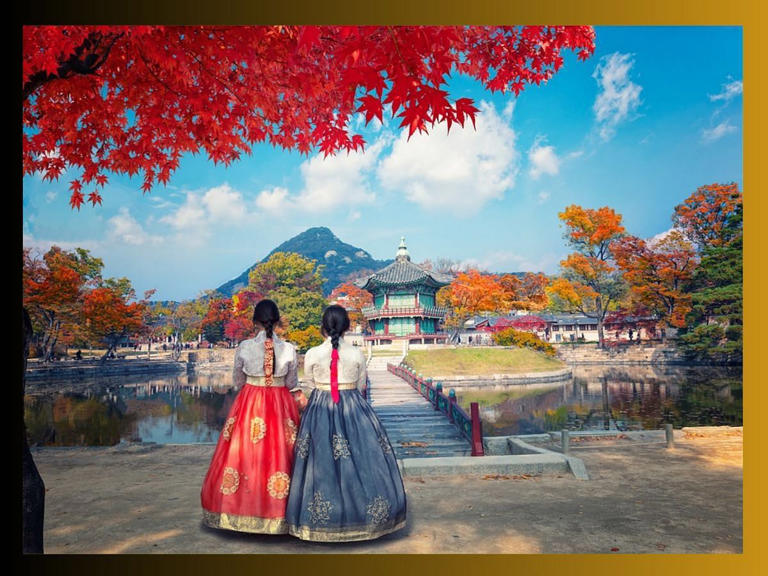

IMAGES
VIDEO
COMMENTS
Summarising the best time to visit Jeju Island. Jeju Island is a popular tourist destination known for its beautiful beaches, stunning natural landscapes, great food and rich cultural heritage. The article looked at when is the best time to visit Jeju Island and discussed the weather and climate of Jeju Island, the peak and off-peak tourist ...
The fall months between September and November are a special time to visit the island. But like spring, your trip will depend on the precise time during the season that you come. The weather in September in Jeju is hot, albeit cooler than in the summer months. By November, there are days at the end of the month when it feels noticeably colder ...
Jeju Itinerary Day 1. 9am // Manjanggul: If you're traveling by bus, skip to the next stop, as you won't have time for this part. Start out the day at the lava caves, a kilometer of dark, firey history, and a look into how the island was formed. You can only explore the first 1000 meters of the more than 13,000 formed.
The best time to see flowers is usually mid-March to early April - making this period one of the most popular times to visit. At the very end of March or beginning of April, cherry blossom season starts and usually lasts for around 10 days. Jeju is the first place in South Korea where blossoms appear, and so Jeju Cherry Blossom Festival has a ...
From September to November is the autumn season at the famous Jeju island. The average temperature during this season is between 20 to 25 degrees. However, near the end of November, the weather starts turning cold, supported by little rain and dry air. Jeju Island during autumn season.
The best times to visit Jeju Island are during the shoulder seasons of spring (March-May) and autumn (September-November), when temperatures are cooler and ideal for trekking and taking in the stunning autumn foliage and flowers of the island. The off-peak season is winter, which runs from December to February.
Morning (2-4 hours): East Jeju Island. 1. Seongsan Ilchulbong aka Sunrise Peak. Entrance: Free to hike on the left side, 5,000 won or $4 USD to hike on the right side. Hiking Seongsan Ilchulbong aka Sunrise Peak is in the top 5 things to do in Jeju Island, and a main attraction in the East Coast.
The best time to visit Jeju island is from April to June and September to October. April to June is the end of spring and early summer. The weather is warm but still dry with little rainfall. Traveling to Jeju at this time, you will have the opportunity to stroll around and see the beautiful cherry blossoms or attend the vibrant spring festival.
The best times to visit Jeju for ideal weather are. April 9th to July 1st. based on average temperature and humidity from NOAA ... If you're looking for the very warmest time to visit Jeju, the hottest months are August, July, and then September. See average monthly temperatures below. The warmest time of year is generally early August where ...
The best time to visit Jeju Island is during spring and autumn, from April to June and September to November. These seasons offer mild temperatures, ranging from 10°C to 20°C (50°F to 68°F), perfect for outdoor adventures like hiking and beach activities. In spring, the island blooms with colourful cherry blossoms, while autumn brings ...
Spring is the most beautiful time of the year for most places and Jeju is no exception. The popular cherry blossoms that attracts thousands of tourists every year, can also be found here. In fact, Jeju Island may be a better place for viewing these lovely flowers away from the tourist crowd in Seoul! Blooming period: Mid - End March.
Jeju City. Visit Neulbom Heukdwaeji in Jeju City for black-pork barbecue. Be sure to go someplace where the pork is not overly greasy. It was great here, however, the staff tries to cook for you and hurry you. Be persistent, insist on cooking it yourself, and take your time. Dae Hyang in Jeju City has some of the best Korean barbecue meat you ...
South Korea, Asia. Jeju-do (제주도), Korea's largest island, has long been the country's favourite domestic holiday destination thanks to its beautiful beaches, lush countryside and seaside hotels designed for rest and relaxation. 01 / Attractions.
One of the best places to visit in Jeju Island for a history lesson is Jeju Folk Village. Travel back in time to Korea in the 1890s to experience the lifestyle of Koreans in this cultural village featuring more than 100 traditional houses over four different areas - Mountain Village, Hill-country Village, Fishing Village, and Shamanism Village.
Best time to visit Jeju Island. Mid-March to early April is one of the best times to visit Jeju with cherry blossom, azaleas and magnolias in bloom. May and June offer pleasant weather but July and August are hot, humid and wet. Temperatures drop by September and November sees added interest with the autumnal foliage. Although cold, November to ...
When is the Best Time to Visit Jeju Island, South Korea. Jeju Island, like the rest of South Korea, has 4 very distinct seasons: fresh Spring, hot Summer, cool Autumn and cold Winter. Summer is the busiest time to visit Jeju thanks to Summer vacations while Winter is the least popular time to visit thanks to the harsh temperatures.
Spring is undoubtedly one of the best times to visit Jeju Island. From March to May, the island comes alive with vibrant cherry blossoms and colorful flower fields, creating a picturesque backdrop for your adventures. The temperature during this time ranges from a pleasant 10°C to 20°C (50°F to 68°F), making it perfect for outdoor ...
The best time to visit Jeju is Mid-March to early April as the weather will be mild. The seasons of Jeju are: Spring: April - May: Temperatures are pleasant in the daytime and relatively low at night. Average low temperatures in April are 10.2 degrees Celsius. Average high temperatures in May are 21.6 degrees Celsius.
Very low season in Jeju Island (Jejudo) The months with the lowest number of tourists are: January, February and March. Low season in Jeju Island (Jejudo) The months with low numbers of tourists are: December. High season in Jeju Island (Jejudo) The number of visitors to Jeju Island (Jejudo) is high in: April, May, June, July, September and ...
Want to discover when is the best time to visit Jeju Island in South Korea? Nestled off the southern coast of South Korea, Jeju Island emerges as a gem in the vast expanse of the Pacific Ocean. Known for its volcanic landscape, lush greenery, and pristine beaches, Jeju Island offers a sanctuary for nature lovers and adventure seekers alike.
Weeks with ideal weather are listed above. If you're looking for the very warmest time to visit Jeju Island, the hottest months are August, July, and then September. See average monthly temperatures below. The warmest time of year is generally early August where highs are regularly around 87.9°F (31.1°C) with temperatures rarely dropping ...
In the height of summer, temperatures in Jeju can reach a maximum of 29℃ (85℉). In the winter, temperatures can get down to 1℃ (34℉) around January. The days are longest in Jeju in May, so if you want to see the sights during the day when the sun is up for the longest time, it's best to visit around that time of year.
dakgalbi galbi. Nearest airport: Read more: 6 Best European countries to visit in Summer 2024. South Korea's rich history, breathtaking landscapes, and rich culture are a traveler's paradise.
April 24, 2024. Vincent Leroux/Raffles Al Areen Palace Bahrain. It's inevitable: Every spring when we pull together the Hot List, our annual collection of the world's best new hotels ...